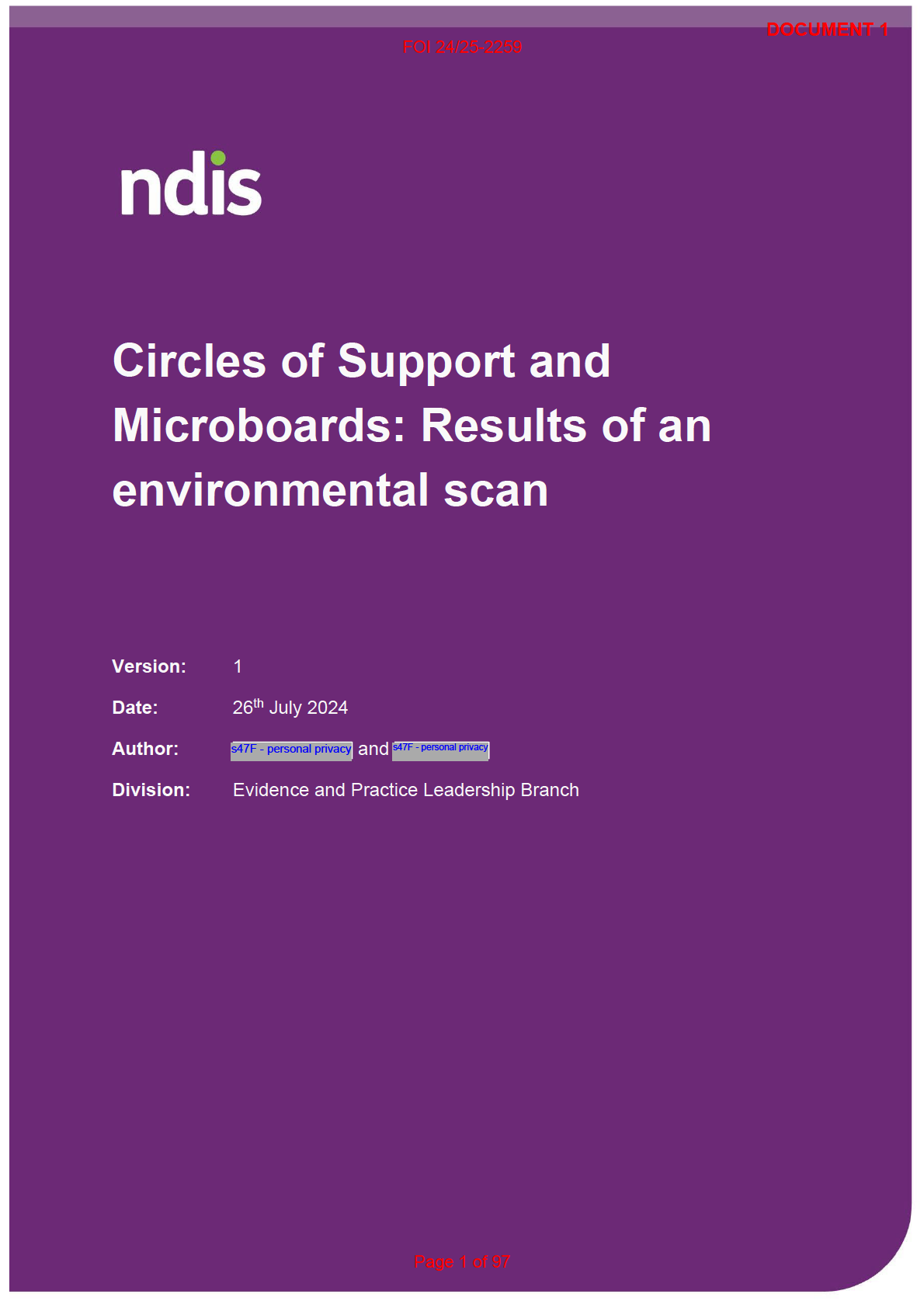
FOI 24/25-2259
Contents
Circles of Support and Microboards: Results of an environmental scan
1
Contents
2
Disclaimer
5
Acknowledgements
5
Suggested Citation
5
Abbreviations
6
Glossary
6
1. Executive Summary
7
2. Background and NDIS context
9
3. What we did
10
3.1
Data collection
11
4. Key findings
11
4.1
Circles of Support
11
4.1.1
Aims of CoS.
12
4.1.2
The target population for CoS.
12
4.1.3
Key components of a CoS.
13
4.1.4
How providers support the formation of a CoS.
14
4.1.5
Time required to set-up a CoS.
14
4.1.6
Costs for CoS
14
4.1.7
How CoS providers function and who runs them.
15
4.2
Microboards
15
4.2.1
Aim of Microboards
16
4.2.2
Target population of Microboards
16
4.2.3
Key components of Microboards
17
4.2.4
How providers support the formation of Microboards.
17
4.2.5
Legal responsibilities
18
4.2.6
Time required to set up Microboards.
18
4.2.7
Costs for Microboards.
19
4.2.8
Hiring employees.
19
ndis.gov.au
12 July 2024 | Circles of Support and Microboards
2
Page 2 of 97
OFFICIAL: SENSITIVE
FOI 24/25-2259
4.2.9
How Microboard providers function and who runs them.
20
4.3
Findings relevant to both Circles of Support and Microboards
20
4.3.1
How CoSAM ensure they provide supported decision-making
21
4.3.2
Challenge to provide supported decision-making
23
4.3.3
Working with third parties.
24
4.3.4
Facilitation for CoSAM.
24
1. Initiating the Process
25
1.1.1
Cost of facilitators
27
1.1.2
Safeguarding provided by CoSAM.
27
1.1.3
Sustainability.
28
1.1.4
Considerations for CALD and Aboriginal and Torres Strait Islander
people 29
1.1.5
Challenges experienced by CoSAM providers.
30
2. Microboards versus Circles of support
32
3. Outcomes for Circles of support and Microboards
33
3.1
Benefits of Circles of Support
33
Supported decision-making.
33
Oversight.
34
Support and respect.
34
3.2
Quantitative data
35
3.3
Risks of Circles of Support
38
Substituted decision-making and who is responsible.
38
PwD may not want a CoS.
38
Lack of commitment from members of CoS
38
3.4
Benefits of Microboards
39
Supported decision-making
39
Benefit people of all ages
39
Additional support
39
Safeguarding
40
3.5
Risks of Microboards
40
Substituted decision-making
40
ndis.gov.au
12 July 2024 | Circles of Support and Microboards
3
Page 3 of 97
OFFICIAL: SENSITIVE
FOI 24/25-2259
PwD not wanting a Microboard or able to choose members
41
Members exploit their position
41
Legal ambiguity
41
3.6
Quantitative findings on Microboards
41
4. Barriers and enablers to setting up and maintaining Circles of support and
Microboards.
43
4.1
Barriers for Circles of Support
43
4.2
Enablers for Circles of Support
44
4.3
Barriers for Microboards
44
4.4
Enablers for Microboards
44
5. Summary of key findings
45
5.1.1
Funding considerations
46
5.1.2
Establishing a CoSAM
51
5.1.3
Implementing CoSAM
53
6. Limitations of this evidence
58
7. Strength of evidence
58
8. Research gaps
59
9. Next steps
59
10. Appendix
61
11. References
95
National Disability Insurance Agency
97
ndis.gov.au
12 July 2024 | Circles of Support and Microboards
4
Page 4 of 97
OFFICIAL: SENSITIVE
FOI 24/25-2259
Disclaimer
The NDIA accepts no responsibility for the accuracy or completeness of any material
contained in this report. Further, the National Disability Insurance Agency disclaims
all liability to any person in respect of anything, and of the consequences of anything,
done or not done by any such person in reliance, whether wholly or partly, upon any
information presented in this report.
Views and recommendations of third parties in this report, do not necessarily reflect
the views of the NDIA, or indicate a commitment to a particular course of action.
However, this report may inform the implementation of home and living policies in
the National Disability Insurance Scheme (NDIS).
Acknowledgements
The NDIA acknowledge the Traditional Owners and Custodians throughout Australia
and their continuing connection to the many lands, seas, and communities. The
NDIA pay respect to Elders past and present and extends this to any Aboriginal and
Torres Strait Islander people who may be reading this Report.
Suggested Citation
National Disability Insurance Agency 2024. An Evidence Snapshot of Circles of
Support and Microboards. Prepared by Evidence and Practice Leadership Branch.
ndis.gov.au
12 July 2024 | Circles of Support and Microboards
5
Page 5 of 97
OFFICIAL: SENSITIVE
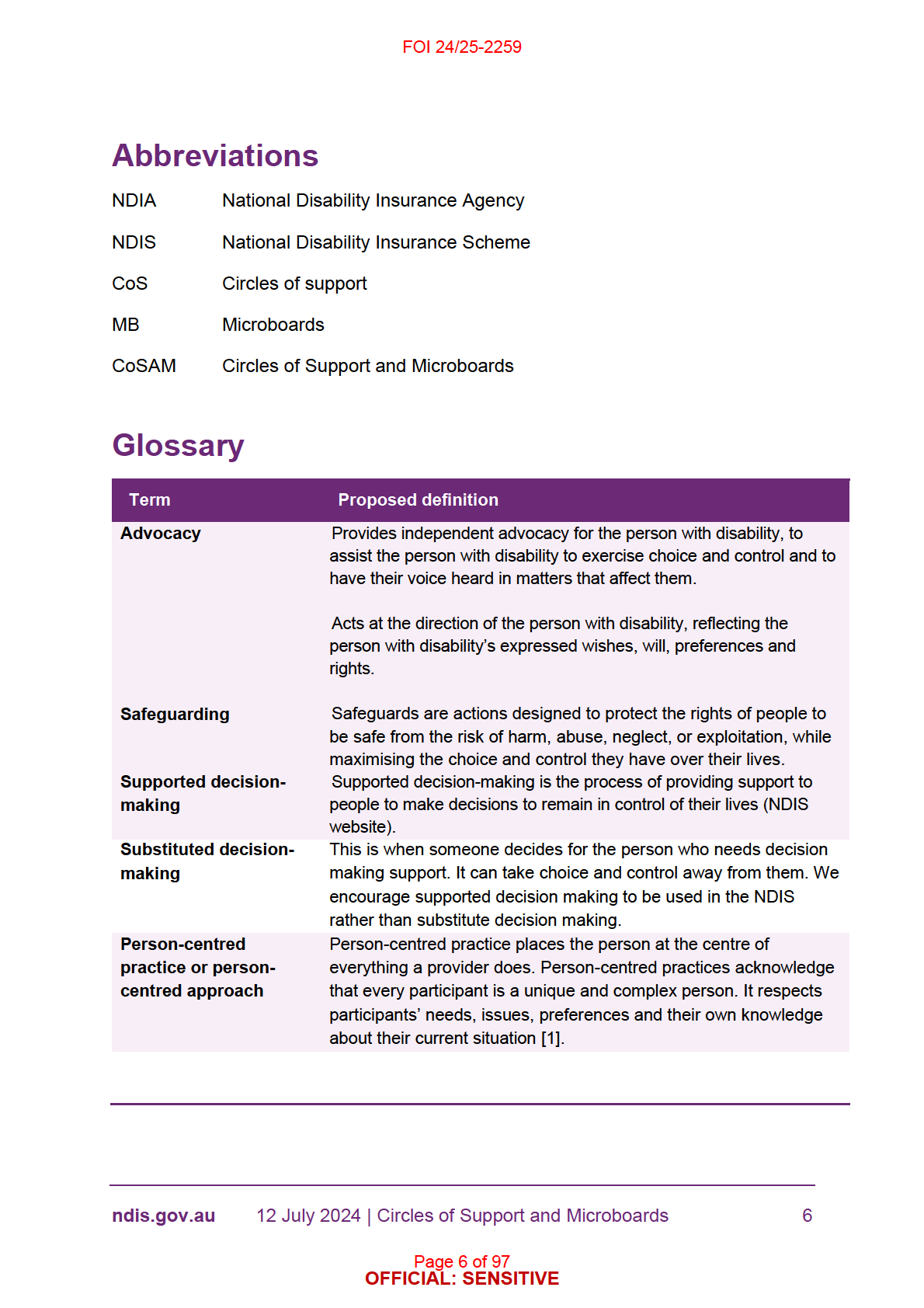
FOI 24/25-2259
1. Executive Summary
This report provides an in-depth exploration of Circles of Support (CoS) and
Microboards (CoSAM) that aim to provide supported decision-making, promote
social inclusion and safeguarding to people with disabilities (PwD). Generally the
goals of the CoSAM are aspirational, such as empowering the individual to have
control over their life and to maximise their independence. Members include a
committed group of trusted and known individuals such as family members, friends,
peers, mentors, and professionals.
Microboards are similar to a Circle except they become a small, non-profit
organisation that is governed by members who become a board of directors.
Microboards may also take on the responsibility of employing support workers for the
PwD, purchasing property and opening bank accounts.
Key Findings:
Benefits: CoSAM facilitate supported-decision making, socialisation, advocacy, and
personalised support, enhancing quality of life for PwD. They provide safeguards
against abuse, promote self-determination, and offer continuity of support beyond
family involvement.
Risks: Challenges for CoSAM may include unintended impacts such as: unactioned
ideas or activities, financial abuse, substituted decision-making, lack of consent to
establish a CoSAM by PwD, employee complaints, and unclear legal responsibilities
for Microboard members.
Barriers: time commitment, NDIS funding, finding committed members,
administrative complexities, funding to establish and maintain CoSAM and
ambiguities regarding legal responsibilities.
Enablers: effective facilitation, a person-centred approach and collaborative efforts
among members.
Future Directions: Continued research and evaluation, including well-designed
evaluation studies with validated measures, cost-effectiveness analysis, and long-
term data (>2 years), are needed.
Limitations: Findings are constrained by low quality quantitative evidence, lack of
long-term data, potential reporting bias from providers, small sample sizes, and little
consideration of First Nations people and people with CALD backgrounds.
Page 7 of 97
FOI 24/25-2259
OFFICIAL: SENSITIVE
NDIS Policy and Review:
The NDIS policy on supported decision-making, recognises that “all participants,
including people with profound intellectual and multiple disability, have the right to
support to make or direct decisions that impact their lives”. And that “decision making
support may come from a person, or several people, in formal or informal ways that
include: Microboards; Circles of support; Network Facilitators; Decision Coaches”.
The NDIS review (2023) recommends the “National Disability Insurance Agency
should include an assessment of participants’ need for independent decision-making
support as part of budget setting and ensure participants can use their NDIS budgets
to access independent decision-making supports”.
Challenges and Considerations:
Providers who assist with the establishment of CoSAM emphasise that CoSAM go
beyond supported decision-making strategies; they offer a multitude of benefits,
including enabling PwD to lead enriched lives, facilitate meaningful employment,
maximise their independence, providing safeguarding and advocacy, establish
crucial social connections and assist with succession planning for when family
supporters age and die. Providers believe these outcomes are often unachievable
without the structured, committed support of a trusted group dedicated to assisting
and empowering the PwD. Whilst this finding is supported by interviews from PwD
and their carers, there are no studies that compare outcomes in people who have a
CoSAM compared with normal care with support from a support coordinator.
Establishing a CoSAM is not without risks. Providers and the NDIA need to ensure
CoSAM do not provide substituted decision-making or Microboards misuse NDIS
funds when paying for support-workers, tax advice and insurance. While paid
external facilitators can help provide oversight, they typically work with a CoSAM for
only 1-3 years, thus it is unclear who will take on this responsibility thereafter.
Funding for CoSAM supports could be deemed reasonable and necessary for
persons with intellectual disability, cognitive disability, communication issues or
complex needs. The choice between a CoS or Microboard is generally made with the
PwD, their family or carer in conjunction with a provider who can explain the pros
and cons of each. Providers are not registered by the NDIA, so The NDIS Quality
and Safeguards Commission may need to consider whether to amend this to
address the inequity of access for these supports for people with an Agency- funded
budget.
Funding for CoSAM is generally needed for 1 to 3 years, depending on whether the
PwD has existing supports and for Circle members, their confidence to function
ndis.gov.au
26th July 2024 | Circles of Support and Microboards
8
Page 8 of 97
OFFICIAL: SENSITIVE
FOI 24/25-2259
OFFICIAL: SENSITIVE
independently of a paid facilitator. Funding covers the cost of facilitators who help
establish CoS (average $3,800) and Microboards ($8,400 per year), and facilitate
meetings for CoS, for approximately 1 to 3 years ($4,000 to $10,000 per year).
These pricing arrangements would need to be considered by the Pricing Reference
Group.
Providers are not registered by the NDIA, so The NDIS Quality and Safeguards
Commission may need to consider whether to amend this to address the inequity of
access for CoSAM for people with an Agency-funded budget. Registering the
providers will also add more oversight to the industry, since they will be subject to
quality-standard audits.
The NDIA’s policy position may be best decided with the support of an advisory
panel who can deliberate on the evidence to produce evidence-based advice and
recommendations. This will create a structured and transparent decision-making
process, building trust and credibility in the decisions and recommendations,
especially where uncertainty exists.
2. Background and NDIS context
Supported decision-making is the concept that individuals with mental or intellectual
disabilities should have the ability to make decisions about their own lives with the
assistance of a supportive team. This approach promotes self-determination and
independence, contrasting with the guardianship model, where decisions are made
on behalf of the person [2].
According to the Australian Law Reform Commission (ALRC), "all persons who
require support in decision-making must be provided with access to the support
necessary for them to make, communicate and participate in decisions that affect
their lives” [3]. The Royal Commission into Violence, Abuse, Neglect, and
Exploitation of People with Disability (The Commission) has built on the ALRC's
findings, underscoring the importance of supported decision-making to ensure that
people with disabilities can make decisions for themselves with dignity and
autonomy [4].
From the NDIS perspective, the NDIS Act and NDIS Supported Decision-Making
Policy (2023) stipulates that “NDIS funding for supports such as network facilitation
and Microboards may be available if it is reasonable and necessary” [5].
Furthermore, the NDIS Review (2023) proposed that “participants should be allowed
ndis.gov.au
26th July 2024 | Circles of Support and Microboards
9
Page 9 of 97
OFFICIAL: SENSITIVE
FOI 24/25-2259
OFFICIAL: SENSITIVE
to use their NDIS budgets to establish decision-making support networks (such as
circles of support)” (Action 5.3) [6].
Circles of Support and Microboards (CoSAM) are designed to provide supported
decision-making to people with disability, to help them have live an enriched and
fulfilled life that includes social activities, choice and control over their decisions,
maximise their independence, good quality supports and fulfilling employment.
CoSAM typically consist of trusted and known family members, friends, peers,
mentors, and professionals.
CoSAM are used by people who have intellectual disabilities, cognitive disabilities,
communication issues or complex needs. These individuals can benefit greatly from
the additional support since many are socially isolated with few others involved in
their lives [7]. Providers of CoSAM will help identify potential members and may help
build new relationships if needed for those who do not have a strong social network.
Their social networks are small and dense, often comprised only of family members,
peers with intellectual disabilities and paid staff. Yet people with intellectual
disabilities report that neither families nor service providers understand the
significance of informal relationships and fail to provide the practical support
necessary to form and maintain such relationships. Various formal strategies to build
and maintain informal social networks for people with intellectual disabilities are
reported in the academic and grey literature.
In August 2023, a review submitted to the NDIS review committee by members of
the CoSAM Community of Practice in Australia, that includes Inclusion Melbourne,
Deakin University and Microboards Australia, described how CoSAM are funded, are
beneficial , can measure progress; can help access supports and provide
safeguarding [8]. Recommendations from the review focused on the need for NDIS
guidance on CoSAM; to set up a CoSAM advisory group; to acknowledge the
benefits of CoSAM and to fund them.
In 2024, the NDIA has received several requests for funding of CoSAM and is
currently developing policy and operational guidance for front line decision-making.
This evidence summary was undertaken to provide an updated review of the
available evidence (both research and practice -based) to help inform the NDIA’s
position on who they are best suited for, how they’re implemented, their benefits,
risks, barriers and enablers.
3. What we did
ndis.gov.au
26th July 2024 | Circles of Support and Microboards
10
Page 10 of 97
OFFICIAL: SENSITIVE
FOI 24/25-2259
OFFICIAL: SENSITIVE
This evidence summary addressed the following questions on CoS and Microboards:
1) What is the current state of evidence for CoS and Microboards for supported
decision-making?
2) What are the benefits and risks associated with these strategies for people
with disability, their family and/or carers?
3) What design features and implementation factors should be considered when
setting up and/or maintaining CoS and Microboards?
4) What are the enablers and barriers to setting up and ongoing implementation
of CoS and Microboards?
5) How can CoSAM providers build community connections and informal
supports for people who are isolated or have minimal existing supports?
This is the first phase of work, being led by the Research and Evaluation Branch, to
help inform the NDIA’s position on funding CoSAM.
3.1 Data collection
We conducted a grey literature search using Google and Google Scholar. We also
undertook a search of ERIC, PRO-QUEST, Trove and Analysis Policy Observatory.
The peer reviewed literature search included primary research and systematic
reviews. PsycINFO, Medline, CINAHL and EMBASE databases were searched..
One reviewer (LS) conducted semi-structured interviews
with seven
representatives
of CoSAM providers in Australia and Canada via on-line video conferencing
software, including: Belonging Matters, Life Assist, Imagine More, Community Living
Project, Microboard Australia, Vella Microboards Canada and Microboards Canada.
A meeting with NDIS trainee planners was also conducted to explore how they would
consider a request for CoSAM funding.
4. Key findings
We screened 551 academic literature records and 10 met the eligibility criteria. An
additional 14 reports were identified from the grey-literature that included
government reports, organisation reports and theses (Supplementary Material S1).
4.1 Circles of Support
This section of the evidence summary compares the key features of four Australian
providers that support the creation of Circles of Support (CoS): Belonging Matters,
ndis.gov.au
26th July 2024 | Circles of Support and Microboards
11
Page 11 of 97
OFFICIAL: SENSITIVE
FOI 24/25-2259
OFFICIAL: SENSITIVE
Life Assist, Imagine More, and Community Living Project. Information was gathered
from the providers' websites, published reports, and interviews with representatives
from Belonging Matters, Inclusion Melbourne, Imagine More, and Community Living
Project.
4.1.1 Aims of CoS.
The aims of CoS are to:
1.
Empower the PwD to live a fulfilling life: enable PwD to have the same
opportunities in life as other people in the community, and to ensure their lives
are fulfilling, unique, socially inclusive, and empowering
2.
Provide structure to existing supports: enable existing informal supports to
help the individual and their family achieve their goals by providing structure
and formal processes.
3.
Long-term support: to co-design a succession plan for when family are no
longer able to and to provide a sustainable network of support over the
individual’s life time
4.
Help PwD form deeper relationships: to help the PwD expand their contacts,
associations and connections.
5.
Provide opportunities for social activities: CoS can help provide social
supports and social opportunities for the PwD.
Interviews with providers revealed that the goals of CoS should be aspirational,
helping individuals with disabilities envision what is possible in their lives (Belonging
Matters, Imagine More). The purpose of a CoS is not to default to ‘easy’ options like
segregated employment or group home living, but to assist individuals in achieving a
full, meaningful, and inclusive life. This includes securing open-market employment,
pursuing interests and hobbies, or living independently (Belonging Matters). For
example, if a PwD prefers to stay in segregated employment because their friends
are there, the CoS should help them understand their options and explore what
fulfilling employment could look like (Belonging Matters).
“People with intellectual disability are so vulnerable to services and the impact of
systems just taking over their life and saying, you know what this would be so much
easier if you went to a day program and you lived in a group home. You know? So
really the circle with a mechanism to safeguard people's vision but also bring other
people into their life” (Director, Belonging Matters).
4.1.2 The target population for CoS.
CoS are designed to assist people with disabilities, particularly those with intellectual
disabilities and autism. Some providers, like Life Assist, have eligibility criteria for
ndis.gov.au
26th July 2024 | Circles of Support and Microboards
12
Page 12 of 97
OFFICIAL: SENSITIVE
FOI 24/25-2259
OFFICIAL: SENSITIVE
setting up a CoS, working only with individuals who already have existing networks.
Others, such as Belonging Matters and Imagine More, believe that everyone has a
network that can be discovered and engaged with time and effort. For individuals
without a network, facilitators at the Community Living Project enlist other support
workers to help establish one.
Inclusion Melbourne expresses concerns about excluding those without existing
networks “it means that those [who] are less privileged … are more disenfranchised,
would struggle” (Head of Policy, Research, and Advocacy, Inclusion Melbourne).
Most PwD who are creating a CoS will need some level of assistance with their
decision-making. However, providers like Belonging Matters and Imagine More do
not assess this need or use it as an eligibility criterion. Belonging Matters requires
that PwD have “a vision for a good life. They need to want it. If they don't want that,
then there are a million other providers that can help them with segregated care, so
we just leave that to other providers to do” (Facilitator, Belonging Matters).
CoS are also crucial for individuals whose parents are elderly and may soon pass
away, as they ensure continuity of care and support, “You know that there are a
group of people around the person who are unpaid to safeguard them when families
are no longer here” (Facilitator, Belonging Matters).
CoS are promoted for young people, especially when they’re attending school. CoS
may involve recruiting school friends to join, potentially holding meetings at school to
facilitate support during school hours and provide opportunities for social activities
for the PwD.
4.1.3 Key components of a CoS.
• Circles of Support include members familiar with the PwD, such as family,
school friends, neighbours, and service providers.
• The PwD actively participates in selecting CoS members.
• Meetings are held regularly, typically every six weeks, often at the PwD’s
home.
• Facilitators are crucial for CoS success:
• They ensure the PwD’s goals are aspirational.
• They involve the PwD in decision-making.
• They encourage active participation from members inside and outside of
meetings.
• Facilitators should not be family members to maintain neutrality.
• The PwD may need time to feel comfortable in meetings.
• CoS collaboratively works toward common goals for the PwD.
ndis.gov.au
26th July 2024 | Circles of Support and Microboards
13
Page 13 of 97
OFFICIAL: SENSITIVE
FOI 24/25-2259
OFFICIAL: SENSITIVE
• Membership in CoS is initiated and meetings are planned by the members
themselves.
4.1.4 How providers support the formation of a CoS.
Some providers spend several months working closely with families and PwD before
inviting members to join a CoS. They assess the PwD's needs and social network to
determine if a CoS is appropriate (United Care Queensland, Belonging Matters). Not
everyone may find CoS suitable; some PwD may prefer individual mentoring or
joining peer support groups (Belonging Matters). Once a decision is made to
establish a CoS, providers evaluate the existing network and assist in inviting
members. Belonging Matters suggests interested parties submit an expression of
interest and involve the PwD when selecting members to join.
4.1.5 Time required to set-up a CoS.
The time and effort needed to establish a CoS vary depending on whether the
individual has an established support network (Belonging Matters, Inclusion
Melbourne, Life Assist).
On average, facilitators invest 15 hours (10 to 20 hours) to set up the CoS, then 4 to
8 hours per meeting (usually every 6 to 8 weeks) for the first 3 years (Inclusion
Melbourne). Meeting times include preparation time and follow-up tasks. After 3
years, paid facilitation hours are reduced with the goal of having CoS running
independently.
Imagine More do not limit their time since they provide free advice and support (but
do not provide facilitation). Belonging Matters describes the need to consult with
families and the PwD over several months before invites to join the CoS are sent out.
Inclusion Melbourne believes it may take a year before a circle may achieve anything
significant, so outcomes shouldn’t be assessed until then: “the first year is about
forming those natural consolidating national networks. Second year is about a lot of
the goal setting and connection and trying new things. It's not fair to lean on a circle
in the first couple of years…. but by year three it's quite fair for a funder to lean on
that circle for outcomes and outputs” (Head of policy and research, Inclusion
Melbourne).
4.1.6 Costs for CoS
The cost of establishing a CoS depends on the hours worked by the facilitator (Life
Assist, Community Living Project). Generally, a facilitator provides 3 hours of work a
week, so over the year it costs $10,000 for a facilitator. PwD may receive funds to
ndis.gov.au
26th July 2024 | Circles of Support and Microboards
14
Page 14 of 97
OFFICIAL: SENSITIVE
FOI 24/25-2259
OFFICIAL: SENSITIVE
set up a CoS through their NDIS plan, and families may receive financial support
from the government carer support program.
For a provider, the money received to pay for a facilitator covers approximately two
thirds of their running costs. The other third needs to be found elsewhere, such as
grants (Community Living Project).
Imagine More provides free advise and support for setting up a CoS, excluding
facilitation. They receive Independent Living Centre (ILC) funding from the Federal
Government to sustain their staff and operations, with further funding expected to
commence in August (pending confirmation).
4.1.7 How CoS providers function and who runs them.
The not-for-profit CoSAM providers typically operate with 1-9 staff members who
specialise in developing CoS, have expertise in the disability sector, person-centred
planning, and group facilitation. Imagine More has staff with lived experience but
does not employ dedicated facilitators. Some providers, like Belonging Matters,
contract facilitators who they check in with regularly for updates and to provide
oversight. Belonging Matters currently oversees 13 CoS, having managed them for a
decade, while Inclusion Melbourne established 9 CoS in two years and Imagine
More has assisted setting up 50 CoS.
These providers often rely on Informational Linkages and Capacity Building (ILC)
funding from the Federal Government to execute community projects benefiting
Australians with disabilities, their carers, and families. This funding is used to cover
the costs of training and consulting with families, it does not pay for the facilitators
time to set up and run CoS.
4.2 Microboards
A Microboard functions similarly to a traditional Circle of Support, involving a trusted
group of individuals who help advocate for and realise a person's goals and wishes.
However, unlike a Circle of Support, a Microboard is a formalised and legally
recognised organisation. Shea (2001) describes it as “a non-profit society of family
and friends, committed to knowing a person, supporting that person, and having a
volunteer (unpaid), reciprocal relationship with that person” [9]. Microboards are a
supported decision-making structure that “legally recognises the process of
supporting a person with their decision making. That is, it is an alternative legal
regime to substituted decision making and a system intended to replace
guardianship” [10].
ndis.gov.au
26th July 2024 | Circles of Support and Microboards
15
Page 15 of 97
OFFICIAL: SENSITIVE
FOI 24/25-2259
OFFICIAL: SENSITIVE
4.2.1 Aim of Microboards
Microboards are small nonprofit providers established by a dedicated group of family
members, friends, and community members. They aim to provide personalised
support and advocacy for people with disabilities (PwD), focusing on their specific
needs and goals. “It's a group of people who are in a freely given reciprocal
relationship with a person with disability….who make a commitment to in a number
of principles, but the three main ones are person-centred thinking, self-determination
and reciprocal relationships” (CEO Microboards Australia).
The primary objectives of Microboards include:
1. Individualised support: finding services and support to meet the specific needs,
preferences, and aspirations of the PwD.
2. Hire support staff they choose: the MB can employ support staff for the PwD.
Within the NDIS context, the Microboard hires support staff using a self-
managed or plan-managed fund and invoice the participant for their supports.
2. Empowerment and inclusion: empowering the PwD to live more independently
and to have an inclusive life within their community.
3. Advocacy: acting as advocates for the individual's rights and needs, ensuring
they have access to necessary resources and opportunities.
4. Quality of life: enhancing the overall quality of life for the individual by providing
consistent, reliable support from a committed group of people who know them
well.
5. Self-determination: promoting self-determination and enabling the individual to
have a greater say in their life decisions and the direction of their care and
support.
6. Sustainability: creating a sustainable network of support that can adapt to the
changing needs of the individual over time (e.g., when the carers are no longer
able to help).
7. Social activities: create opportunities for the PwD to engage in the wider
community and to do fun activities with Microboard members.
4.2.2 Target population of Microboards
People suitable for a Microboard include those with intellectual or learning
disabilities, physical disabilities, complex conditions like sensory impairments, and
specific conditions such as dementia. Lack of an existing support network is not a
barrier to starting a Microboard. Providers assist by identifying close relationships in
the person's life or expanding social connections through community engagement
activities or facilitating the development of meaningful relationships.
ndis.gov.au
26th July 2024 | Circles of Support and Microboards
16
Page 16 of 97
OFFICIAL: SENSITIVE
FOI 24/25-2259
OFFICIAL: SENSITIVE
4.2.3 Key components of Microboards
Microboards in Australia are often established using the parameters outlined by Vela
Microboards Canada. These include:
1. Members must establish and maintain a personal relationship with the person
for whom the board is created.
2. All people are assumed to have the capacity for self-determination.
3. All decisions made by a Microboard will respect the person’s safety and dignity,
and reflect their needs and wishes.
4. Members must ensure the person participates in community events with
themselves or others in their network.
5. All Microboard members will conduct their board business in the spirit of mutual
respect, cooperation, and collaboration.
6. Members are there on a voluntary basis, and its understood that people may
choose to leave or take a break.
7. A Microboard is structured in a way that it can remain in place forever.
8. A Microboard is a supported-decision-making structure for people who need
support to make a decision, but not everyone does.
9. A Microboard may employ support workers for the PwD.
10. A facilitator will work with the Microboard initially to ensure they focus on the
PwD’s needs and goals, but ultimately move to a model where the Microboard
functions independently of the facilitator.
4.2.4 How providers support the formation of Microboards.
Providers of CoSAM provide a range of services to help families of a PwD establish
and maintain Microboards. These services typically include:
1. Information and education: conduct workshops and training sessions to
educate families and community members about the concept of Microboards,
their benefits, and how they operate.
2. Facilitation and consultation: offer the services of experienced facilitators who
guide the meetings and planning sessions, helping to form the Microboard.
3. Consultation services: provide ongoing consultation to address questions and
challenges that arise during the setup and operation of the Microboard.
4. Legal and administrative support: help with the legal process of incorporating
the Microboard as a nonprofit provider.
5. Compliance guidance: ensure that the Microboard complies with local, state,
and federal regulations.
6. Person-centred planning: facilitate the development of a person-centered plan
that outlines the individual’s needs, goals, and preferences, which will guide
the Microboards activities.
ndis.gov.au
26th July 2024 | Circles of Support and Microboards
17
Page 17 of 97
OFFICIAL: SENSITIVE
FOI 24/25-2259
OFFICIAL: SENSITIVE
7. Support network building: help identify and recruit family members, friends,
and community members who can contribute to the Microboard.
8. Policy advocacy: advocate for policies and systems that support the
establishment and sustainability of Microboards.
9. Networking opportunities: facilitate connections between different
Microboards to share experiences, resources, and best practices.
10. Evaluation tools: provide tools and frameworks for evaluating the
effectiveness of the Microboard and the well-being of the individual it
supports.
4.2.5 Legal responsibilities
The following describes who might generally bear legal responsibility:
1.
The Microboard as an entity: if the Microboard is formally incorporated, it
operates as a legal entity. This means the Microboard itself can be legally
responsible for decisions and actions taken in its name.
2.
Board members: individual members of the Microboards board of directors
have a fiduciary duty to act in the best interests of the PwD. They can be held
legally responsible for decisions made by the board, especially if those
decisions result in harm or are found to be negligent.
3.
The PwD: the PwD is also a board member and bears some responsibility for
board decisions. However, their legal responsibility may be limited by their
capacity to understand and make informed decisions, and this is often taken
into account in legal considerations.
4.
Third parties: when working with third parties, the Microboard as a whole is
typically legally responsible for agreements and decisions
5.
Ethical responsibility: members of the Microboard (and CoS) bear ethical
responsibility for ensuring decisions align with the PwD's best interests. This
ethical responsibility does not always equate to legal liability.
4.2.6 Time required to set up Microboards.
Setting up a Microboard typically spans several months to two years, including
consultations with families to determine suitability, preparation of necessary
documents, exploration of potential members, provision of member training, and
selection of a facilitator. The process of choosing members for the Microboard can
be a lengthy process, often employing relationship mapping techniques to categorise
individuals in the person's life who “care about the person, know the person and
either understand or are able to engage in a process of understanding the principles
which underpin Microboards” (CEO, Microboards Australia). Often families will think
they need professionals on the board, such as lawyers and doctors, but “part of our
role is to help them to understand that you can outsource all of that support” (CEO,
ndis.gov.au
26th July 2024 | Circles of Support and Microboards
18
Page 18 of 97
OFFICIAL: SENSITIVE
FOI 24/25-2259
OFFICIAL: SENSITIVE
Microboards Australia). For individuals lacking a robust support network, time is
allotted to cultivate new relationships that may lead to potential board invitations.
4.2.7 Costs for Microboards.
Microboards Australia estimates an annual operational cost of $8,400, covering 84
hours of facilitator time and delivery of workshops to train new members on how to
run Microboards and supported decision-making ($100 per hour). Facilitators help
establish the Microboard (approximately 2 years) and may attend a few meetings,
but they mostly run independent of facilitators.
Ongoing training and education provided by Microboards Australia is estimated to
cost $3,800 per year.
Setting up a Microboard in British Columbia only costs $130 for non-profit
incorporation and $40 annually thereafter. Vella Microboards provide free mentoring,
including training and ongoing advice to Microboard members. Vella is funded by
Community Living British Columba (CLBC), that allows them to provide free services
to families: “if those 750 people didn't have a free resource in Vella, then there
definitely would be more cost associated with them trying to figure out how to move
forward and how to set things up and how to proceed” (Executive Vella
Microboards).
4.2.8 Hiring employees.
Microboards can hire support staff who assist in the home for PwD. In British
Columbia the majority of Microboards take on this responsibility. However, in
Australia, only 4 of the 20 Microboards do this. In such cases, the Microboard will
pay the salary of the support worker and invoice the PwD who then claims this
money from the NDIS and repays the Microboard. For this to happen the PwD needs
to manage their own funds. Microboards Australia emphasises that “this has since
proven to be a reliable and robust way of engaging support teams and providing
individualised supports which are not solely dependent on the parent of person with
disability, and have the added transparency and accountability of oversight by a
responsible board” (CEO, Microboards Australia). For the remaining PwD who have
a Microboard, but do not employ staff, the carer will take on the task of hiring support
workers.
Part of the role of Microboards Australia is to advise members of Microboards who
wish to hire support staff, by providing “substantial support around legal engagement
and management of paid support workers” (CEO, Microboards Australia).
ndis.gov.au
26th July 2024 | Circles of Support and Microboards
19
Page 19 of 97
OFFICIAL: SENSITIVE
FOI 24/25-2259
OFFICIAL: SENSITIVE
Some Microboards may face a barrier in needing to pay for insurance to protect
themselves in cases of workplace injuries or breakdowns in employee relationships
“you never want to have a legal entity in place without insurance…. it provides that
safety net for families, for the person, right, especially in situations where there's a
breakdown in the employee relationship, or there's some sort of injury in the
workplace” (Board member and lawyer, Microboard Ontario).
Having a Microboard and insurance can help families mitigate risk effectively: “If the
family's been managing four or five workers for 20 years and they've had funds
flowing through their accounts and they've had no insurance and no employment
agreements or contracts ….this is just a way to make things easier….and to set up
proper controls, proper operating environment” (Board member and lawyer,
Microboard Ontario).
The cost of insurance for a Microboard in Australia can vary widely depending on
factors such as the size of the Microboard, the activities it undertakes, and the
specific insurance coverage required. Typically, insurance costs for nonprofit
providers like Microboards can range from a few hundred to several thousand dollars
per year. “So there is this myth that it's hard and it's more expensive, but I do think
it's a bit of a myth” (Board member and lawyer, Microboard Ontario).
4.2.9 How Microboard providers function and who runs them.
In Australia, Microboards Australia employs 20 team members, including 8 full-time
staff and 12 facilitators, and has received ILC funding for the past 4 years. This
funding supports their activities in establishing Microboards, training members, and
pairing individuals with one of their 12 facilitators. Once a Microboard is established,
Microboards Australia steps back and offers support as needed, such as legal
engagement and management of paid support workers. Currently, there are 20
Microboards in Australia.
In Canada, Vella Microboards receives government funding from Community Living
British Columbia, enabling them to provide services at no cost to people with
disabilities and their families. They currently support 750 individuals and in the last
year signed up 70 new Microboards, but lack the capacity to oversee every
Microboard closely: “it's not like we have the capacity to chase people down and
make sure they're actually doing things properly” (Executive, Vella Microboards).
4.3 Findings relevant to both Circles of Support and
Microboards
ndis.gov.au
26th July 2024 | Circles of Support and Microboards
20
Page 20 of 97
OFFICIAL: SENSITIVE
FOI 24/25-2259
OFFICIAL: SENSITIVE
4.3.1 How CoSAM ensure they provide supported decision-making
There is a history of people with disabilities not being supported or enabled to make
decisions for themselves. This is based on the idea that because a person can not
communicate, that the person doesn’t know how to or want to make decisions.
Because of this, people with cognitive impairment are often left out of decisions
about their lives and rely on other people to make decisions for them, known as
substituted decision-making. These decisions are generally made in the person’s
perceived ‘best interest’, however, this does not necessarily mean their will and
preference has been considered.
Microboards and Circles of Support ensure they provide supported decision-making
rather than substituted decision-making through various practices and structures that
prioritise the preferences of the individual they support. This includes:
1.
Person-centred planning: centre all planning and decision-making processes
around the individual's needs, preferences, and goals.
2.
Active participation: involve the individual in all discussions and decisions to
the greatest extent possible, ensuring their voice is heard and respected. The
individual is encouraged to attend the meetings and are a member of the
CoSAM.
3.
Trusted relationships: a CoSAM is composed of family members, friends, and
community members who know the individual well and have their best
interests at heart.
4.
Role clarity: clearly define the roles of each member to ensure they are there
to support, not override, the individual's decisions.
5.
Effective communication: use communication methods that are accessible
and understandable to the individual, including plain language, visual aids, or
assistive technologies if needed.
6.
Patience and time: allow the individual time to express their thoughts and
make decisions, without rushing the process. Individuals may decide
sometime after the meeting when the facilitator gets back in touch.
7.
Risk and responsibility: respect the individual's right to take risks and make
mistakes, recognising that this is a normal part of learning and personal
growth. Encourage them to make their own choices and take control of their
life decisions, even if those decisions differ from what others might choose.
8.
Facilitated decision-making: When necessary, facilitate decision-making by
breaking down complex decisions into smaller, more manageable steps and
providing support at each stage.
9.
Ongoing assessment: regularly review and adapt the support provided to
ensure it continues to align with the individual's evolving needs and
preferences.
ndis.gov.au
26th July 2024 | Circles of Support and Microboards
21
Page 21 of 97
OFFICIAL: SENSITIVE
FOI 24/25-2259
OFFICIAL: SENSITIVE
By implementing these practices, CoSAM can create an environment where the
individual is empowered to make their own decisions with the necessary support,
rather than having decisions made for them.
“That in many ways because of how a circle is set up, it actually embodies so much
of supported decision-making in its structure. It's almost like it's got a bit of an idiot
proof thing to it because the fact that you have the regularity, the people, the checks
and balances, the structured meeting, the agenda that you have, the goals, [and]
that you've gotta work towards the external accountability…..So even if you've got
people who have got no understanding [about] support theory,….as long as the
structure of the circle functions well, you've got the regularity, the checks, the goals
and the Facilitator teaching training [there is] a chance for them to catch up with
others. And you already have that machine happening of supported decision-
making” (head of research and policy, Inclusion Melbourne).
Interviews with representatives from CoSAM providers in Australia and Canada
revealed that the approach to supported decision-making varies depending on the
individual's ability to communicate. “Someone might need to make a decision using
pictures, they may need to make a decision [by] going and visiting something”
(Director, Belonging Matters), but maintained it is possible “…regardless of, you
know, the impact of the disability, I think there's always a way and it's just doing that
deeper thinking to make sure that the person is involved” (Director, Imagine More)
Supported decision-making training for facilitators provided by Inclusion Melbourne
integrates several models, focusing on:
• Recognising a person’s past experiences and options, and reinforcing these.
• Identifying decisions that need to be made or could be made.
• Emphasising the importance of making decisions now to achieve long-term
goals.
• Expanding the range of choices and experiences available to the person.
• Engaging the insights of supporters, family members, etc., to discern the
person’s will and preferences.
• Considering potential consequences of decisions.
• Empowering the person to make decisions independently or with support.
• Reviewing and learning from decisions made.
Other strategies employed by CoSAM to facilitate supported decision-making
include:
• Encouraging the PwD to write a manifesto outlining how the CoSAM can
support them in decision-making.
ndis.gov.au
26th July 2024 | Circles of Support and Microboards
22
Page 22 of 97
OFFICIAL: SENSITIVE
FOI 24/25-2259
OFFICIAL: SENSITIVE
• Actively involving the PwD in attending meetings.
• The PwD collaborating with the facilitator to set the agenda for meetings.
A successful outcome for CoSAM, as highlighted by Belonging Matters, is a shift in
the PwD’s decision-making capability to articulate their genuine preferences. PwDs
often respond saying “yes” to all suggestions, but when they start to say "no," it
shows they’re more discerning about their true desires and choices. A facilitator from
Belonging Matters said “[when they say “no”] then I know we've got some decision-
making going on and persons confident enough to start to articulate their true
preference and know that it's a safe place to acknowledge their real preference and
also a safe place to challenge and to grow”.
Supported decision-making is integral to self-determination, by empowering
individuals' capacity to make choices. Within a CoSAM, understanding a person's
history is crucial to comprehending their decision-making abilities and preferences.
This includes assessing whether past experiences, such as exposure to punitive
environments, may influence their current decision-making processes and
understanding of personal likes and dislikes. “Unfortunately often with or usually with
adults that have been through special education in Australia, very little is actually
known about their likes and preferences. So, we kind of paused there and go what is
not known about the person and how can we find out more about what they like and
dislike and how they express those preferences in their life?” (CEO, Microboards
Australia).
Regarding legal frameworks, Australian policies and practices on substituted
decision-making were reviewed by the Australian Law Reform Commission (ALRC)
in 2014 [11].They recommended reforms to uphold the rights of PwD to make and
have their decisions respected. The NDIS adopted the ALRC’s advice and
developed a Supported Decision-Making policy in 2023 that states “That all
participants, including people with profound intellectual and multiple disability, have
the right to support to make or direct decisions that impact their lives”[5].
4.3.2 Challenge to provide supported decision-making
Providing supported decision-making within CoSAM presents significant challenges,
particularly when faced with scenarios such as: 1) the PwD lacking awareness of the
consequences of their decisions, for instance, regarding financial control, as
highlighted by the statement, "the person could actually be making detrimental
decisions for themselves, you know, because they've never had any other life
experience." (Director, Belonging Matters); or 2) the inherent difficulty some PwD
face in decision-making due to cognitive limitations, as noted by a facilitator, "they
may need support, generally speaking, to hold and maintain any conceptual
information" (Facilitator, Belonging Matters).
ndis.gov.au
26th July 2024 | Circles of Support and Microboards
23
Page 23 of 97
OFFICIAL: SENSITIVE
FOI 24/25-2259
OFFICIAL: SENSITIVE
Belonging Matters recognises the ongoing challenge of avoiding substituted
decision-making within CoS, acknowledging, "it's a good question 'cause there's a
risk of that all the time" (Facilitator, Belonging Matters). Despite this, facilitators strive
to uphold the autonomy of the PwD by emphasising, "[we] try [our] utmost to always
refer back to the person making the decision…[and ask] what it is they want out of
that…and let us know when you figure that out…and we can figure out the strategy
around it" (Facilitator, Belonging Matters).
Microboards Australia acknowledges there are risks for a board to be controlling the
person or family, or making decisions to the exclusion of the person’s voice. “For
example, we have seen a number of constitutions developed by other people where
the decision making of the board is named as ‘voting’ in the constitution. This is
frankly dangerous – we should not be ‘voting’ on decisions about a person with
disability’s life” (CEO, Microboards Australia). To prevent this, facilitators at
Microboards Australia will not progress the incorporation of a Microboard unless all
board members understand the principles of self-determination, have demonstrated
a capacity to uphold them and have a demonstrable culture of including and hearing
the PwD. However, there is the potential for things to change overtime within the
CoSAM, especially when facilitators move on and there is no external person
overseeing the inner workings of the group.
Another hurdle in supported decision-making involves ensuring individuals outside
the Microboard are aligned with these principles. Microboard Australia addresses
this by "creating a culture in the entire system around the person that helps prevent
substituted decision-making" (CEO, Microboard Australia).
Conversely, in Ontario, Canada, there is no legislative mandate for CoSAM
members to provide supported decision-making; instead, it operates on "principles,
values, and best practices…[with] nothing really in legislation" (Director and lawyer,
Microboards Ontario).
4.3.3 Working with third parties.
When collaborating with third parties, Microboards legally bear responsibility for
decisions made. The PwD is also a board member and shares accountability for the
board's decisions.
Of interest, Microboards Australia has partnered with the Centre of Excellence in
NSW to tackle human rights issues within Australia's health system. They are
offering training on the role Microboards can play in advanced planning for PwD,
especially when hospitalisation may be necessary.
4.3.4 Facilitation for CoSAM.
ndis.gov.au
26th July 2024 | Circles of Support and Microboards
24
Page 24 of 97
OFFICIAL: SENSITIVE
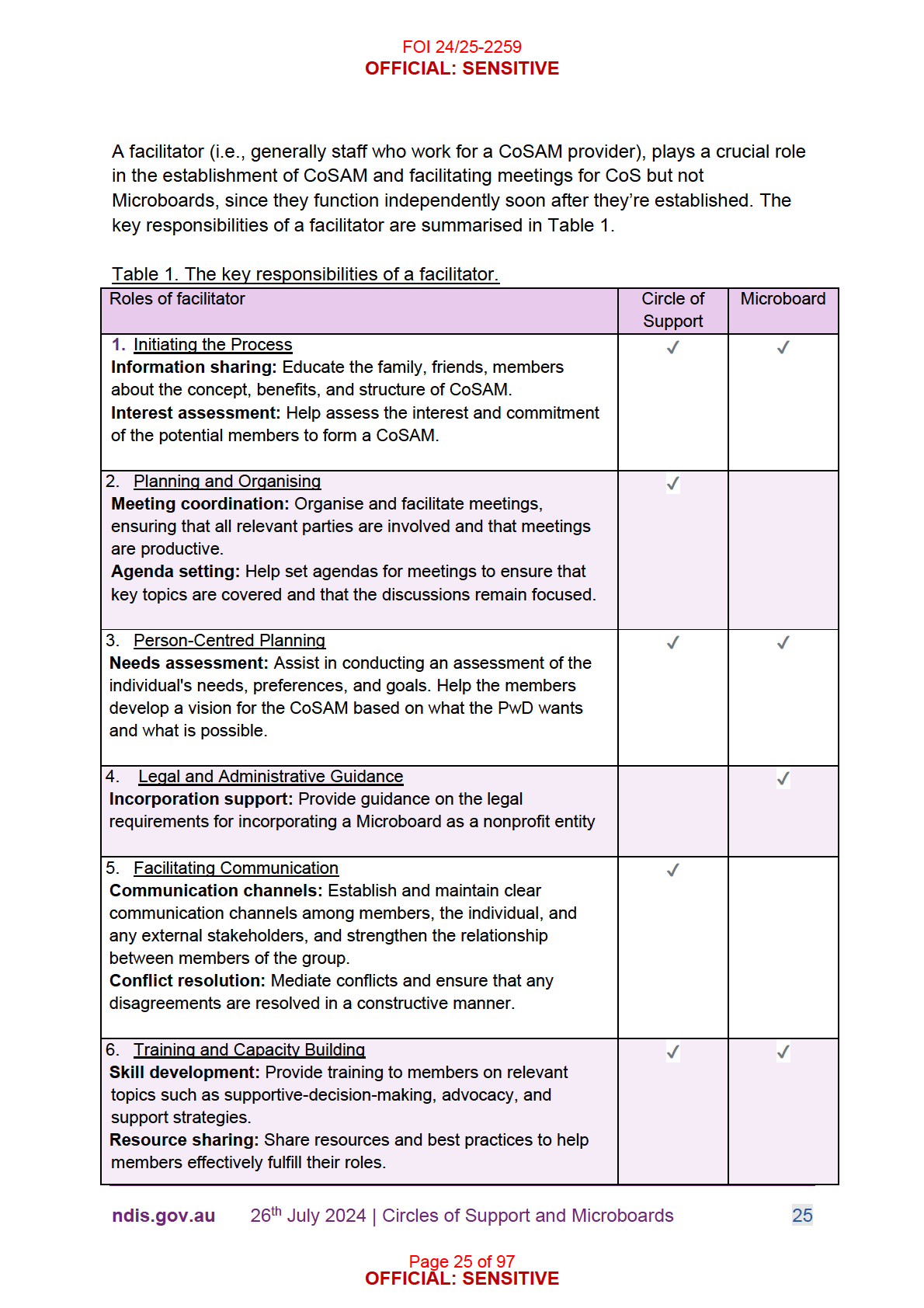
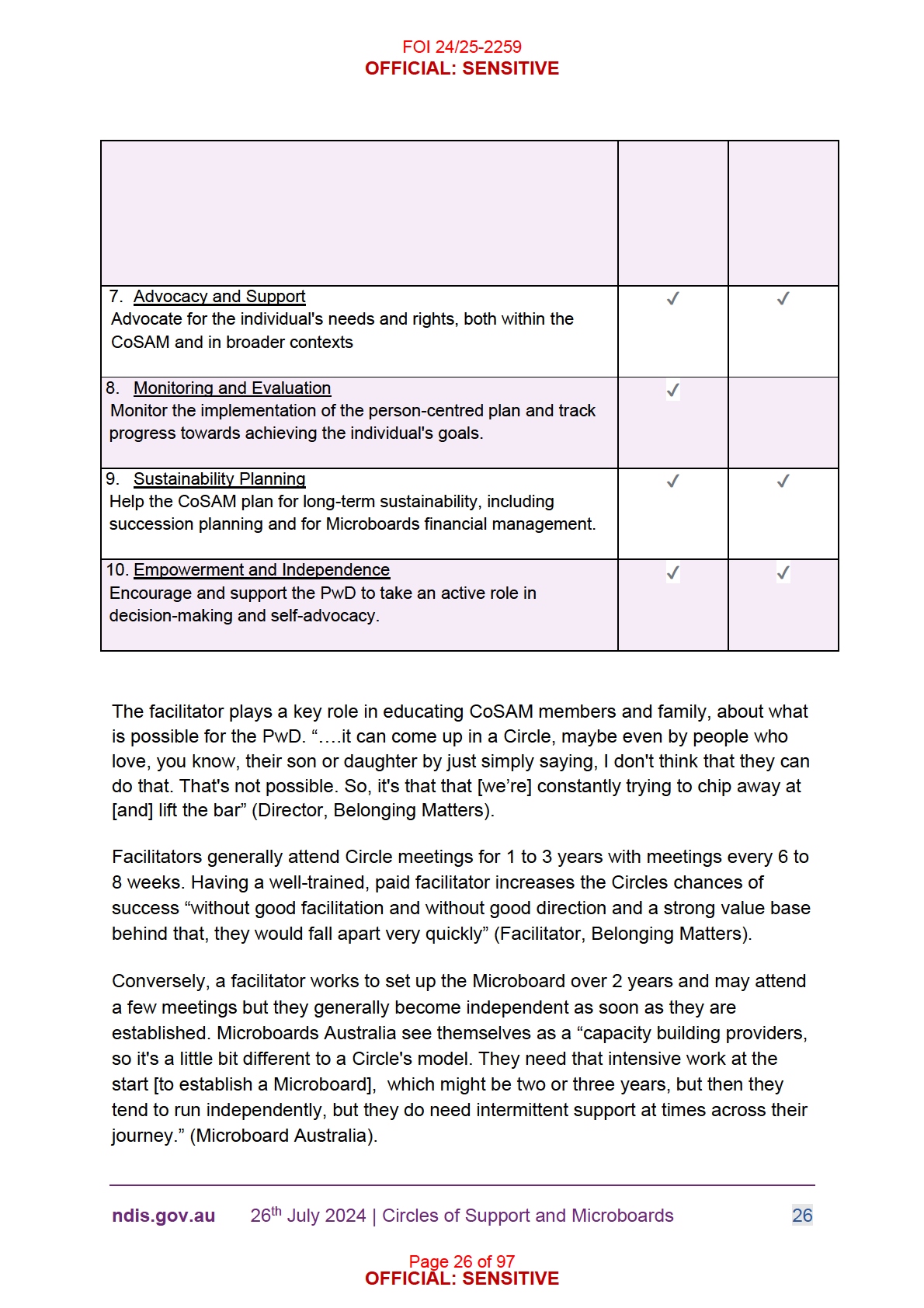
FOI 24/25-2259
OFFICIAL: SENSITIVE
One of the critical skills of a good facilitator, is understanding and knowing how to
make use of the services, tools and opportunities provided within the NDIS,
communities, service providers and government. The head of policy and research at
Inclusion Melbourne states “having that ability to use these tools and systems and
planning, that then becomes the next real driver”.
When the CoS is ready to become independent of a paid external facilitator, a
member will step into the role. Ideally, this not a family member so they can
participate in the discussions and avoid the challenging task of requesting help from
other members (Imagine More and Belonging Matters).
Most providers highlighted the difficulty of finding good facilitators due to the
complexity of the role and the need to work flexibility outside of office hours.
1.1.1 Cost of facilitators
When CoSAM providers discuss 'funding Circles and Microboards', they primarily
focus on funding the facilitators. It costs approximately $10,000 a year for a CoS
facilitator and $8,400 a year for a Microboard facilitator and for training board
members. These costs will vary depending on the provider and level of need of the
PwD to establish a CoSAM.
1.1.2 Safeguarding provided by CoSAM.
Circles and Microboards play a crucial role in safeguarding by ensuring that services
provided are supportive and safe for individuals, keeping their needs at the forefront
of planning, establishing succession plans, fostering community connections, and
acting as a natural safeguarding mechanism by consistently bringing people together
around a PwD. According to Jay (2018), "Circles of Support are seen as
mechanisms that can enable and safeguard the individuals’ rights to make decisions
and choices about their own lives and support arrangements"[12].
Safeguarding principles are integral to the Microboards constitution, where members
actively monitor and protect the physical and mental wellbeing of the PwD (CEO,
Microboard Australia). Some members conduct unannounced visits to check on the
PwD's wellbeing, reflecting the CoSAM's culture of deep familiarity with the
individual. As stated by the CEO of Microboards Australia, "So everyone knows the
signs of things going well and the signs that things are not going well and that gets
unpacked." Additionally, wellbeing assessments are regularly conducted and
reviewed by the Microboard, measures include the PwD’s engagement,
presentation, mental wellbeing, and physical health.
ndis.gov.au
26th July 2024 | Circles of Support and Microboards
27
Page 27 of 97
OFFICIAL: SENSITIVE
FOI 24/25-2259
OFFICIAL: SENSITIVE
An important goal of the CoSAM is to continue across the individual’s lifetime, to
ensure they receive ongoing support and care even when the family are no longer
alive. While CoSAM inherently act as a safeguarding strategy, Microboard Australia
CEO emphasises the importance of the PwD selecting their Microboard members
willingly, "we're really clear about this, that Microboards and Circles for that matter,
can easily become things that are done to people."
Microboards Australia recognises the potential risk of Microboards becoming
controlling, and therefore they assess prospective members to ensure they share the
right mindset. The CEO emphasises, "we're pretty clear that we won't progress with
a Microboard and supporting its incorporation if we don't see evidence that the
supporters have got the right mindset because a group of people can be a wonderful
thing in a person's life, they can also be a very controlling thing actually."
CoSAM provide safeguarding through:
1.
Personalised oversight: because CoSAM are composed of a small group of
individuals who know the person well, they can closely monitor their well-being
and quickly identify any concerns.
2.
Comprehensive planning: CoSAM develop individualised plans that address
the specific needs, preferences, and vulnerabilities of the person they support.
3.
Accountability and transparency: Microboards operate with a high level of
transparency and accountability. Having regular meetings and keeping
minutes can ensure all actions are in the best interest of the individual.
4.
Empowerment and advocacy: by empowering the individual and advocating
for their rights, CoSAM can help to protect the person from abuse, neglect, and
exploitation. They work to ensure that the individual has a voice and can
express their concerns.
5.
Training and education: CoSAM members and facilitators receive training on
safeguarding principles, shared decision-making, recognising signs of abuse
or neglect, and responding appropriately to concerns.
6.
Community involvement: by engaging with the CoSAM community and
service providers, CoSAM help create a larger support network around the
individual, that further enhances their safety.
7.
Regular reviews and updates: the plans and strategies implemented by
CoSAM are regularly reviewed and updated by the members so they can
identify and respond to any pressing issues.
1.1.3 Sustainability.
Training is offered to CoSAM members and facilitators by providers to guide them on
supportive decision-making, social valorisation (ideas that aims to make positive
change in the lives of people who are disadvantaged because of their status in
ndis.gov.au
26th July 2024 | Circles of Support and Microboards
28
Page 28 of 97
OFFICIAL: SENSITIVE
FOI 24/25-2259
OFFICIAL: SENSITIVE
society) and how to promote sustainability. Other topics may include establishing a
CoSAM, the role of the facilitator, planning the first gathering, creating a positive
culture, letting a Circle grow naturally, how to make it fun and to do things outside
the circle (Inclusion Melbourne, Imagine More). Inclusion Melbourne offers 6-hour
training for facilitators.
Holding the CoSAM accountable can be an effective strategy to ensure their
sustainability. Belonging Matters requires the CoS to establish a plan at the
commencement of each year based on what the PwD would like to achieve, and
then review progress against the plan. It is important the CoSAM work towards a
specific goal to give the CoSAM a sense of purpose (Imagine Melbourne).
Sometimes members of a Circle may only participate for the duration it takes for the
PwD to achieve a particular goal, i.e., fulltime employment (Imagine More, Belonging
Matters), or for the time the PwD is at school (Imagine More). Thus, the selection of
Circle members may depend on the goal of the PwD at the time (i.e., school friends
to include PwD in social activities). Inclusion Melbourne provides some guidance on
how members may withdraw from the Circle.
1.1.4 Considerations for CALD and Aboriginal and Torres Strait Islander
people
Belonging Matters is one provider that describes the demographic of the circles of
support they have created. The majority are described as non-CALD families. Of the
16 of Circles established with Belonging Matters since 2015, ten are non-indigenous
Australians, two have Jewish backgrounds, one Polish, one New Zealand, one
British, and one Italian. The two people from Jewish backgrounds have strong
cultural and religious roots and values, providing some evidence that the CoS can
work for people from CALD backgrounds.
Imagine More claimed they not any need to adjust their approach for setting up a
CoS for cultural reasons but the CEO commented they are sensitive to the needs of
people with CALD backgrounds “but we would be, you know, aware of that and…
what sort of considerations that they would want and what would be important”.
The concept of establishing a formal network, such as a CoSAM, to support a PwD
may seem unfamiliar to First Nations people (CEO, Microboard Australia). They may
already have a healthy, inclusive, community culture that provides a support network
for the PwD and their family “We see it very much as our community is a collective
community. Supported decision-making for a person that has a disability or doesn’t
have a disability is often the same. It’s always a group consensus about what can
and can’t be done particularly in more rural, regional and remote communities.. And
ndis.gov.au
26th July 2024 | Circles of Support and Microboards
29
Page 29 of 97
OFFICIAL: SENSITIVE
FOI 24/25-2259
OFFICIAL: SENSITIVE
literally we do sit and decide who is going to make the decision and who needs to be
involved in that decision-making process. And it doesn’t mean that we’re taking away
the autonomy of the individual. The individual is still centred but the decision is
collectively made about what’s best for that person. And literally it is our way of doing
the circle of support whether you have a disability or not…” (First Nations person)[4]
The barriers faced by First Nations peoples was briefly considered in the
Commonwealth Department of Social Services commissioned report on supported
decision-making. That research made the point that due to the mistrust in the sector,
‘Capacity building must also be sensitive to historical and current factors affecting
the relationship between communities and government/services’ [13].
The NSWLRC noted that supported decision-making aligned closely with the:
collaborative and communal style of decision-making in First Nations communities,
particularly where there are multiple supporters. However, somewhat different from
supported decision-making an individual’s decision is often thought of as a decision
by and for their whole family or community group [13].
Guidance for providers by the Office of the Public Advocate (VIC), on interacting with
First Nations clients may be helpful when exploring supported decision-making in
various contexts [14].
1.1.5 Challenges experienced by CoSAM providers.
CoSAM providers in Australia described the challenges they experience when
setting up and maintaining a CoSAM for participants. The following paraphrases
what providers have claimed in reports and in interviews. They included:
1.
Inconsistent decision-making by NDIS planners: inconsistent decisions
made by planners about whether to fund facilitators for CoSAM is a source of
frustration for providers, families and the PwD. Some planners may approve
it, whist others may not. Additionally, it may be funded one year but refused
the following year. An email (June 2024) from a Support Coordinator to a
facilitator about an individual with an intellectual disability (who has two
parents who are intellectually disabled), who had a circle funded for 18
months said, “at this stage she [the planner] confirmed funding for circle
meetings is declined until they have explored it further”. The funding was
denied because the planner believed a facilitator is a duplication of services
provided by support coordinators.
In other instances, it’s because they believe the PwD has friends and doesn’t
need a facilitator. This may lead to a breakdown of the CoSAM and impact the
ndis.gov.au
26th July 2024 | Circles of Support and Microboards
30
Page 30 of 97
OFFICIAL: SENSITIVE
FOI 24/25-2259
OFFICIAL: SENSITIVE
PwD and their carer’s wellbeing.
2.
Funding facilitators using the support coordinators budget: NDIA agreed
in 2021 that facilitators could be funded using the line item of Support Co-
ordination level 2. However, this led to no Microboards being approved. While
CoSAM facilitation may include elements of support coordination, providers
claim one is not a stand-in for the other. Currently, there is no line item for a
CoSAM facilitator. Requests for funding a CoSAM are currently going via the
Technical Advice and Practice Improvement Branch and since January none
Microboards have been approved.
The differences between services provided by a CoSAM versus support
coordinators are:
o Support coordinators have a greater knowledge and understanding of
the NDIS.
o CoSAM support the PwD to choose a service or provider that their
support coordinator has found.
o CoSAM advocate with the PwD if they are not being heard by a
service.
o CoSAM can explore lifestyle options for the PwD that are outside of the
NDIS goals.
o Support coordinator’s role is time limited.
o CoSAM can spend more time exploring what a PwD wants or needs in
all aspects of their life.
3.
Assuming role of CoSAM is only for supported decision-making: while
CoSAM practices supported decision-making, it is inaccurate for NDIS
planners to view CoSAM as merely a supported decision-making mechanism.
CoSAM offers much more, including safeguarding, advocacy, social activities,
community connections, and inclusion, among many other benefits.
4.
Do not understand the value for money: there is a lack of understanding
regarding the value for money a CoSAM can provide compared with
treatments with therapists. For instance, CoSAM can reduce the need for
other supports such as occupational therapy, attending day centres.
5.
Overreliance on therapeutic solutions: the focus on clinical or therapeutic
solutions to help PwD, such as occupational therapy, has diminished the
importance social networks or close relationships have in helping a PwD
achieve their goals.
6.
Lack of guidance for planners: NDIA planners receive little training on the
benefits of CoS, despite how they align with NDIS goals “and it it's very odd
because the goals of the NDIA, for example are, [a] good life in community,
ndis.gov.au
26th July 2024 | Circles of Support and Microboards
31
Page 31 of 97
OFFICIAL: SENSITIVE
FOI 24/25-2259
OFFICIAL: SENSITIVE
social or economic, all of that. And yet what's happening in practise on the
ground is completely different. And this, you know, cause it filters down
through planners. If they haven't had training” (Director, Belonging Matters).
7.
Disability sector’s misconception of what is possible for PwD: many
(NDIA planners, families and the disability sector) fail to believe a PwD can
contribute socially and economically to society “it's countercultural at this
stage still, because culturally in the disability sector, as babies, you know,
people are still being told that what is on offer is segregated options. Planners
are telling people they can't live on their own” (Director, Belonging Matters).
“…what we're doing is trying to work in a paradigm that isolates, segregates
and has such low expectations of people with intellectual disability” (Director,
Belonging Matters).
8.
Lack of funding for facilitators may compromise access to other
supports or CoSAM: PwD will typically pay the facilitator’s fees out of their
NDIS capacity building or core supports budget. Some families have had to
decide whether to use their limited funds for therapeutic support (i.e.
occupational therapy) or a facilitator because they didn’t have enough funds
for both.
9.
The need to advocate for families who have had CoSAM funding denied:
because so many families have CoSAM funding denied by the NDIS, it places
additional strain on providers such as Inclusion Melbourne to advocate for
them “And I'm pretty good with supporting families to get funds for the circle
facilitated. But the average person struggles. Really often it's not because of
the circle that they've requested funding for is poorly put together. It's often
because they just struggle to articulate all this complexity” (Head of research
and policy, Inclusion Melbourne).
2. Microboards versus Circles of support
A Circle of Support may be a good option when the person has a strong existing
support network and there’s no need to progress to a Microboard.
A Microboard may be a good option when the person: 1) does not have a strong
network of existing supports, such as family or friends, 2) requires management and
oversight for various aspects of their life, 3) needs more structure and reliable
checks and balances, 4) needs strong advocacy, 5) wishes to formalise their support
for when their parents are no longer alive, 6) has a Circle of Support at risk of falling
apart, 7) has parents who no longer want to self-manage NDIS funds and prefers a
Microboard acts as a provider to hire support workers and handle fiscal, legal, and
practical responsibilities, 8) has people in their life with financial and reporting
expertise and 9) has people in their life willing to be part of an incorporated entity.
ndis.gov.au
26th July 2024 | Circles of Support and Microboards
32
Page 32 of 97
OFFICIAL: SENSITIVE
FOI 24/25-2259
OFFICIAL: SENSITIVE
3. Outcomes for Circles of support and
Microboards
Twenty-seven papers from academic and grey literature reported on the benefits and
risks of setting up and maintaining circles of support and Microboards. Most data
were qualitative, derived from interviews and focus groups with facilitators, carers,
people with disabilities, members of circles of support and Microboards, and service
providers.
A limitation of the data is that authors often summarise interview responses without
providing full quotes. This practice can make it difficult to understand the context or
full meaning of the statements. Additionally, authors may quote other authors'
publications rather than directly quoting interviews, complicating the extraction of
original interview data. This approach lacks transparency and reduces the reliability
of the reported information. To counter this, quotes from PwD (or carers are
highlighted in this chapter. Fortunately, most of the reported benefits are derived
from PwD or their carer’s quotes, so there is a reduced chance of positive bias in our
findings. However, some researchers and their publications are funded by CoSAM
organisations, potentially biasing their results [4, 15-18].
No cost-effectiveness analysis on CoSAM versus usual care was identified in the
literature. One study estimated the cost saving CoS may provide people with severe
learning difficulties by arranging a care package to be delivered in the home and
compared this with the cost of living in fully-staffed residential care (mean £51,000
versus £139,000) [19].
Of the 25 papers, twelve were from Australia (44%), eight from Canada (30%) where
the concept of Microboards originated, three from the UK and Ireland (11%), and
three from the United States (11%). The most reported benefits and risks found in
the literature are shown in bold, and the corresponding references and examples
quotes can be found in “Appendix Table A2-A5”.
3.1 Benefits of Circles of Support
Supported decision-making.
Structuring existing relationships into a Circle of Support provides numerous
benefits for PwD. It establishes a reliable, coordinated system that regularly meets to
find
greater opportunities for the PwD to achieve their personal and professional
goals. “You know when you get a group of smart people together who've got different
ndis.gov.au
26th July 2024 | Circles of Support and Microboards
33
Page 33 of 97
OFFICIAL: SENSITIVE
FOI 24/25-2259
OFFICIAL: SENSITIVE
life experience, they are very good at brainstorming…. They clarified issues” (Parent
of PwD) [20].
By providing
supported decision-making, they empower individuals by giving them
choice and control over their lives and the support they receive. A PwD said “good
support like I get has helped me to learn. I go to them and I have people to ask
questions. Other people’s thoughts and ideas help me decide what to do” [21].
Oversight.
Having several members in a Circle of Support increases oversight, ensuring the
PwD receives high-quality services and holding providers to
account. The circle can
also
advocate for the rights and needs of PwD, tasks often left to caregivers who are
frequently exhausted and have limited capacity to challenge the system. They can
also assist those who have minimal support “[CoS can support the] thousands of
people who are living in disability accommodation, who are unable to self-advocate
and do not have family support” (Family of PwD) [22].
Support and respect.
A CoS facilitates
socialisation and friendships, reducing isolation and improving
mental well-being: “Jeff had more people to call on following the program than
before” (Mother, circle member) [22]. Another circle member described “[the circle]
produced major social, psychological and practical outcomes for the individual and
their family” [19]. One member described the Circle’s impact as “massive” for a
person with complex needs who now knew that “people are looking out for her. She
could now take part in activities in the same way as people without disabilities and
was much more integrated in the local community” [19].
It also creates a
safe space for the PwD to feel valued and respected. Engaging
with the CoS fosters a
capacity-building environment, allowing the PwD to
enhance their skills in communication, socialisation, and self-advocacy: “Every
gathering Louise would share something about herself, she tells what she had done,
what she likes, she just loves it… It meant that she had her voice heard which was
great because it didn’t always get heard by that many people” (Parent of PwD) [20].
By giving PwD a voice it
changes the perspective and understanding of people, including circle members and family, about people with disabilities: “We sort of
overlooked her potential for photography, you know how it is when you are living with
a person with disability, sometimes you’re just busy with the day-to-day so we
overlooked her eye for photography. So people in the group help her set up what you
call it “Instagram”, she takes pictures I write the story, she loves it, people comment
and she loves it” (Parent of PwD) [20].
ndis.gov.au
26th July 2024 | Circles of Support and Microboards
34
Page 34 of 97
OFFICIAL: SENSITIVE
FOI 24/25-2259
OFFICIAL: SENSITIVE
The CoS also provides
shared responsibility, a source of help for the carer, who
typically takes on all the responsibility of caring for a PwD: “I would just send text
message to someone and then these people, someone from the circle … come at
the car up from the train station” (Parent of PwD) [20]. Another carer said "...the
Circle had ‘taken away the constant stress of being a carer 24/7 and that
monumental responsibility for someone’s life’. Having felt suicidal and requiring long-
term counselling, one parent described herself as “living a normal” existence
because the Circle supported her as much as her child: “it gave me my life and it
gave (child) hers” (Carer) [20]. The collective nature of Circles of Support and the
sense of community reported by the many people involved were associated with
family feelings of confidence, respect, reduced burden and an increased sense of
belonging and wellbeing [23].
Better use of resources available to them.
A CoS can ensure PwD get full access to the services available to them: "individuals
with physical disabilities are able to take better advantage of these opportunities
[from individualised funding] than those with intellectual impairments. In the latter,
good outcomes appear to depend upon strong advocacy or brokerage support”
(quote from Carey 2018) [22].
3.2 Quantitative data
• A study by Wistow et al. (2016) surveyed four parents and an unpaid carer to
measure the quality of life for a PwD using the social care quality of life tool
[19]. They compared the quality of life of a PwD with a CoS to an estimated
scenario without a CoS The study reported that the PwD's quality of life score
with a CoS was 0.82, compared with an estimated 0.21 without it. However,
these findings are at a high risk of reporting bias, includes no control group
and includes a small sample size (n=5).
• In the same study, Wistow et al (2016) demonstrated how much money CoS
saved 5 individuals with learning disabilities by arranging care packages for
them to live at home (£7,000 to £80,000) compared with a fully staffed
residential setting (£139,308 per year) [19].
• In their PhD thesis, Watson (2016) compared before and after results in 5
PwDs who had a CoS for 6-months using questionnaires, interviews and
observations [24]. All outcomes improved over time including PwD
responsiveness (23%), decision-making capability (50%) and number of
conflicts amongst CoS members (-55%). A positive association was found
between the closeness of a supporter and the PwD, and their degree of
responsiveness to the PwD communications (n=6). Unpaid supporters had the
highest number of intimate relationships with the PwD, but the paid/unpaid
ndis.gov.au
26th July 2024 | Circles of Support and Microboards
35
Page 35 of 97
OFFICIAL: SENSITIVE
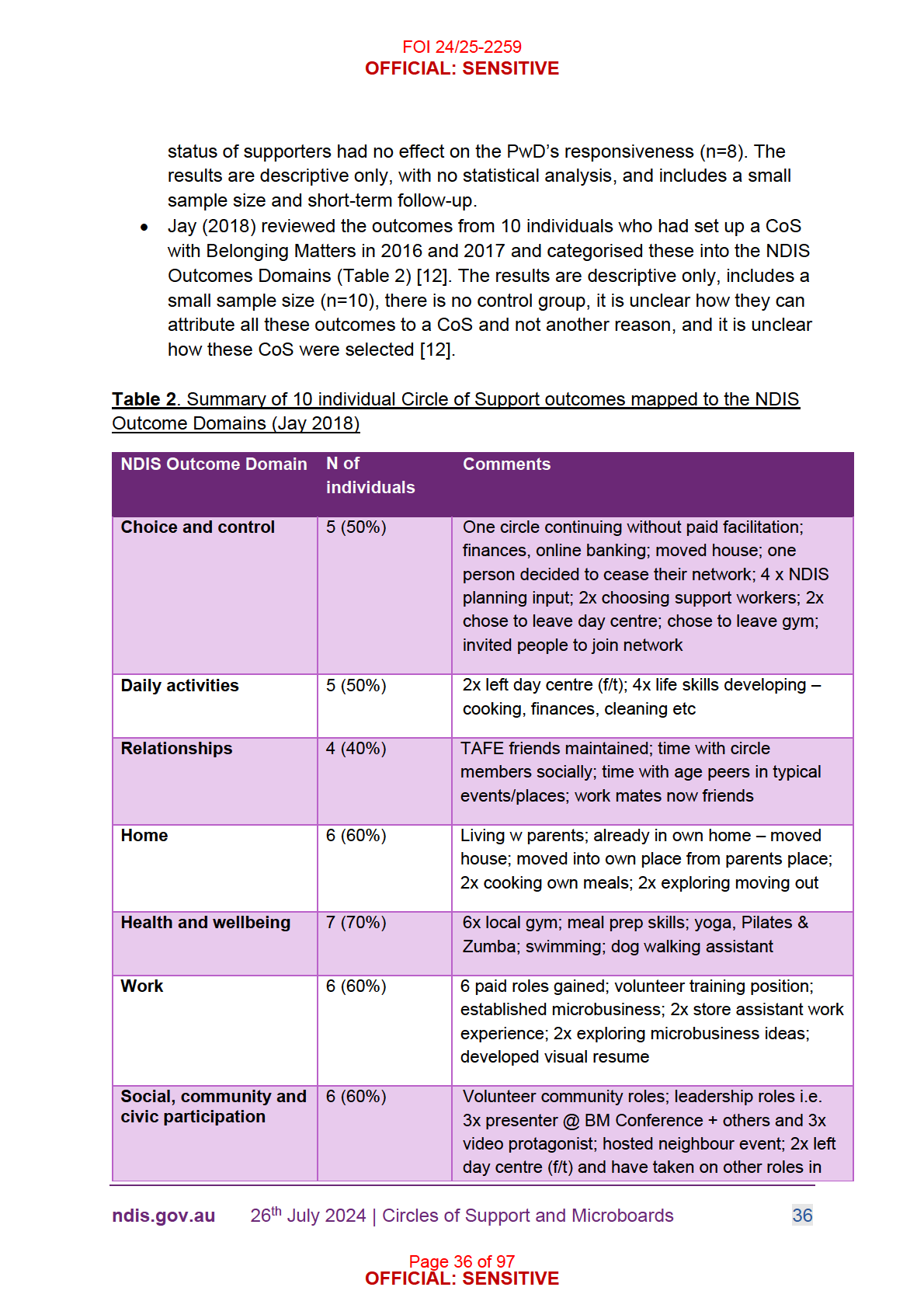
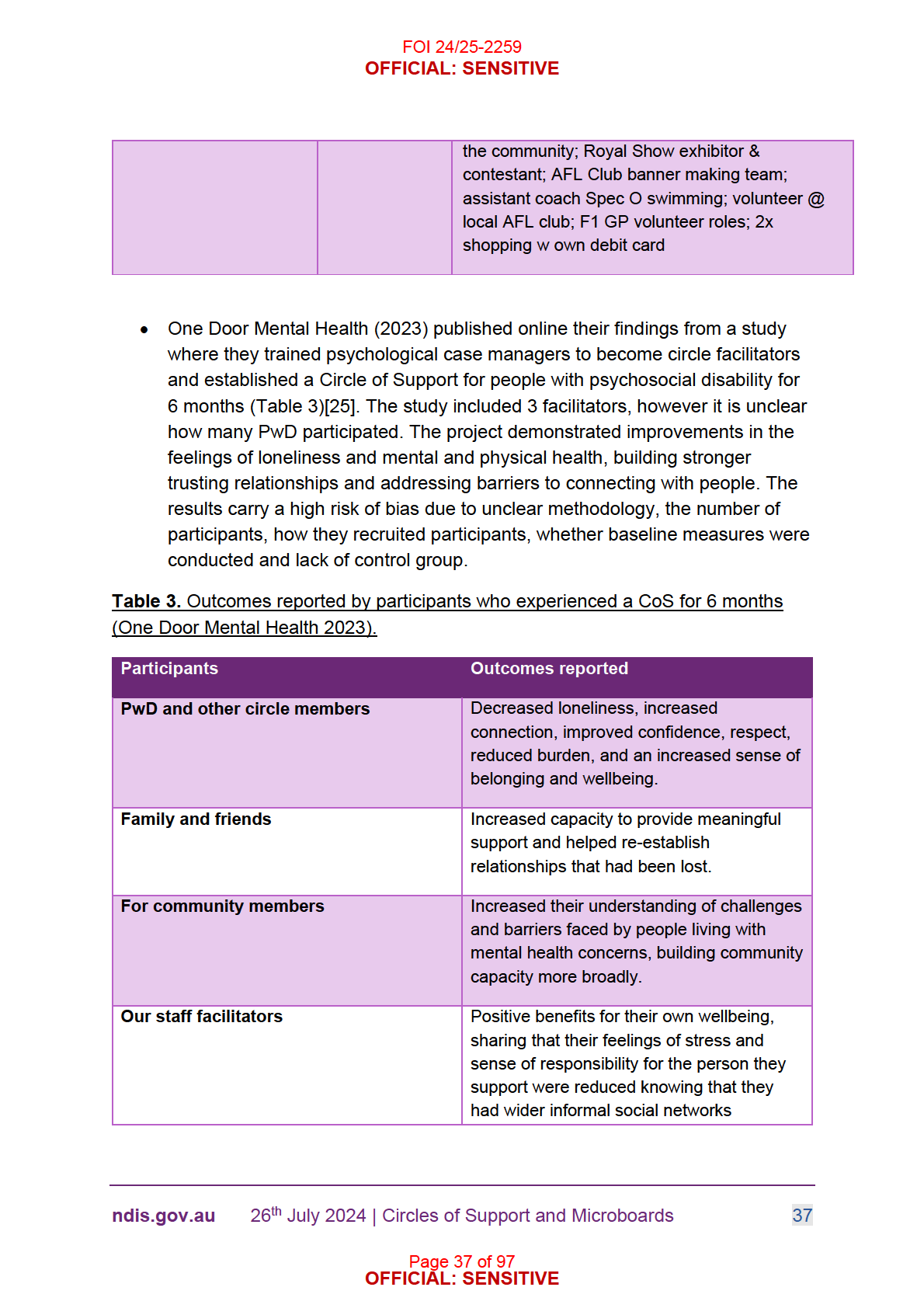
FOI 24/25-2259
OFFICIAL: SENSITIVE
available to them, in addition to the formal
supports that we were providing.
• Fong et al (2021) surveyed 153 parents of children with autism spectrum
disorder and found after controlling for demographic factors and child
behavioural problems, that satisfaction with informal supports that comprises
of a network that may include family, friends and other parents of children
with disability in the community, significantly predicted family resilience
(p<0.001)[26]. The informal supports are not necessarily a Circle of Support
but the findings indicate how support from friends and family can improve
how well families cope with the stresses of raising a child with autism.
3.3 Risks of Circles of Support
Substituted decision-making and who is responsible.
Circles of support (CoS) face several risks, including
substituted decision-making replacing supported decision-making and an undue
focus on parental decision-
making: “some CoS are established to support parental decision-making rather than
the person with disability” (Author)
[4]. The
power CoS can have to make
decisions is significant when the PwD cannot speak for themselves. And because
the CoS is an informal arrangement, compared with a Microboard, “the
potential for
financial or other abuse likely increases” (Author) [27].
There is often difficulty in determining
how much a PwD is legally responsible for
their own decisions when they may not have understood the risks associated with a
decision. Members of CoS bear some
ethical responsibility for decisions made
unless they formally distance themselves from those decisions (Author) [27].
PwD may not want a CoS.
Additionally, there may be a
lack of consent from PwD to create
a CoS. They may
not feel comfortable in a group or having their private details shared with others. For
these reasons,
a CoS may not be required in all cases, and the PwD may prefer to
continue with their existing supports or mentoring or peer support groups instead.
The grey literature on CoS contains anecdotal stories of success but does
not
adequately consider the specific groups of people for whom CoS would benefit
the most.
Lack of commitment from members of CoS
ndis.gov.au
26th July 2024 | Circles of Support and Microboards
38
Page 38 of 97
OFFICIAL: SENSITIVE
FOI 24/25-2259
OFFICIAL: SENSITIVE
Activities planned by the CoS for the PwD may
not be carried out, leaving the
person and their carers feeling let down. A parent of a PwD who had a circle of
friendship at school found the connections didn’t translate to friendship out of school
“at home, like the whole summer no one called on him, no one phoned, no one came
to the door” [28]. However, there are often unrealistic expectations placed on
people
to commit to CoS that requires time and effort in and outside of meetings. For these
reasons, a CoS
may not be sustainable.
3.4 Benefits of Microboards
Supported decision-making
The benefits for Microboards are similar to Circles of Support. They empower PwD
by promoting
choice and control, allowing them to make decisions about their own
lives through
supported decision-making processes. A PwD said about their
Microboard who employed their support workers “It’s good now. I don’t have 64
people taking care of me. These are my friends [present paid supports]” [29].
Another said "I'm getting more choice and control than I had before. I'm learning how
to use it. I'm not a number. I have preferences. The most important choices for me
are where I want to go, what I want to do, what I want to eat, what time I go to bed,
and what time I get up. I have these choices now” [29].
Microboards also establish a
succession plan that details long-term support
strategies for the PwD, ensuring continued support even when family members are
no longer alive. “I kind of feel like [my husband] and I could die because we’ve got
these very committed people overseeing [our daughter’s] life and services and
supports. You know, it’s so comforting to us to share this with people who have
made such commitments to [her] life and that’s huge for me” (Parent of PwD) [15].
Benefit people of all ages
Deakin University’s evaluation of Microboards for Children program found that
families with a Microboard were better equipped to advocate for systemic inclusion of
their child or young person and that their child’s choice and control in their life was
enhanced [17].
Additional support
Microboards also provide additional support, offering PwD opportunities for
socialisation and friendships, that can significantly improve their mental well-being
and sense of belonging: “Kate got an improved understanding and communication
with those in the group so because they lost some of their fear of communicating
ndis.gov.au
26th July 2024 | Circles of Support and Microboards
39
Page 39 of 97
OFFICIAL: SENSITIVE
FOI 24/25-2259
OFFICIAL: SENSITIVE
with her and because she could see that they were actually interested in her she
began to talk more to that circle of people, ladies in particular, and they became free
to communicate with her… It gave Kate more social outlets because when she went
to church, people knew more about her and so they could come and start a
conversation with her”(Brother) [20].
Additionally, Microboards offer
vital support for carers, alleviating some of their
burdens and allowing them to navigate the system more effectively. "Having the
Microboard step in around some of these difficult decisions was so invaluable to me
because it was now shared decision making with a network of people bringing a
variety of perspectives." (Parent of PwD) [15].
Microboards have also been shown to lead to real
improvements in the quality of
life for persons with disabilities (PwD), resulting in a more enriched and fulfilling life
experience. As one carer noted, “Having the Microboard just makes it really flexible
for somebody with such high complex needs to not just exist, but to truly live. And
without the Microboard, [he] wouldn’t have the unique, rich life that he does have”
[15].
Safeguarding
Furthermore, Microboards enhance
safeguarding by having multiple members
oversee and advocate for the PwD's rights and needs, ensuring they receive high-
quality services and protection from potential abuse. A PwD commented "with the
Microboard I feel I am the key decision maker. Respect and choice are the most
important to me. I am more respected now, and I have more respect for myself. I like
it a lot better than a group home. I can do what I want, whenever I want, as part of
the community" (Malette 1996).
3.5 Risks of Microboards
Substituted decision-making
Setting up a Microboard can present several risks, particularly if the process does
not fully consider the consent and desires of the PwD. If the PwD did
not provide
their consent to establish a Microboard, it can lead to feelings of
disenfranchisement and undermine the core purpose of empowering them to make
decisions for themselves. Additionally, there is a risk of
substituted decision-
making, where decisions are made on behalf of the PwD without truly reflecting their
wishes and preferences. This can occur when those involved assume they know
what is best for the PwD, rather than supporting them to make their own decisions.
ndis.gov.au
26th July 2024 | Circles of Support and Microboards
40
Page 40 of 97
OFFICIAL: SENSITIVE
FOI 24/25-2259
OFFICIAL: SENSITIVE
PwD not wanting a Microboard or able to choose members
The influence of
family members in choosing Microboard members can
negatively impact the PwD. Family members may select individuals who align more
with their own views rather than the PwD's best interests. Another risk is the
assumption that everyone would benefit from a Microboard. This model may not
be suitable for all PwD and the diversity of disabilities and personal situations means
that a one-size-fits-all approach can be harmful.
Members exploit their position
Even with supported decision-making models, there are opportunities for financial or
other forms of abuse. However, no data was identified on the incidence of such
abuse [30]. Members of the Microboard could exploit their position of trust to benefit
themselves rather than the PwD. An example of this is that a Microboard changed
their constitution (from what Microboards Australia promote) to allow support workers
to join. This is a conflict of interest and can make the PwD feel uncomfortable
discussing matters with these support workers present.
This highlights the importance of careful selection and oversight of Microboard
members to ensure they have the right intentions and competencies.
Legal ambiguity
The lack of clarity for third parties regarding who is legally responsible for decisions
made by the Microboard can lead to confusion and potential legal disputes (see
Legal responsibilities).
Alternatives unexplored and questionable benefits
Other drawbacks of Microboards, include the uncertainty regarding how they provide
accountability [27] and the image of a corporate-faced support is a little
confrontational. Succession planning and safeguarding may also be
delivered in
other ways [31, 32].
3.6 Quantitative findings on Microboards
• Cocks et al (2018) surveyed 29 members of a Microboard (Table 4)[33]. The
results showed the Microboard had assisted in finding paid employment,
improving community engagement and a social life and achieving life goals.
There were ongoing challenges identified, including few opportunities to
socialise, few close friends or valued roles in society and long term planning
by the Microboard. There is a high risk of reporting bias since the findings are
ndis.gov.au
26th July 2024 | Circles of Support and Microboards
41
Page 41 of 97
OFFICIAL: SENSITIVE
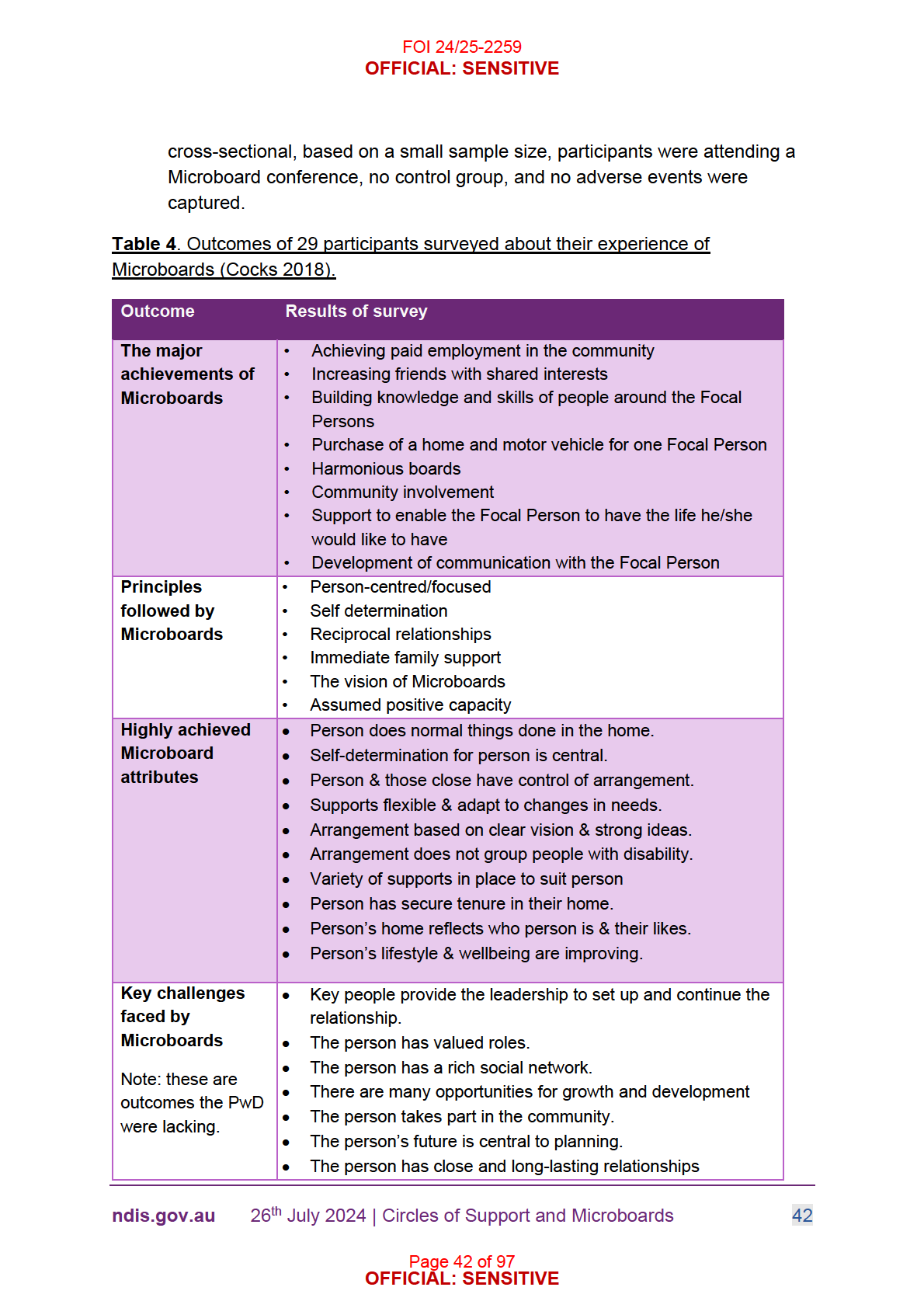
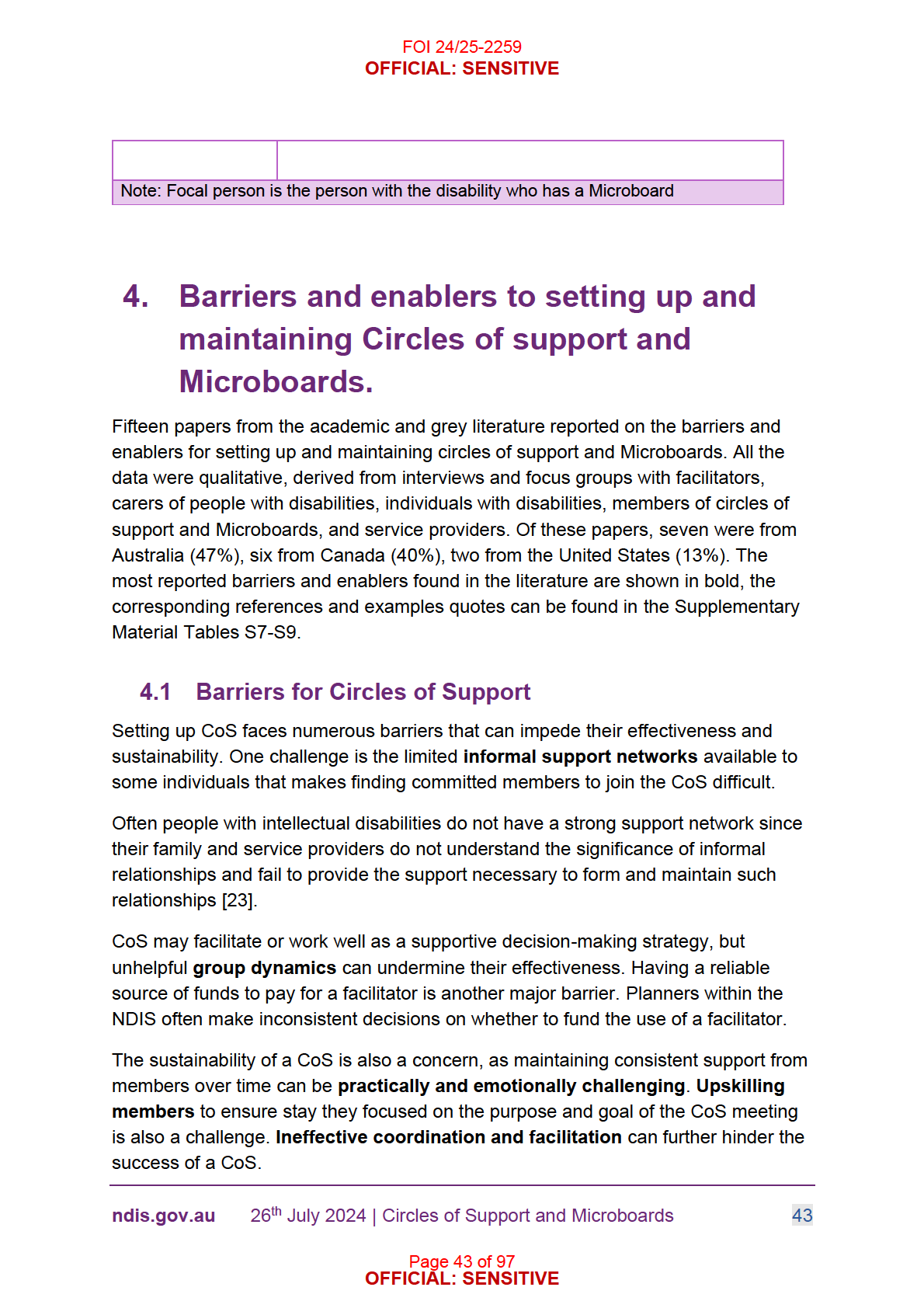
FOI 24/25-2259
OFFICIAL: SENSITIVE
Additionally, there is a
lack of published, well-designed, long term quantitative
and qualitative studies on running a CoS, so establishing and maintaining effective
models is challenging.
4.2 Enablers for Circles of Support
Several key enablers contribute to the success of CoS.
Effective facilitation can
help guide the group, foster a collaborative environment, and ensure members
maintain their focus on the individual's goals.
Having an existing social network
and supportive family makes it easier for the PwD to find and invite members to
join their CoS. A
collaborative CoS enables diverse input and shared responsibility,
ensuring that the carer is not burdened with all the group's tasks.
4.3 Barriers for Microboards
A person setting up a Microboard can be faced with several barriers. The
time
commitment required can be daunting for many potential members, thus impacting
finding
suitable individuals who are willing to join. Even when members are found,
there may be
a lack of commitment from board members, leading to inconsistent
participation and support.
Administrative challenges add another layer of complexity, as does the necessity
to navigate
funding eligibility and secure
adequate NDIS funding, which is often
insufficient.
Managing and funding services, along with the challenge of
hiring
employees, further complicates the process. The need to
hire a facilitator can be a
logistical and financial burden for families.
Additionally, a Microboard may have
limited authority when it comes to some
decisions, such as those around medical treatment. A Microboard is
not the only
way to provide safeguarding. Informal approaches such as circles of support are an
option. The efficacy of Microboards in offering
greater accountability is also
questionable. Ultimately, a Microboard is
not suitable for everyone: “Microboards
have been found to hold little appeal for people with mental illness…; or for people
with ABI who are more likely to have circles of like-age informal partners/supporters; or
for people with dementia struggling to find a single supporter, much less a pool of people”
[4].
4.4 Enablers for Microboards
Setting up a Microboard involves several enabling factors that contribute to its
success. A key aspect is ensuring that the
PwD chooses to set up a Microboard.
The
PwD is often accompanied by someone close to the PwD, such as a family
ndis.gov.au
26th July 2024 | Circles of Support and Microboards
44
Page 44 of 97
OFFICIAL: SENSITIVE
FOI 24/25-2259
OFFICIAL: SENSITIVE
member or close friend, who plays a vital role in setting up the Microboard. To
ensure sustainability and effectiveness of the Microboard,
a person-centred
approach is used to ensure that all decisions and actions are tailored to the needs
and goals of the PwD.
Providers often assist in establishing Microboards, offering expertise, training and
resources to navigate the complex steps involved.
Facilitator support is also crucial
when starting up a Microboard. They also help the
Microboard become
independent over time, by empowering members to manage the board themselves.
Legal status granted to individuals in the Microboard provides a formal structure
and authority, enhancing accountability and legitimacy compared with CoS.
Support
from agencies in Ontario Canada can help families receive funding for a Microboard.
Having a
legal agreement can enable members join and leave the Microboard when
needed, and ensure there is an agreed minimum number of members and meetings
to be held each year.
Microboards must
keep records of what is discussed in meetings including how plan
and decisions are made. This offers a layer of accountability to the board to be
acting in alignment with the vision and values of the person.
An effective Microboard will play a role
similar to service providers, by finding the
right supports that meet the PwD's needs and preferences.
5. Summary of key findings
The following Tables 5-13 include 12 considerations for the NDIA (in purple), the
evidence that informed these considerations, and a commentary on the quality of the
evidence that impacts our confidence in the results.
ndis.gov.au
26th July 2024 | Circles of Support and Microboards
45
Page 45 of 97
OFFICIAL: SENSITIVE
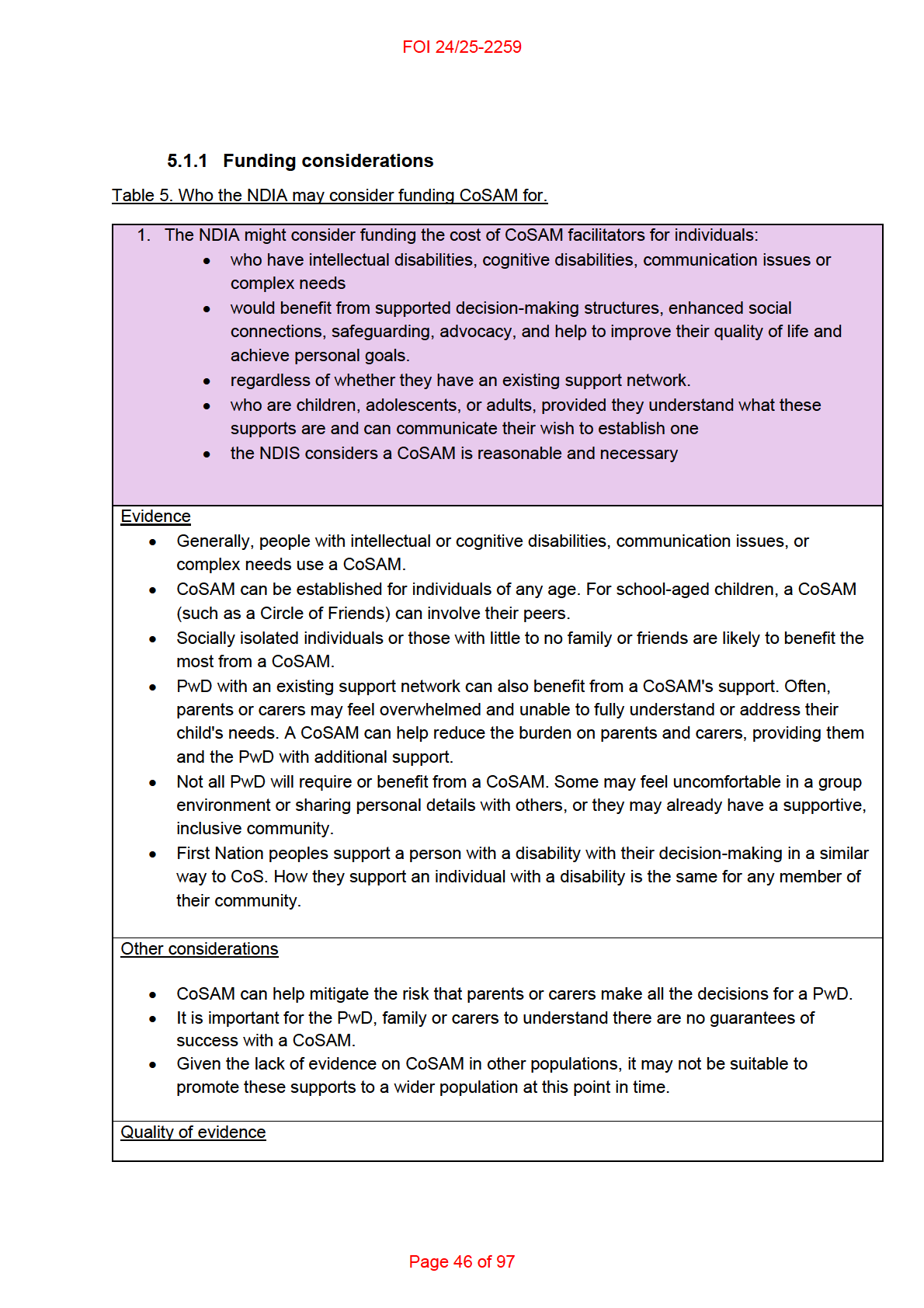
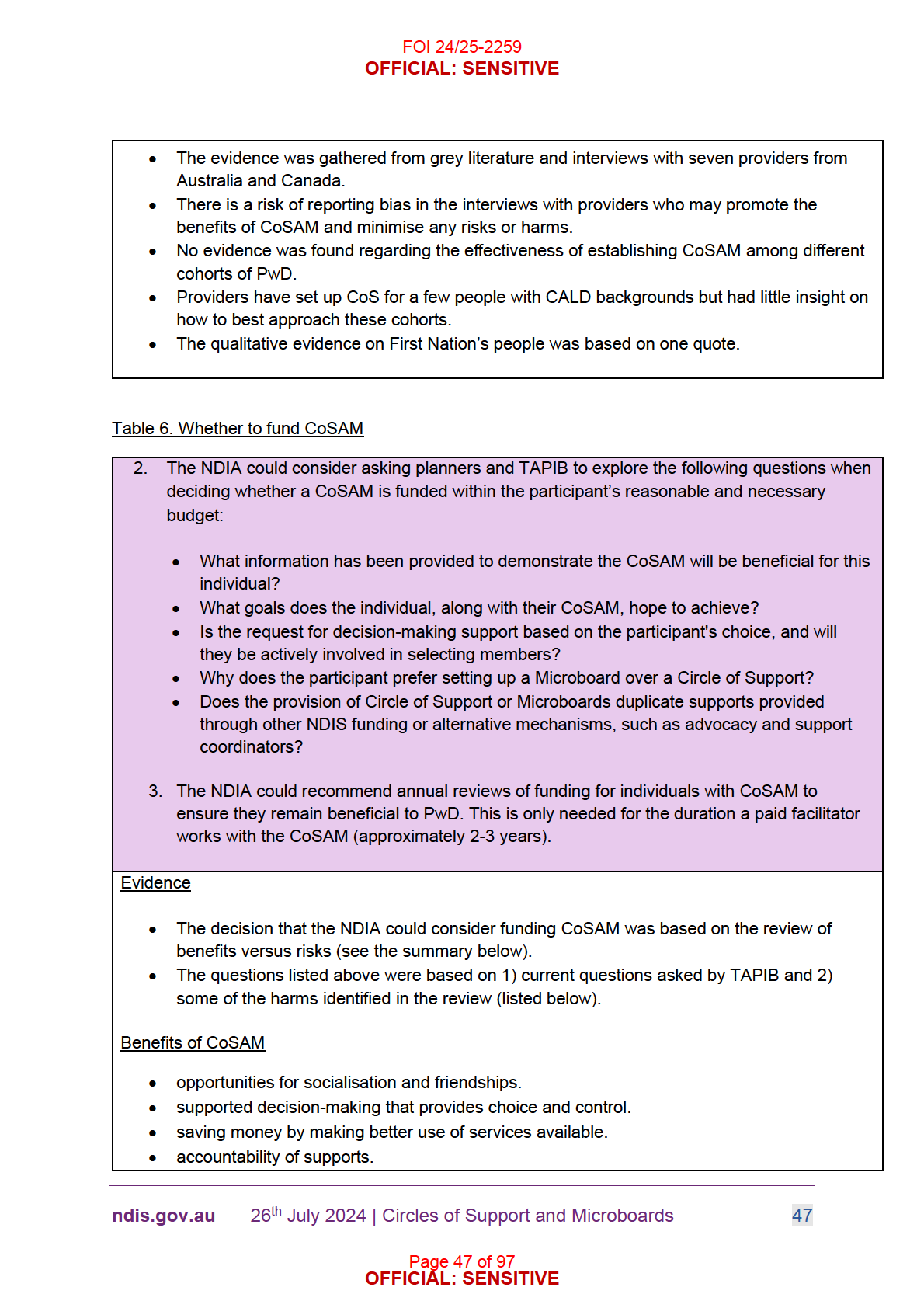
FOI 24/25-2259
OFFICIAL: SENSITIVE
• safeguarding of PwD by having more people engaged in their life.
• an enriched and fulfil ed life that includes securing open employment.
• develop and support their capacity to undertake activities that enable them to participate in
the community.
• supports plans to maximise their independence.
• building their confidence and skills to choose and control their own supports (capacity
building).
• a safe space for PwD to communicate.
• committed, reliable support.
• succession planning.
• long-term support especially when family members age and die.
• improved understanding by CoSAM members of how a PwD communicates.
For family and carers, CoSAM has provided:
• additional support and alleviated their burden.
• increased sense of belonging and wel being.
• better understanding of their child's abilities and interests.
Chal enges, risks, harms
• lack of consent from PwD to form a CoSAM.
• some PwD may not feel comfortable sharing their personal details with others.
• substituted decision-making.
• unclear legal responsibilities for Microboard members.
• relationship with members did not translate into friendships.
• ideas or social activities were not actioned.
• financial abuse with a Microboard.
• unclear how CoSAM provide accountability of services delivered to PwD
• employee complaints.
• the legal responsibility of a PwD in a Microboard, may be limited by their capacity to
understand and make informed decisions. How this is considered if legal matters arise is
unclear.
• Microboards changing their constitution to allow support workers to join. It’s a conflict of
interest and the PwD may feel uncomfortable discussing matters with them present.
• not open to other models of supported decision-making, safeguarding and succession
planning are available.
• confronting image by having an incorporation represent a PwD
• potential duplication of services
Other considerations
How the decision to consider funding CoSAM was weighed up.
ndis.gov.au
26th July 2024 | Circles of Support and Microboards
48
Page 48 of 97
OFFICIAL: SENSITIVE
FOI 24/25-2259
OFFICIAL: SENSITIVE
• Weighing up the benefits against the risks is chal enging because the frequency of harms
versus benefits is unclear.
• Based on the available evidence, CoSAM appears to benefit people with intellectual and
cognitive disabilities, communication issues or complex needs.
What a planner might consider when reviewing a funding request
• The questions planners could ask, aim to ensure a CoS or a Microboard: 1) meets the
needs of the individual, 2) are requested by the individual and, 3) are not a replication of
other supports.
• The benefits participants expect should map on to the NDIS goals such as: 1) choice and
control; 2) daily living; 3) relationships; 4) home, 5) work and 6) social, community and civic
participations.
Duplication of supports
• There is the potential that CoSAM are a duplicate of services provided by support
coordinators, who may assist PwD to review their NDIS plan, access services, and provide
supported decision-making.
• CoSAM may also be a duplicate of what an advocate provides - to uphold the rights of PwD
who are unable to act, speak or write about a difficult situation on their own, or don't have a
support network to help them.
• Planners are often unclear what the differences are between the role of a support
coordinator and facilitator and may reject a funding request on these grounds.
• According to providers, the differences between services provided by a CoSAM versus
support coordinators are:
o Support coordinators have greater knowledge of the NDIS.
o CoSAM support the PwD to choose a service or provider that their support
coordinator has found.
o CoSAM advocate with the PwD if they are not being heard by a service.
o CoSAM can explore lifestyle options for the PwD that are outside of the NDIS goals.
o Support coordinator’s role is time limited.
o CoSAM can spend more time exploring what a PwD wants or needs in all aspects of
their life.
Quality of the evidence
• The evidence was mostly gathered from 11 academic qualitative studies and 14 grey
literature reports where they interviewed PwD, carers, facilitators, providers, or provided
academic opinions, with sample sizes ranging from 1 to 32.
• Some outcomes were obtained from the 7 interviews with providers as part of this review,
and from quantitative data in academic and grey literature.
• Some outcomes were reported as secondary quotations from other papers or without
quotes, thus complicating data extraction and reducing result reliability.
• There is a notable risk of reporting bias, particularly from interviews with providers, studies
where authors received funding from providers, and market-driven reports in the grey
literature.
ndis.gov.au
26th July 2024 | Circles of Support and Microboards
49
Page 49 of 97
OFFICIAL: SENSITIVE
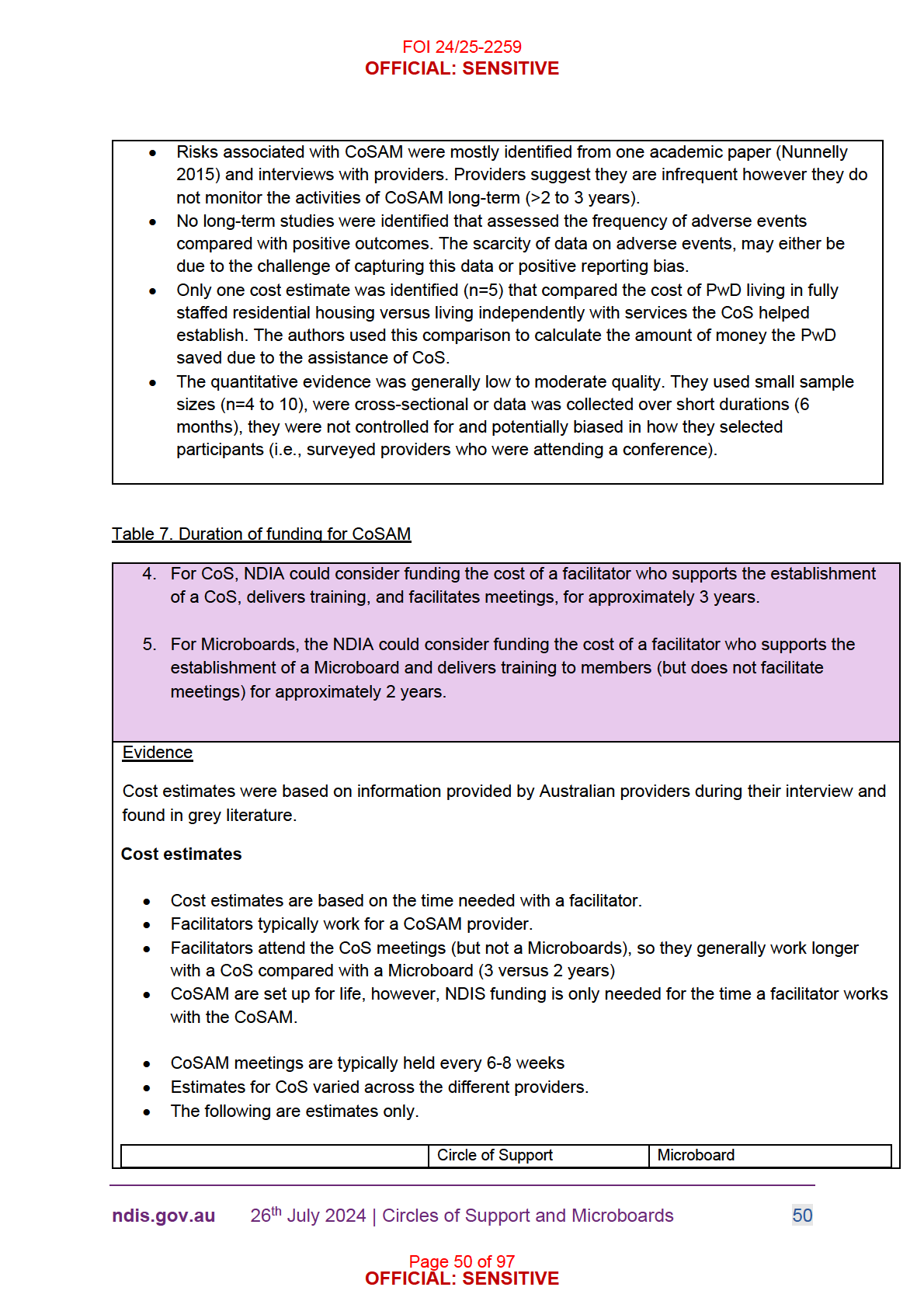
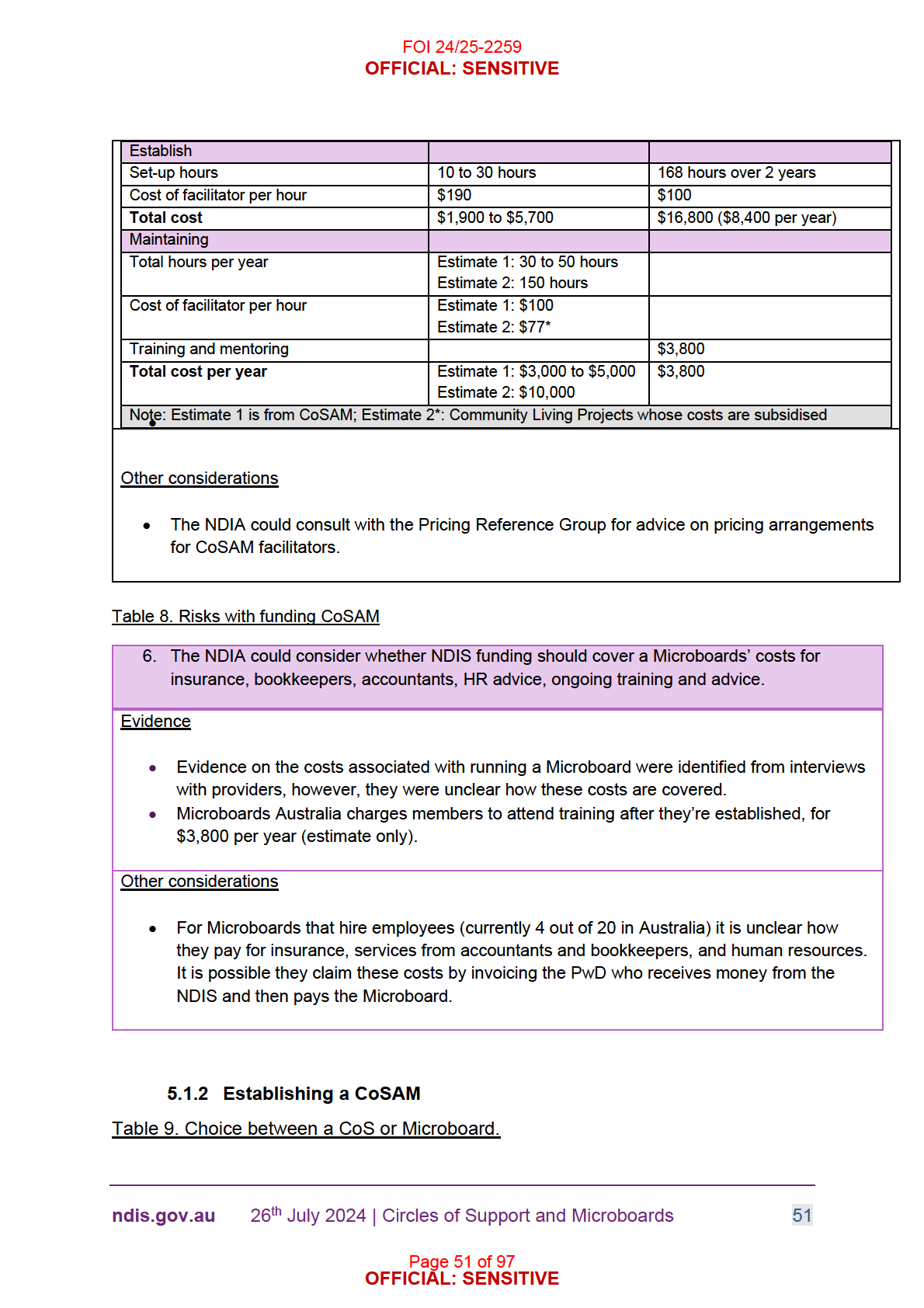
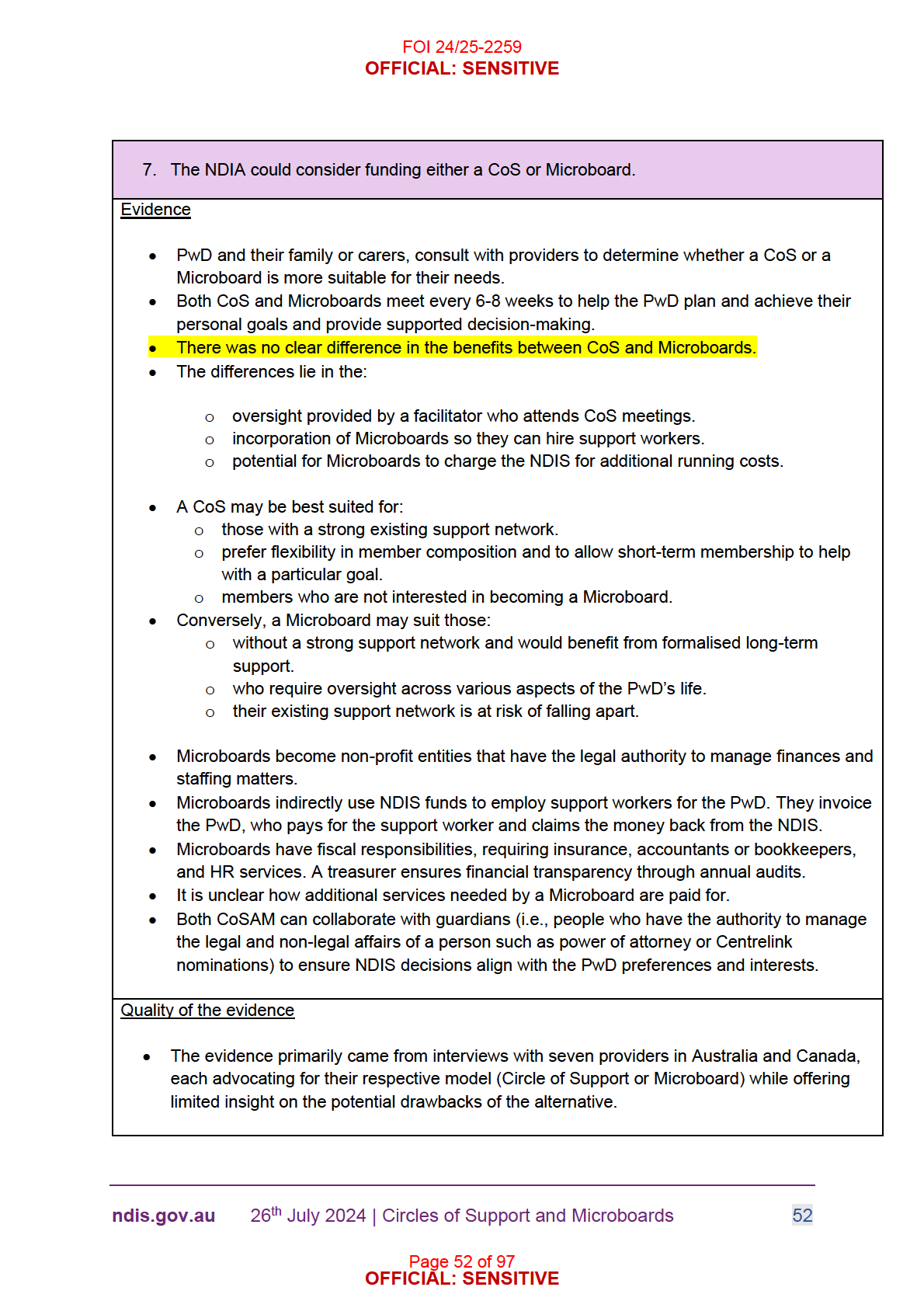
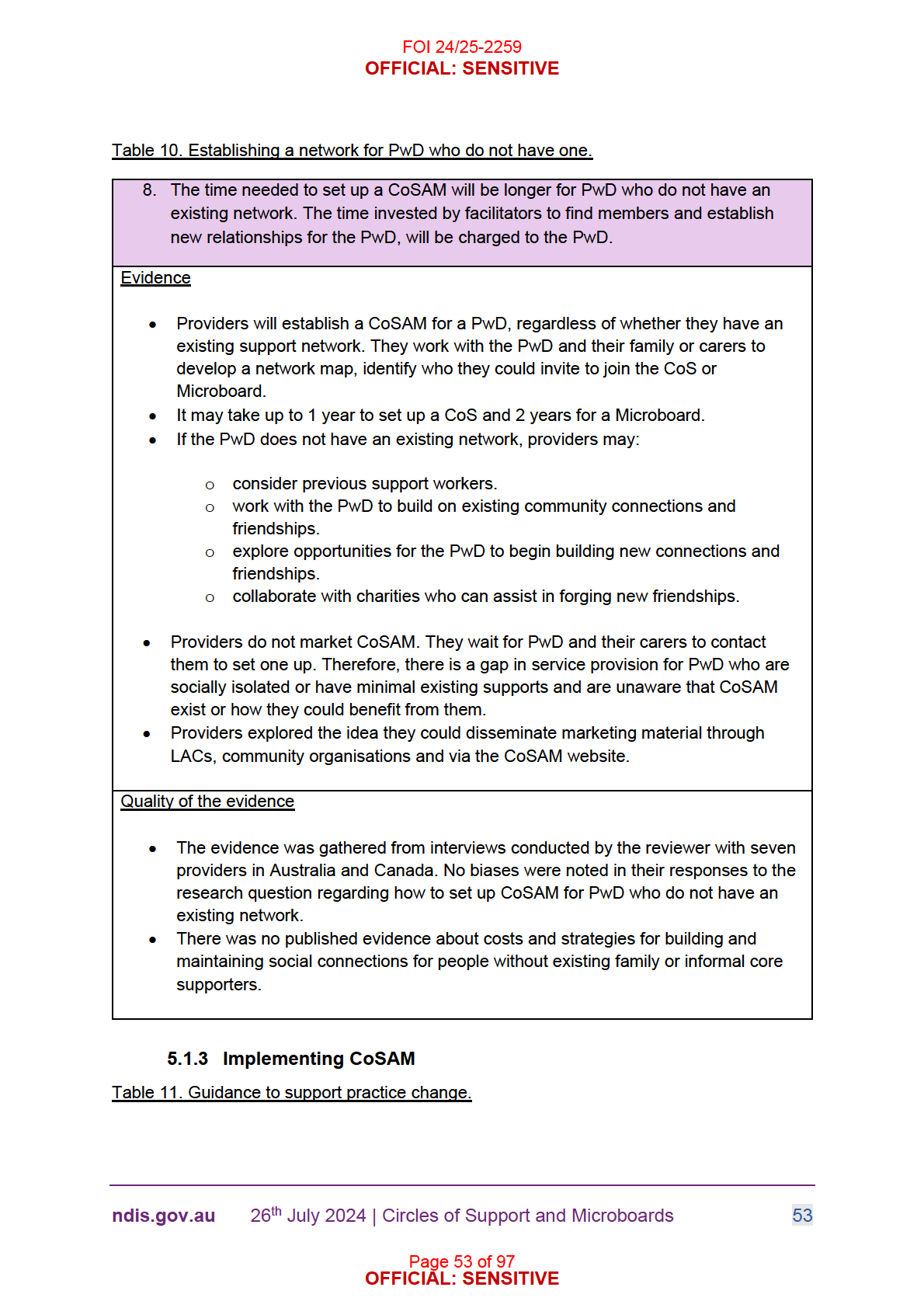
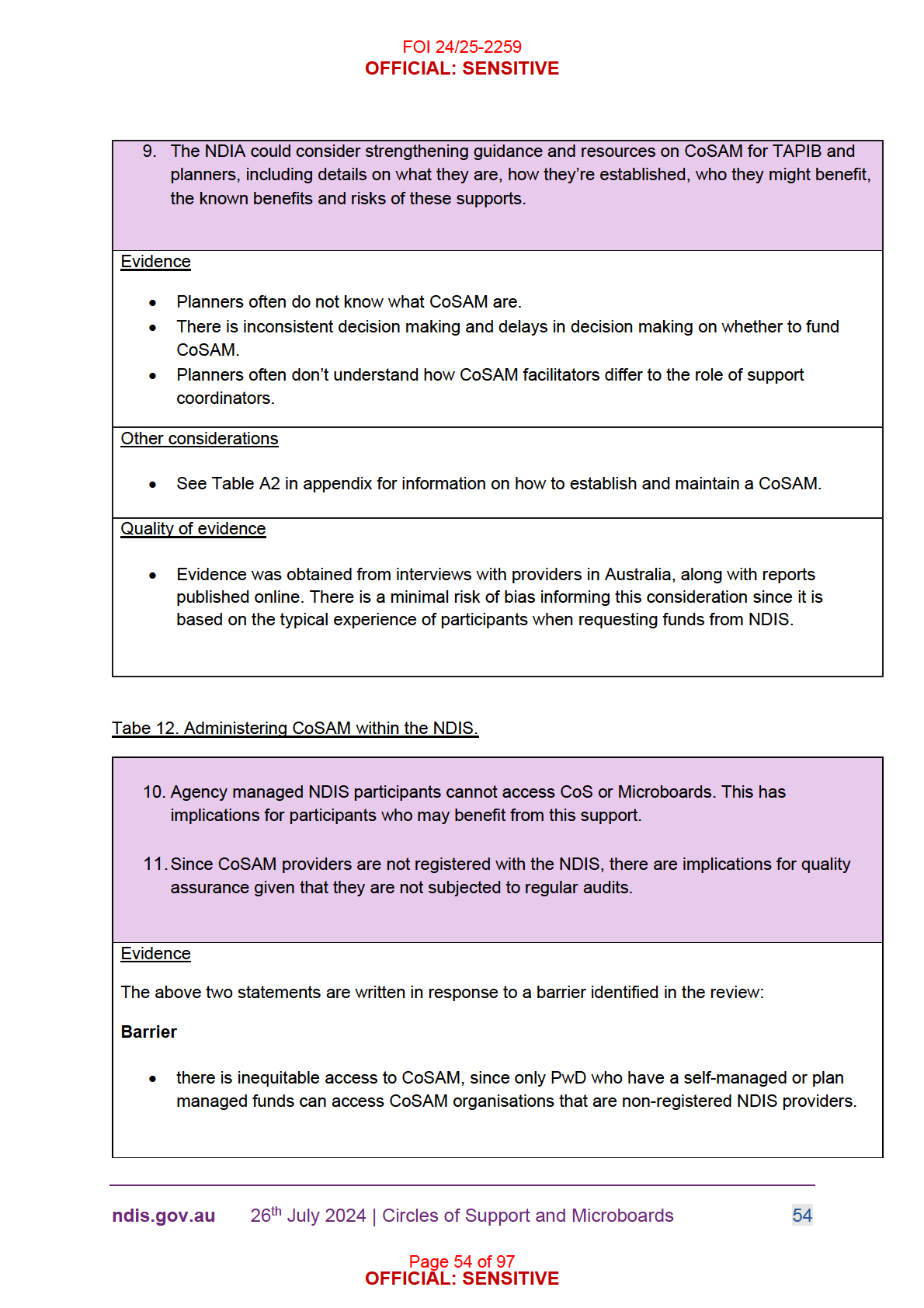
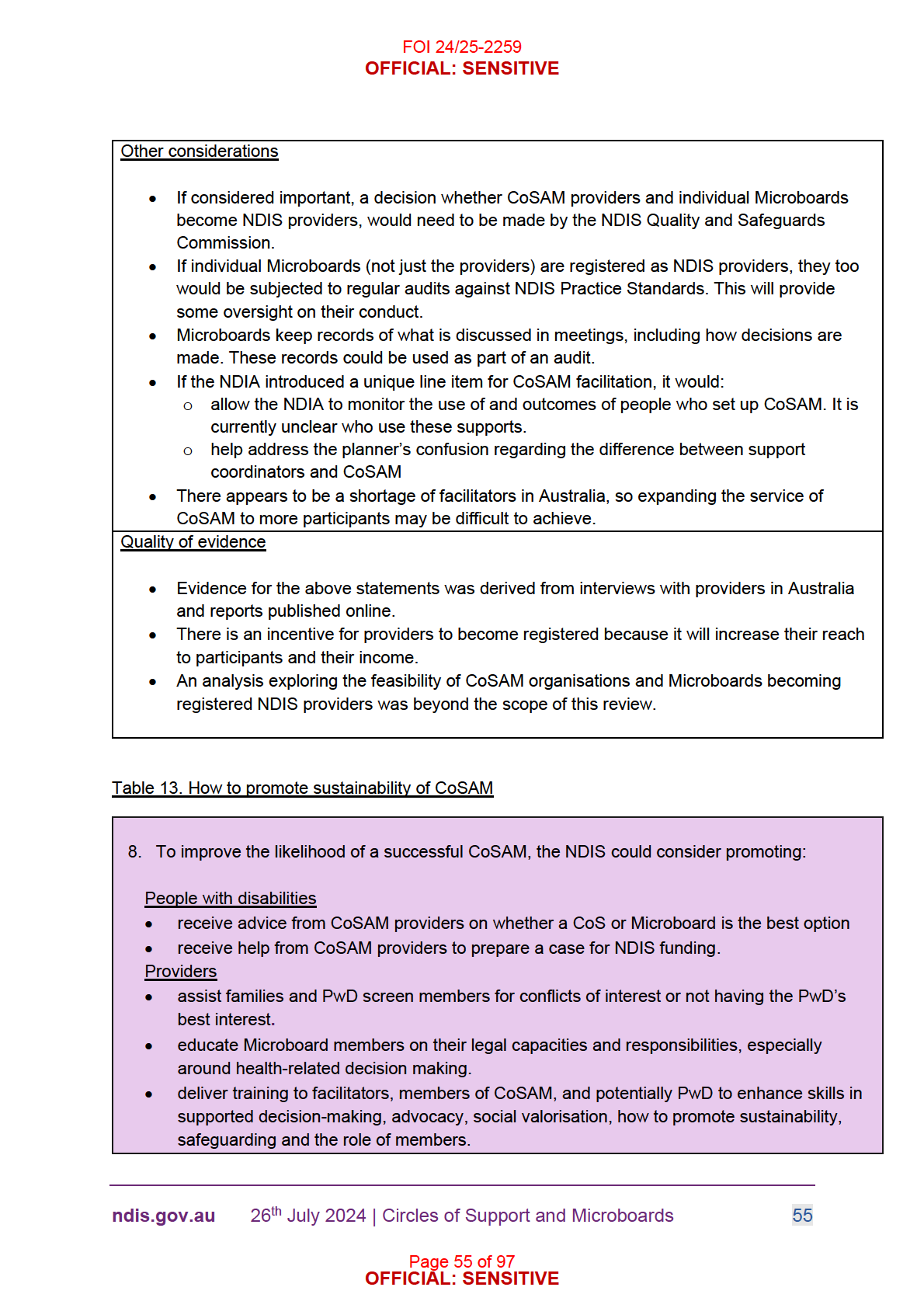
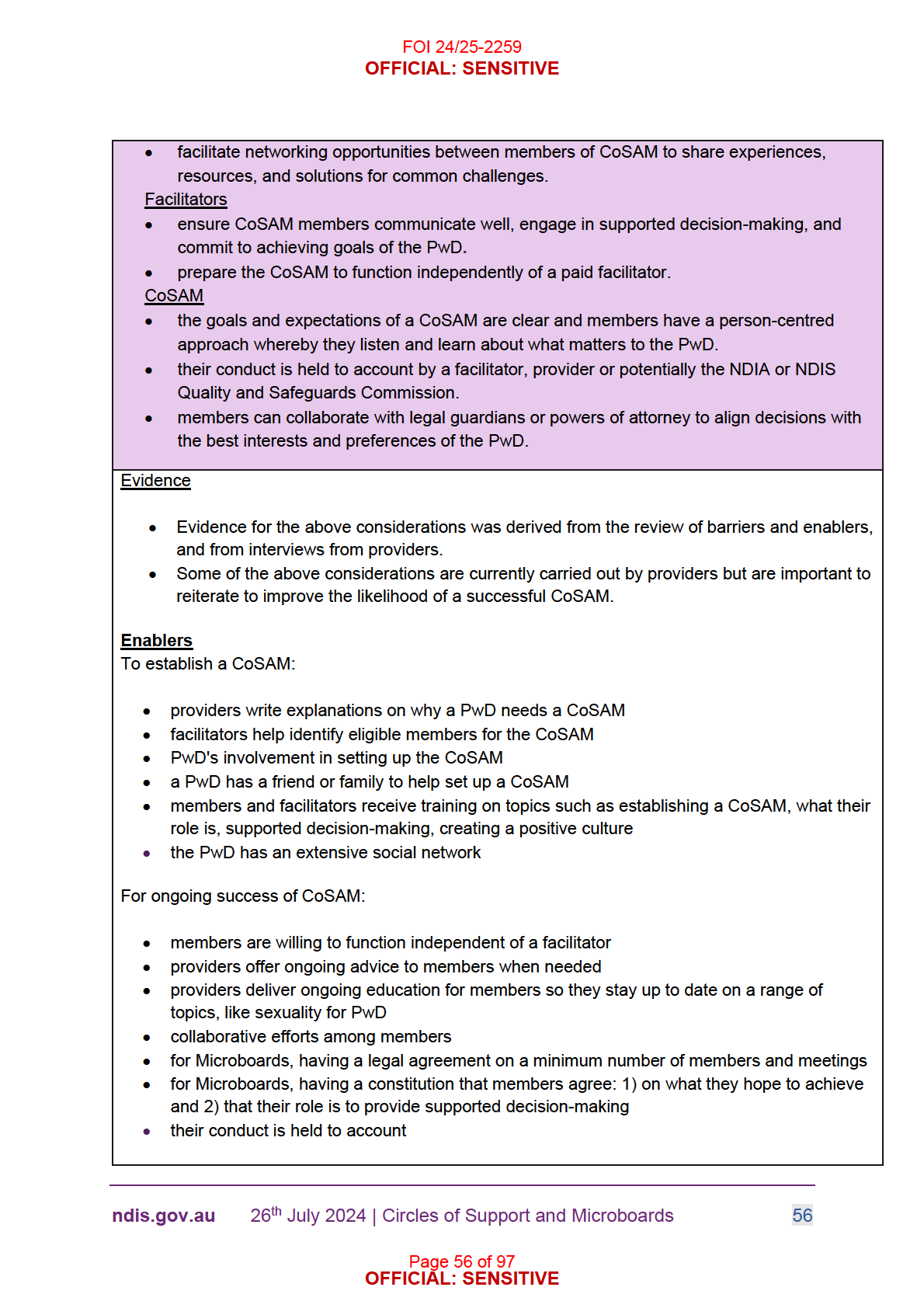
FOI 24/25-2259
OFFICIAL: SENSITIVE
Barriers
Relating to the NDIS:
• explaining to NDIS planners why a CoS or Microboard is needed can be difficult for PwD and
their family or carers. They may not be able to present a convincing case without help from a
provider
• confusion by NDIS planners regarding the role of facilitators versus support coordinators
• inconsistent and delayed funding decisions by NDIS
Other barriers:
• finding suitable members
• for Microboards, not having the minimum number of members needed, 5 or 6
• not enough facilitators
• time commitment of members
• administrative challenges such as managing employees
• support workers and family not understanding the significance of friendships and failing to
provide the support necessary to form and maintain these relationships (prior to establishing
CoSAM)
• conflict within the group
• lack of evidence on different models of
a CoSAM
• limited authority to represent the decisions of a PwD, it requires guardianship or power of
attorney
• it may take < 2 years to be see benefits
• limited capacity of PwD who have high support needs to be socially active
Other considerations
• How the NDIA could address the above considerations was not explored in this review.
• If the NDIS Quality and Safeguards Commission decides that CoSAM providers should
become registered NDIS providers, they could use the above information to design guidance
and best practice information for these organisations as part of their registration
responsibilities.
Quality of the evidence
• The evidence primarily stemmed from qualitative studies and reports involving interviews
with PwD, their families or carers, and facilitators.
• Sample sizes were small, with a median of 5 for PwD and 16 for parents, members, or
facilitators.
• Quotes were often used to substantiate findings, although some outcomes were presented
without quotes
, or they were quotes of made by authors in other papers
.
ndis.gov.au
26th July 2024 | Circles of Support and Microboards
57
Page 57 of 97
OFFICIAL: SENSITIVE
FOI 24/25-2259
OFFICIAL: SENSITIVE
6. Limitations of this evidence
The limitations of the findings on CoSAM include:
1.
Methodological constraints: mostly qualitative data identified, with very little
quantitative data on the effectiveness of CoSAM.
2.
Risk of reporting bias: results may be biased if the researchers were funded
by CoSAM organisations
3.
Data quality and availability: no data on long-term benefits versus harms, cost-
effectiveness, and comparisons with alternative supports such as support
coordinators.
4.
Limited perspectives: we only conducted interviews with providers. It may
have been helpful to interview PwD, carers or families, support coordinators,
planners, and advocates.
5.
Complexity of the intervention: the benefits of CoSAM may take years to
materialise.
6.
Recognising diversity in supported decision-
making: the lack of data on First
Nations people, individuals identifying as LGBTIQ, and from CALD
backgrounds, makes it difficult to know if or how the CoSAM needs to be
adapted for these groups.
7.
Populations studied: limited data on different cohorts of PwD, so it is
difficult to know if CoSAM are not suited for some groups.
8.
Evidence summary: this is not a systematic review, the quality of the papers
was not formally assessed, nor did we conduct a thematic analysis of the
qualitative evidence.
9.
Grey literature: more than half of the data sources were from the grey
literature, thus they were not peer-reviewed.
7. Strength of evidence
The evidence identified for this review was mostly anecdotal, but it provided rich data
on the experiences of CoSAM among PwD, their families or carers, and facilitators.
The experiences from PwD, their families, and carers were predominantly positive,
thus adding reassurance that the intended beneficiaries of CoSAM are seeing the
benefits. A key report that informed our understanding of the legal complexities and
potential risks or harms of CoSAM was a Canadian study by Nunnelly for the Ontario
Law Commission [27]. A significant amount of information came from interviews with
seven CoSAM providers in Australia and Canada, who shared detailed insights
based on their extensive experience, ranging from a few years to over a decade.
ndis.gov.au
26th July 2024 | Circles of Support and Microboards
58
Page 58 of 97
OFFICIAL: SENSITIVE
FOI 24/25-2259
OFFICIAL: SENSITIVE
These providers were generally well-informed and were open to answering all
questions, including any follow-up queries, and were willing to meet again if needed.
8. Research gaps
The following research gaps were identified from this evidence summary:
• Long-term outcomes of individuals who set up a CoSAM and compare these
to other decision-making supports (i.e., peer-support groups, mentoring,
decision-making coaches) and usual supports (i.e., support coordinators).
• Well-designed studies, such as RCTs or prospective cohort studies, that use
validated tools to measure outcomes, including quality of life and a cost-
effective analysis.
• A research program to understand how to build social connections for
people with intellectual or cognitive disabilities, communication issues and
complex needs, who do not have existing strong family or informal
relationships, should be funded as a priority.
• NDIA data on the outcomes of PwD who use CoSAM.
• Insights from support coordinators and advocates on how they understand
their role is distinct from and/or complements a CoSAM.
• The effectiveness and/or appropriateness of CoSAM in different cohorts of
PwD, CALD and First Nations’ people.
9. Next steps
This evidence review provides an overview of the published research, grey literature,
alongside the providers perspectives on the implementation and effectiveness of
CoSAM for supported decision-making. The review highlights some positive findings
supporting the use of CoSAM in intellectual disabilities, cognitive disabilities,
communication issues or complex needs cohorts, but the evidence is low to
moderate quality owing to the lack of well-designed long-term studies, revealing
research gaps and areas of uncertainty.
In the absence of strong research evidence and the need to consider other forms of
evidence (e.g., agency data, additional participant perspectives from the NDIS, and
other expert voices in supported decision-making), it may be worthwhile to develop
an evidence-to-decision framework with an advisory panel with people such as topic
experts, providers, support coordinators, advocates, researchers, PwD, planners,
and members from TAPIB, the policy team, Pricing Reference Group and NDIS
Commission. This panel would deliberate on various forms of evidence to produce
ndis.gov.au
26th July 2024 | Circles of Support and Microboards
59
Page 59 of 97
OFFICIAL: SENSITIVE
FOI 24/25-2259
OFFICIAL: SENSITIVE
evidence-based advice and recommendations, that can inform policy and operational
guidelines. This approach will create a structured and transparent decision-making
process, building trust and credibility in the decisions and recommendations,
especially where uncertainty exists.
ndis.gov.au
26th July 2024 | Circles of Support and Microboards
60
Page 60 of 97
OFFICIAL: SENSITIVE
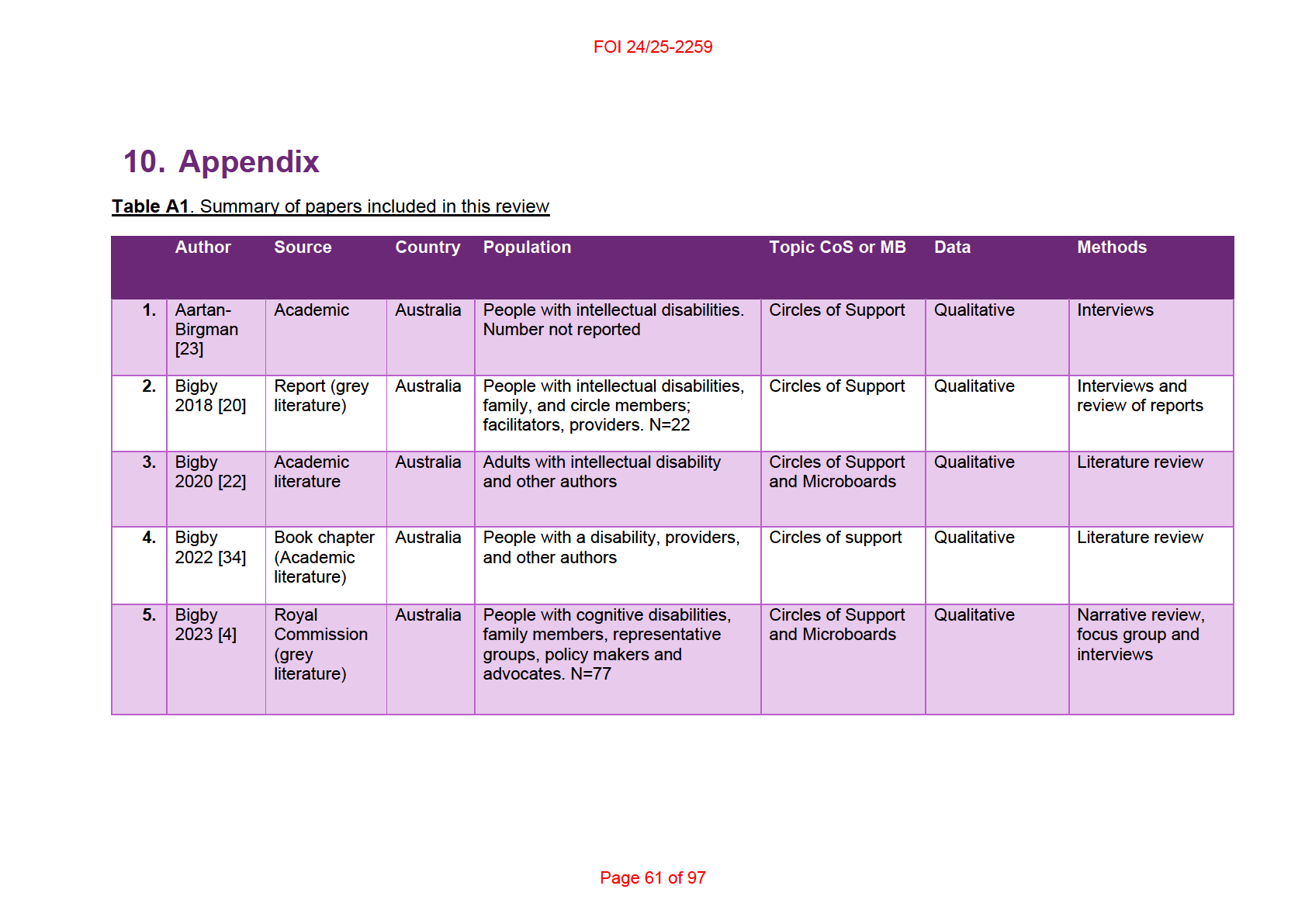
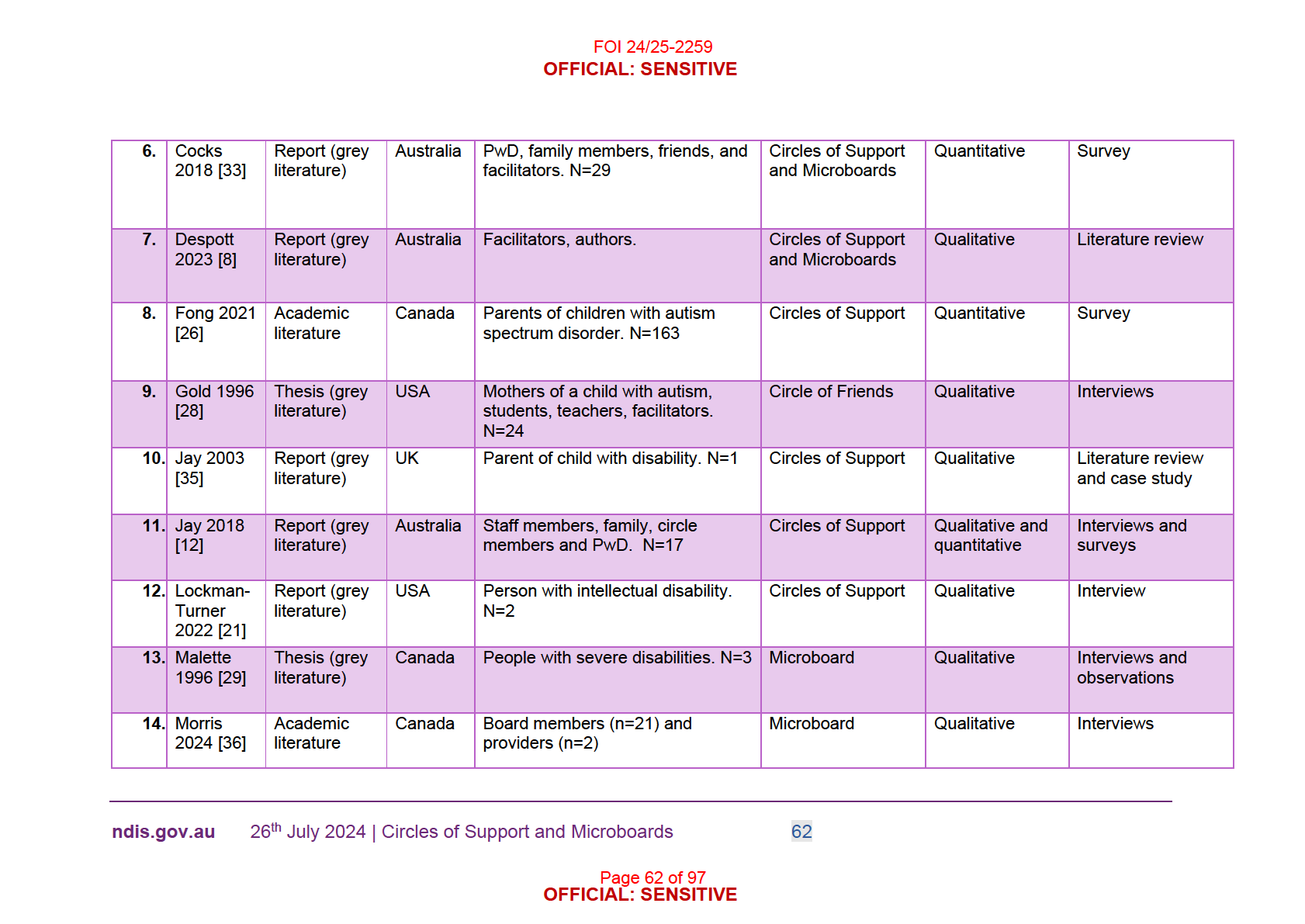
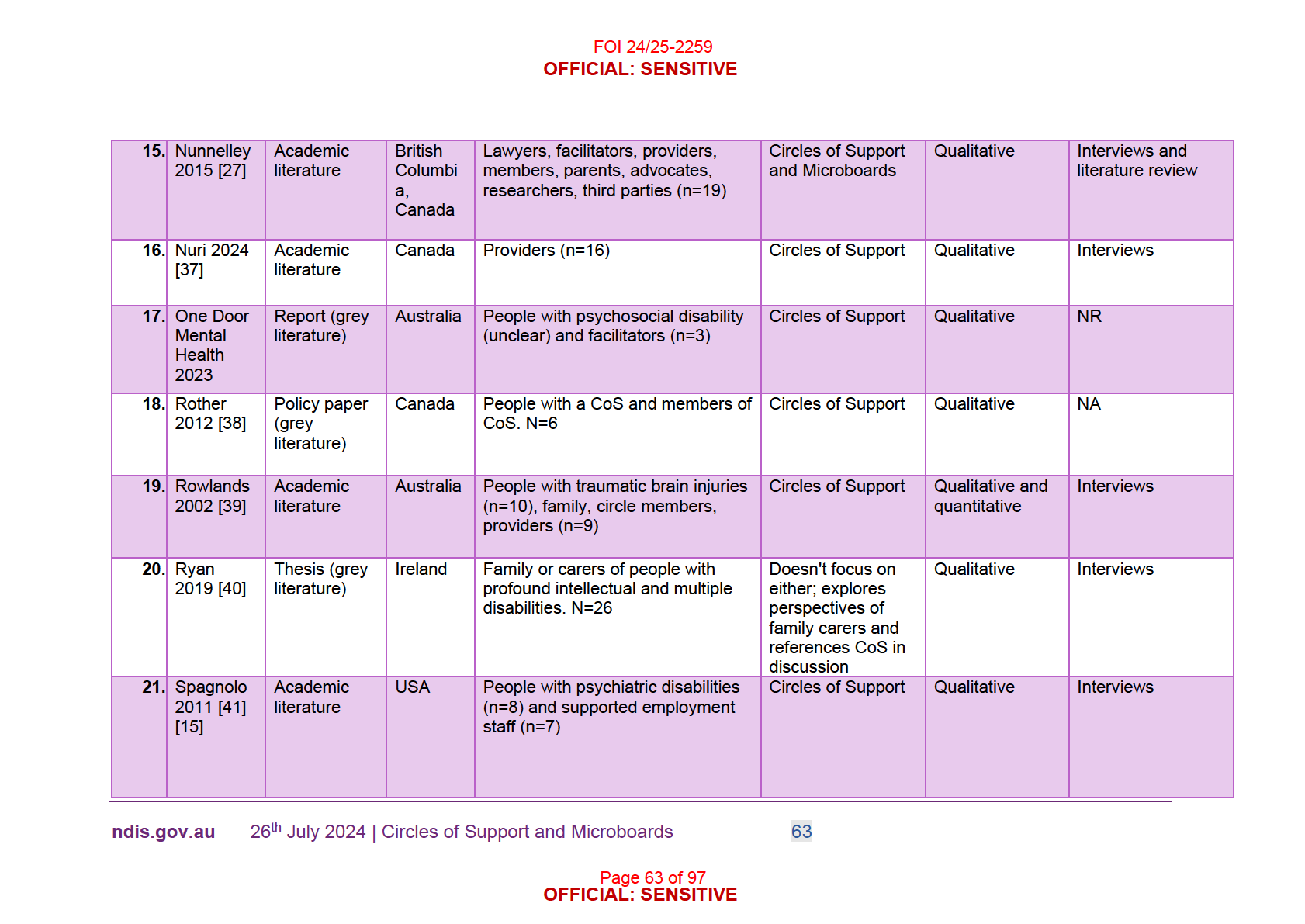
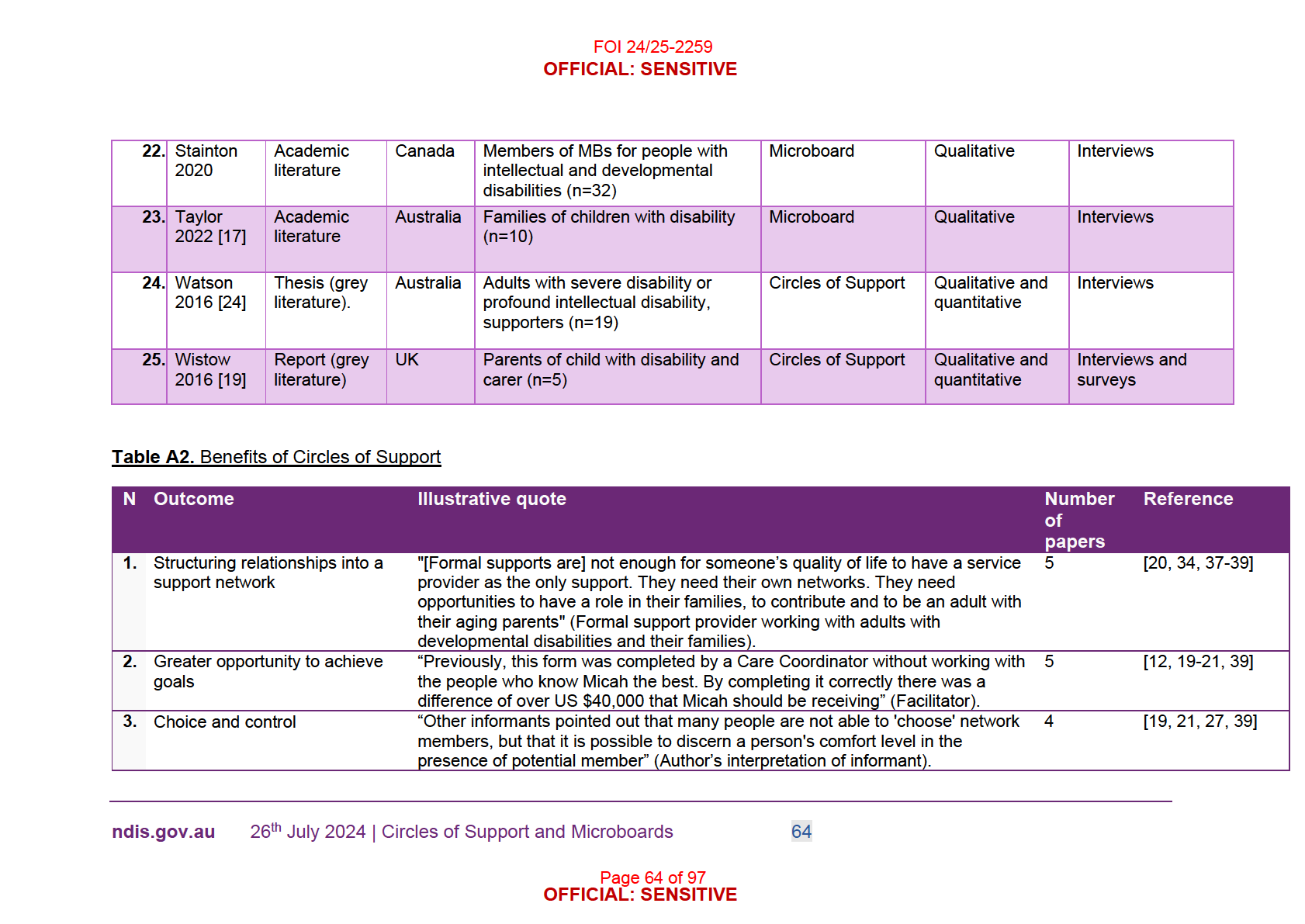
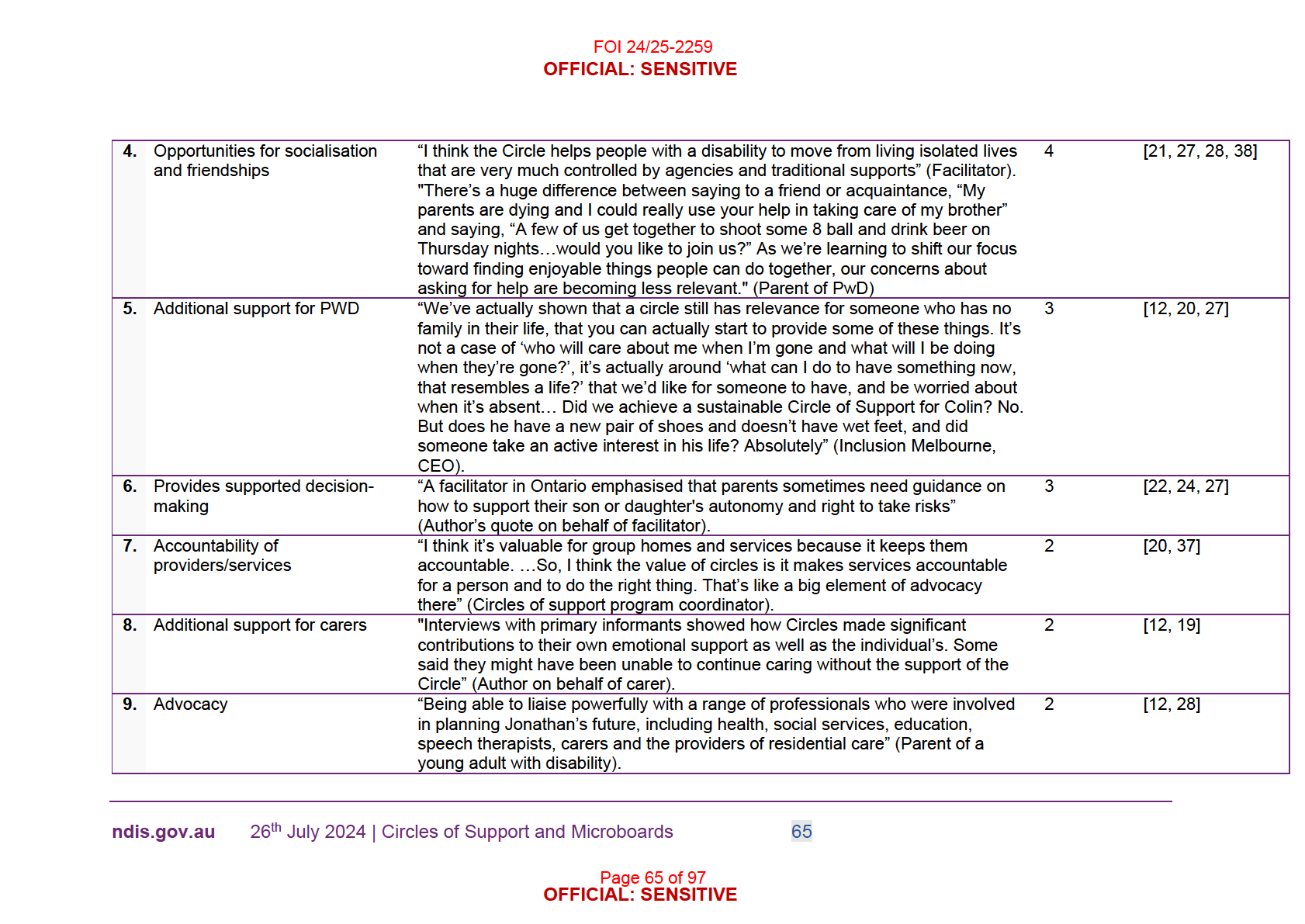
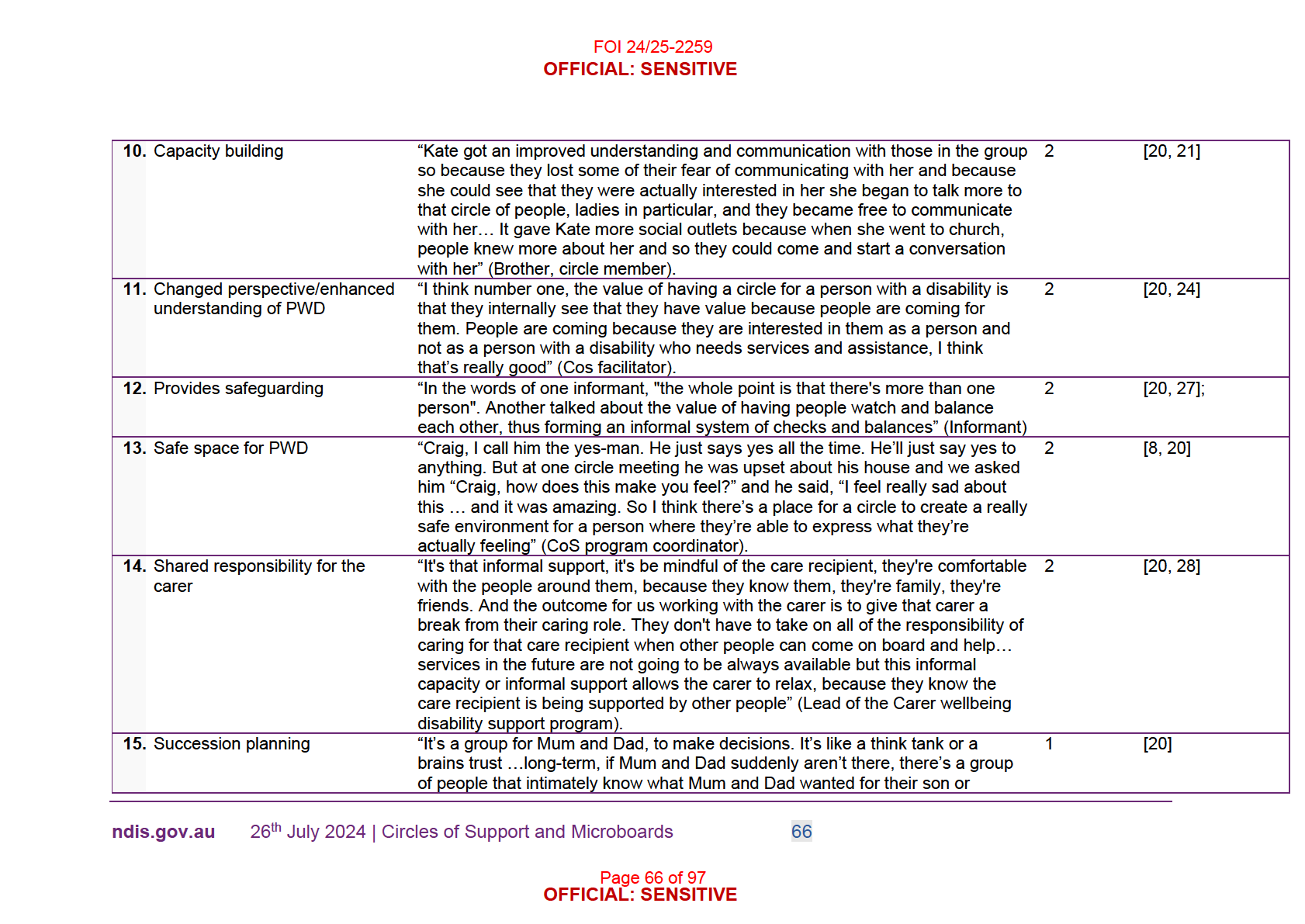
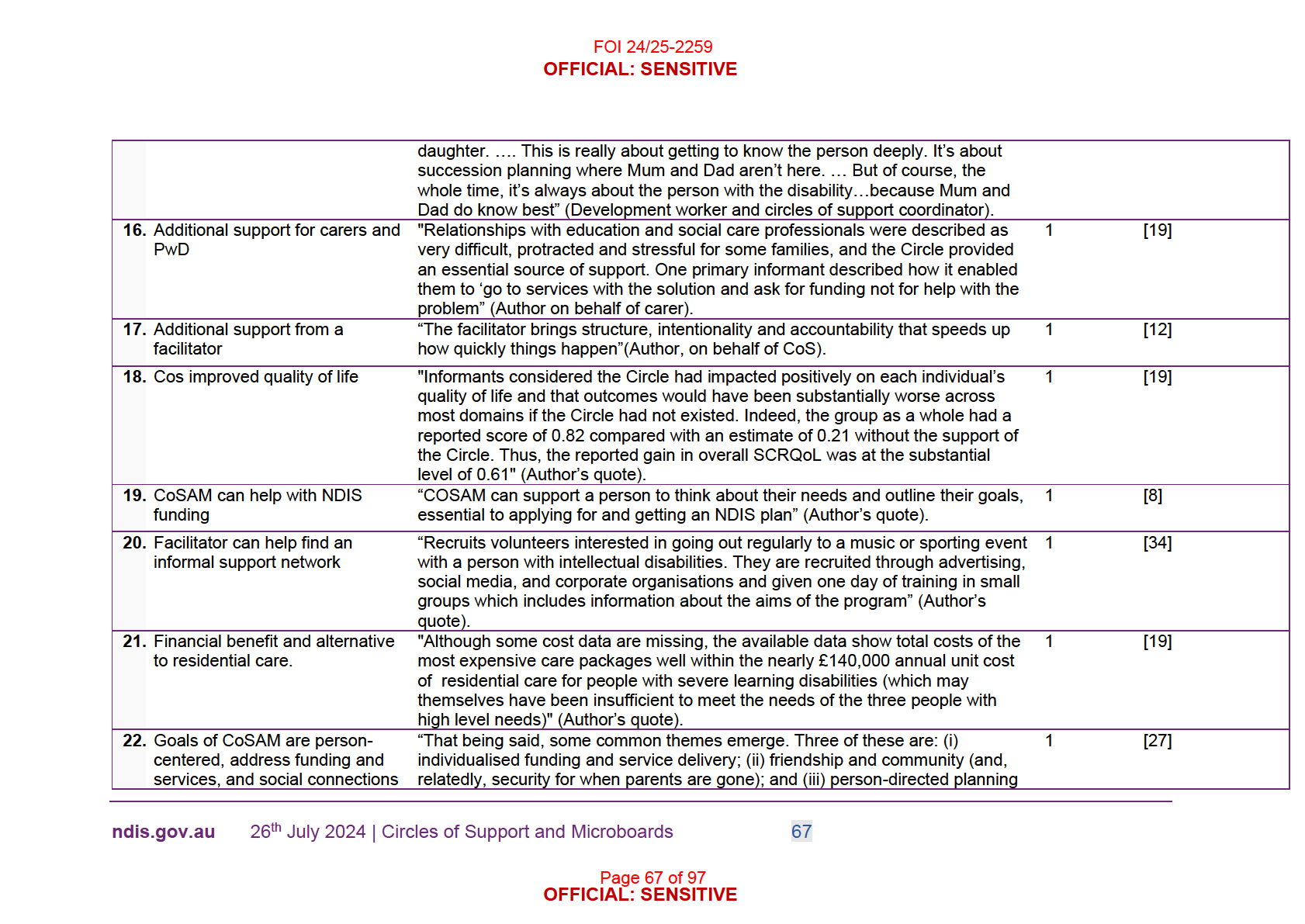
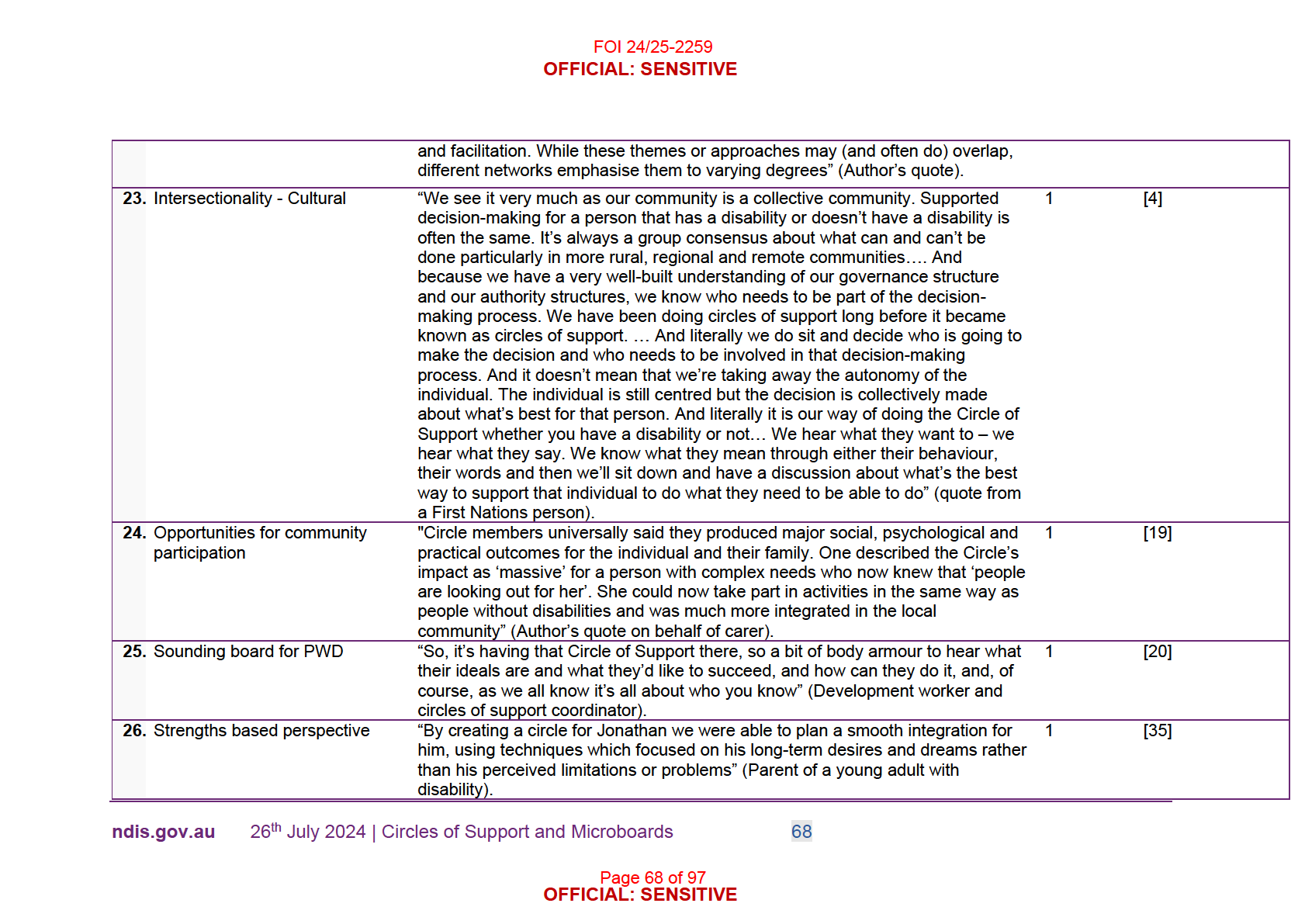
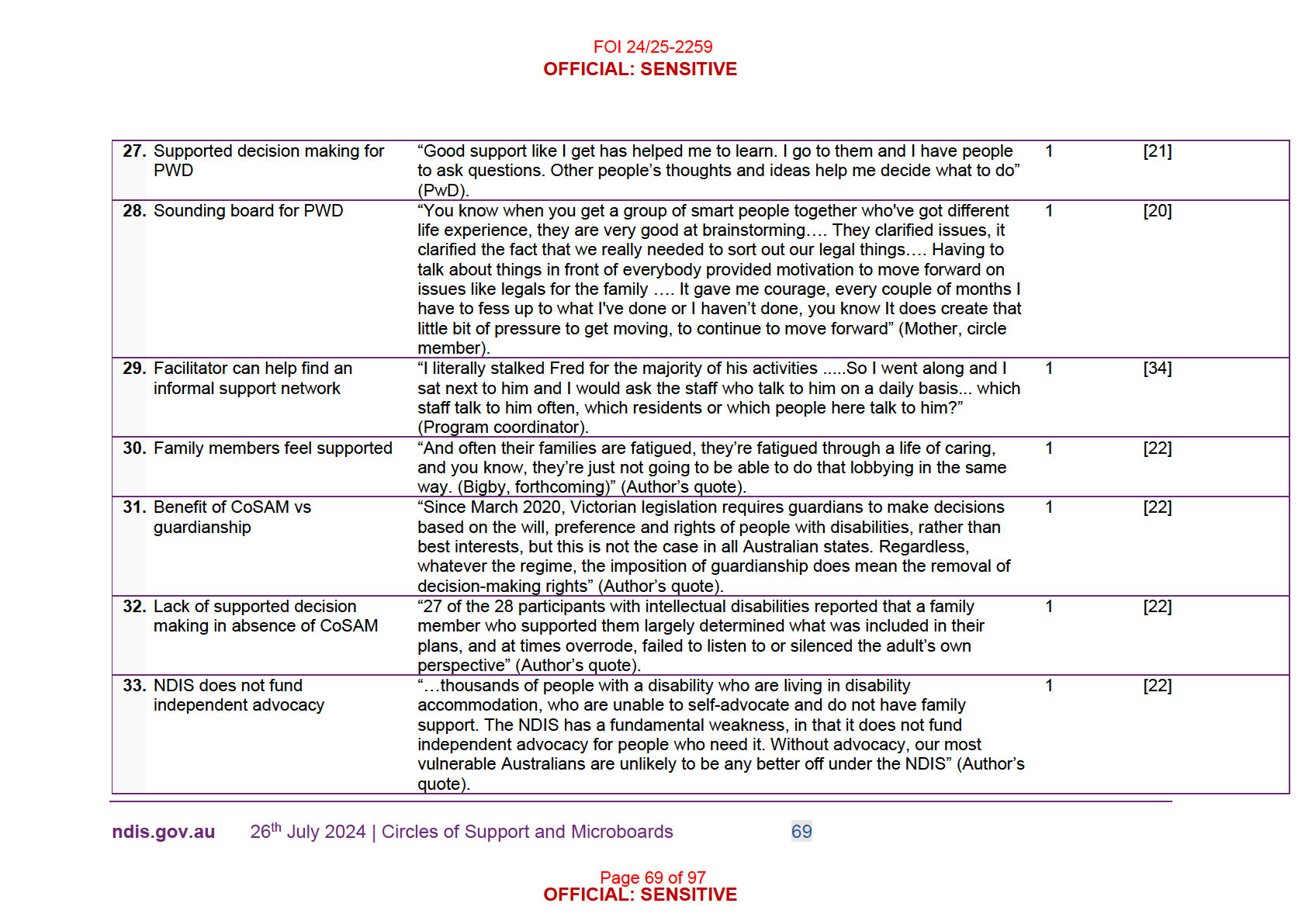
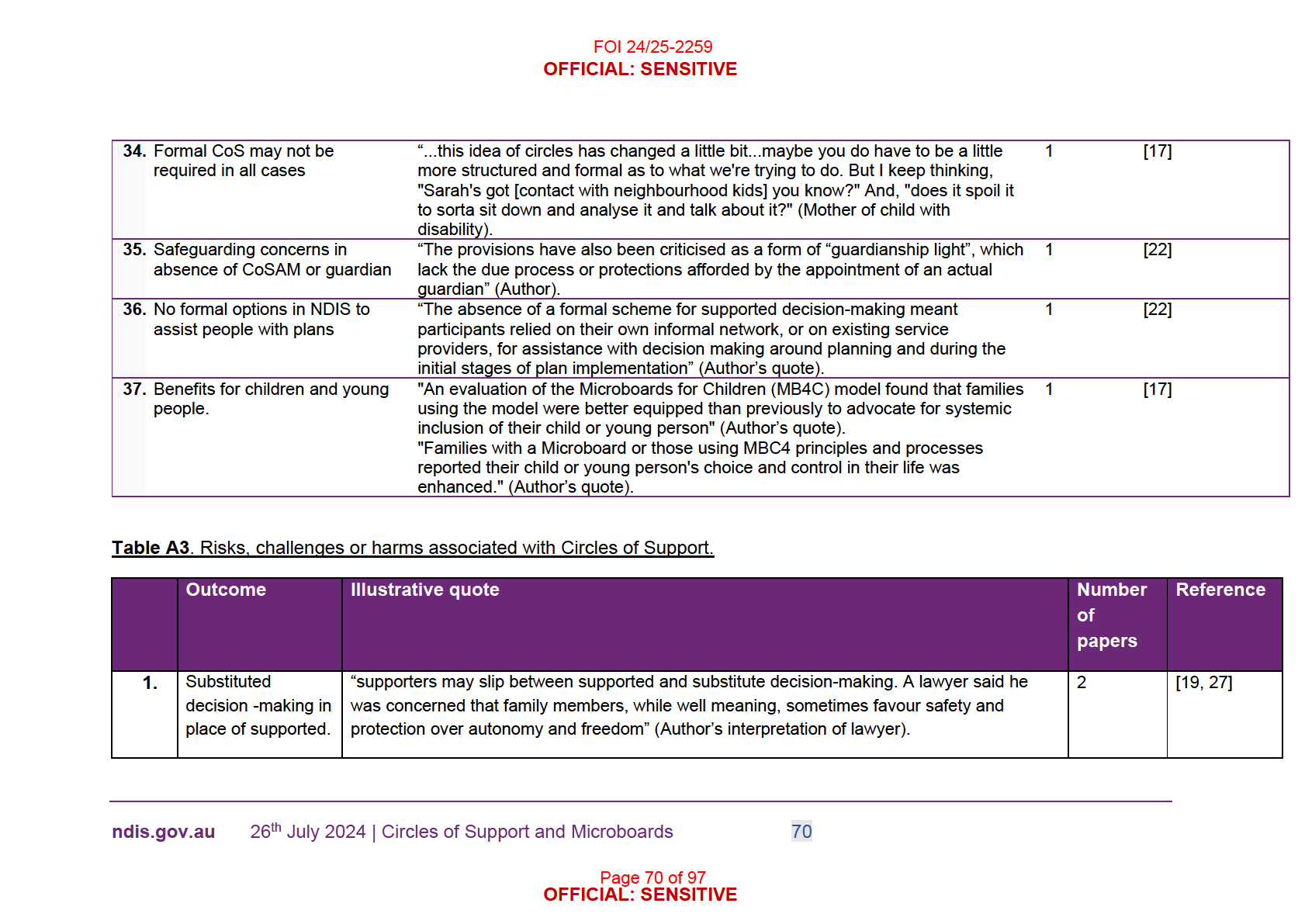
FOI 24/25-2259
OFFICIAL: SENSITIVE
2. Focus on parental
“However, it has also been found that some circles of support are established to support
2
[4, 27]
decision-making
parental decision-making rather than that of the person with disability” (Author’s quote).
3. Activities with PwD “I knew things were good at school because a lot of kids knew him and they all talked to him
1
[28]
are not carried out
and all that...But at home like the whole summer no one called on him, no one phoned, no
one came to the door, you know, or, or anything! Like I know they all have their different and
busy with this and they were away and everything else, but it, like so far it hadn't affected his
home life...” (Parent of child with disability).
4. Difficulty of
“A difficult question is the apportionment of legal responsibility for decisions made through
1
[27]
knowing how much supported decision-making. Responses are to some degree linked to the model of supported
a PwD is legally
decision-making adopted, and the role that supporters are expected to play. One approach is
responsible for a
to say that the decision is that of the person, and that therefore that person bears the full
decision when they responsibility for the decision: critics argue that this approach can lead to troubling moral
have significant
outcomes where some persons with significant levels of vulnerability may be liable to suffer
vulnerabilities
substantial legal consequences despite not having understood the risks associated with the
decision. Another approach is to emphasise the interdependent nature of decisions made
through a supported decision-making approach” (Law Commission of Ontario).
5. Formal CoS may
...this idea of circles has changed a little bit...maybe you do have to be a little more structured 1
[28]
not be required in
and formal as to what we're trying to do. But I keep thinking, "Sarah's got [contact with
all cases
neighbourhood kids] you know?" And, "does it spoil it to sorta sit down and analyse it and talk
about it?"
6. Lack of clarity
“The grey literature on Circles of Support contains anecdotal stories of success but does not
1
[34]
around who CoS
adequately consider the specific groups of people whom programs target” (Author’s quote).
benefit
ndis.gov.au
26th July 2024 | Circles of Support and Microboards
71
Page 71 of 97
OFFICIAL: SENSITIVE
FOI 24/25-2259
OFFICIAL: SENSITIVE
7. Lack of consent of
“Whatever the impetus, the supported person might have varying levels of ability to agree or
1
[27]
PwD to CoSAM
consent to the network's creation. One informant, a facilitator, said that consent is essential,
as there is risk inherent in opening one's most private details to group discussion; while this
can provide support, it also brings a measure of accountability for decisions because the
members are now 'watching” (Facilitator).
8. Not sustainable.
“We’ve actual y shown that a circle stil has relevance for someone who has no family in their
1
[20]
life, that you can actual y start to provide some of these things. It’s not a case of ‘who wil care
about me when I’m gone and what wil I be doing when they’re gone?’, it’s actually around
‘what can I do to have something now, that resembles a life?’ that we’d like for someone to
have, and be worried about when it’s absent… Did we achieve a sustainable Circle of Support
for Colin? No. But does he have a new pair of shoes and doesn’t have wet feet, and did
someone take an active interest in his life? Absolutely” (CEO, Inclusion Melbourne).
9. Members of CoS
“If decision-making is an interdependent process and if a person has a support network
1
[27]
bear some ethical
assisting them to make decisions, it can be argued that the members of the support network
responsibility for
should bear at least some ethical responsibility for the decisions made, unless they formally
the decisions made distance themselves from the decision. The question of legal responsibility arises if decisions
with legal ramifications are being made, for example decisions involving a financial contract,
decisions requiring formal consent or decisions that may result in a person having a civil
action brought against them. An alternative form of supported decision-making is to establish
the support network as an Incorporated Association. Under this arrangement, all the members
of the network take responsibility” (Office for Public Advocate for Victoria).
10. Opportunities for
“One of the primary worries, even for those advocating supported decision-making, is the
1
[27]
financial or other
potential for coercion or other inappropriate influence by a representative or supporter.
abuse even with
Exploitation and abuse certainly occur in guardianship context (although it is unclear how
supported
frequently), and supported decision-making arrangements create new opportunities for abuse.
ndis.gov.au
26th July 2024 | Circles of Support and Microboards
72
Page 72 of 97
OFFICIAL: SENSITIVE
FOI 24/25-2259
OFFICIAL: SENSITIVE
decision-making
Indeed, when we turn to more informal arrangements such as supported decision making,
models
which may occur in private and with less accountability, the potential for financial or other
abuse likely increases” (Author’s quote).
11. Power CoS can
“Where the individual had capacity, his/her views were of prime importance, but where
1
[19]
have to make
someone could not speak for him/herself, the Circle had 'huge power’ to provide solutions”
decisions
(Author’s quote).
12. PwD may not feel
“an independent facilitator in Ontario said she is cautious about recommending "circles" in
1
[27]
comfortable in
any defined sense, as these often don't work, either for the supported person or for members.
groups
She said that expecting a group of people to come together on a regular basis is often
unrealistic, and many supported persons don't feel comfortable in groups in any event”
(Author’s interpretation of facilitator).
13. Unrealistic
“an independent facilitator in Ontario said she is cautious about recommending "circles" in
1
[27]
expectations of
any defined sense, as these often don't work, either for the supported person or for members.
people to commit
She said that expecting a group of people to come together on a regular basis is often
to CoS
unrealistic, and many supported persons don't feel comfortable in groups in any event”
(Author’s quote based on facilitator).
14. Expenses
“Program 2 experienced a particular chal enge in this respect if the person had no existing
1
[23]
expected to be
informal network members and when potential circle members met venues such as cafés,
paid for by
they expected associated costs would be covered either by the program or by the person.
coordinator
Costs such as these were not accounted for in the program budget, which often resulted in
the coordinator paying them from her own pocket”. (Author’s quote based on facilitator).
ndis.gov.au
26th July 2024 | Circles of Support and Microboards
73
Page 73 of 97
OFFICIAL: SENSITIVE
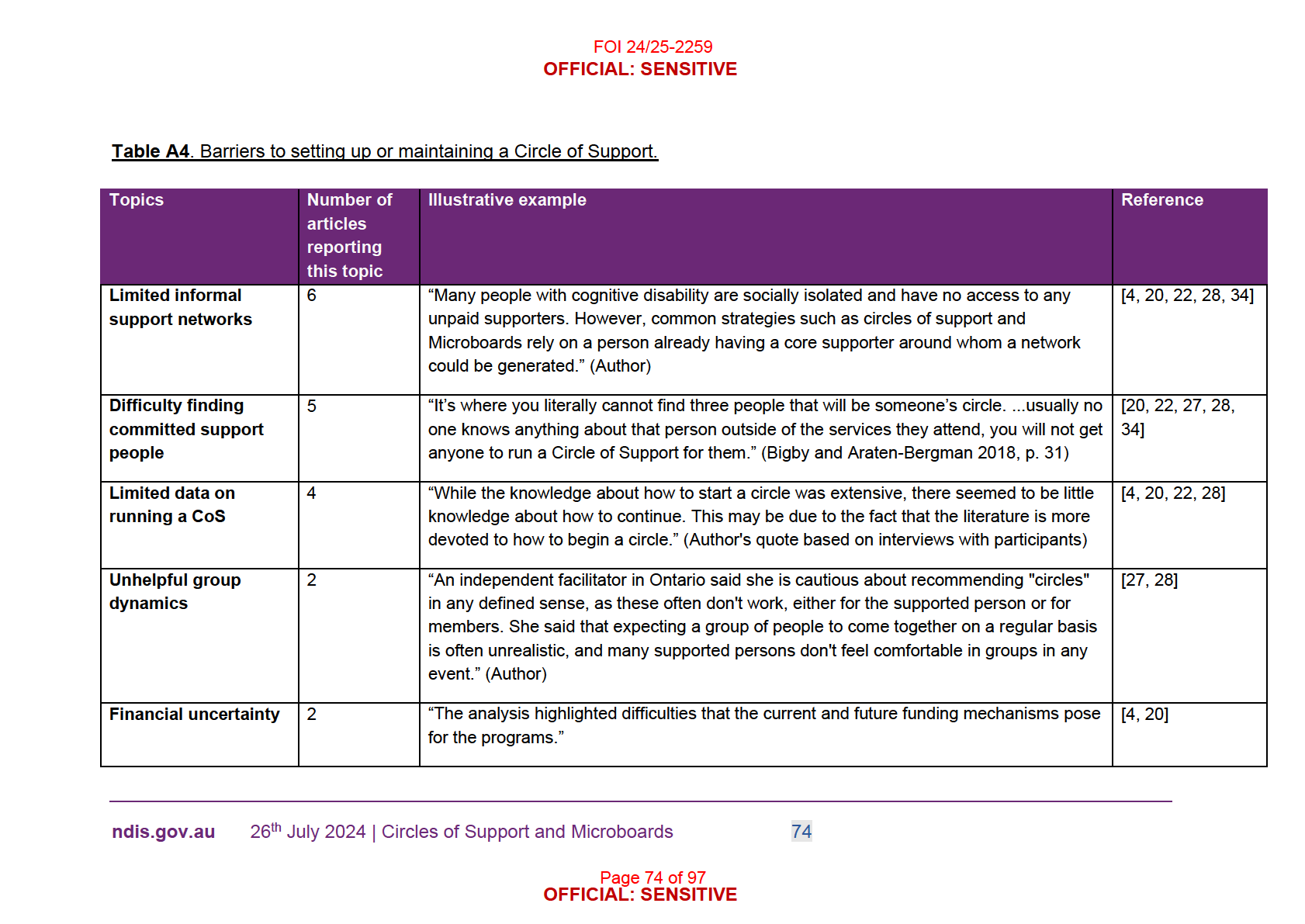
FOI 24/25-2259
OFFICIAL: SENSITIVE
Practical and
2
“Several informants talked about the chal enges of keeping even informal groups of
[27, 28]
emotional
family and friends consistently involved.” (Author's quote from informants [on CoSAM])
sustainability
Upskilling
2
“We would meet at 3:30 after a long day, a social worker would only want to talk about
[20, 21]
requirements
things that I wasn’t doing well so we had to talk about how that is not what a Circle does.”
(PwD)
Prioritising support
2
“If a person is not known and cared for then they are usually ‘done for.’ Service providers [38]
above cultivating
need to learn that welcoming people into the lives of the individuals they serve is as
personal
important as administering their medication and clipping their toenails” (Carer of PwD).
relationships
Ineffective
2
“84% (n=15) of times a supporter was found not to respond to the person’s expression of [20, 28]
coordination and
preference they were supporting, it was because they “had not acknowledged or noticed
facilitation
the person’s expression of preference” (Author).
Providers will only
1
“Program 1 was part of an organisation with a strong mission to support families and this
[23]
work with PwD who
was reflected in the program logic. The program (delivered by providers of CoSAM)
have family
focused on supporting families to ensure continuity of informal support across the
lifespan, with the rationale that if the family were well supported the person with disability
would benefit.” (Author)
Support varies across 1
"My daughter is 22. We had a lot of support in school, but when she graduated, I realised [38]
developmental stages
that adult services provided a tenth of that. Before I heard about networks, I wasn’t aware
that my child was so isolated. But she is. It has been a real eye opener for me. I’ve seen
that government and services won’t be there and won’t care for her as an individual"
(Carer of PwD).
ndis.gov.au
26th July 2024 | Circles of Support and Microboards
75
Page 75 of 97
OFFICIAL: SENSITIVE
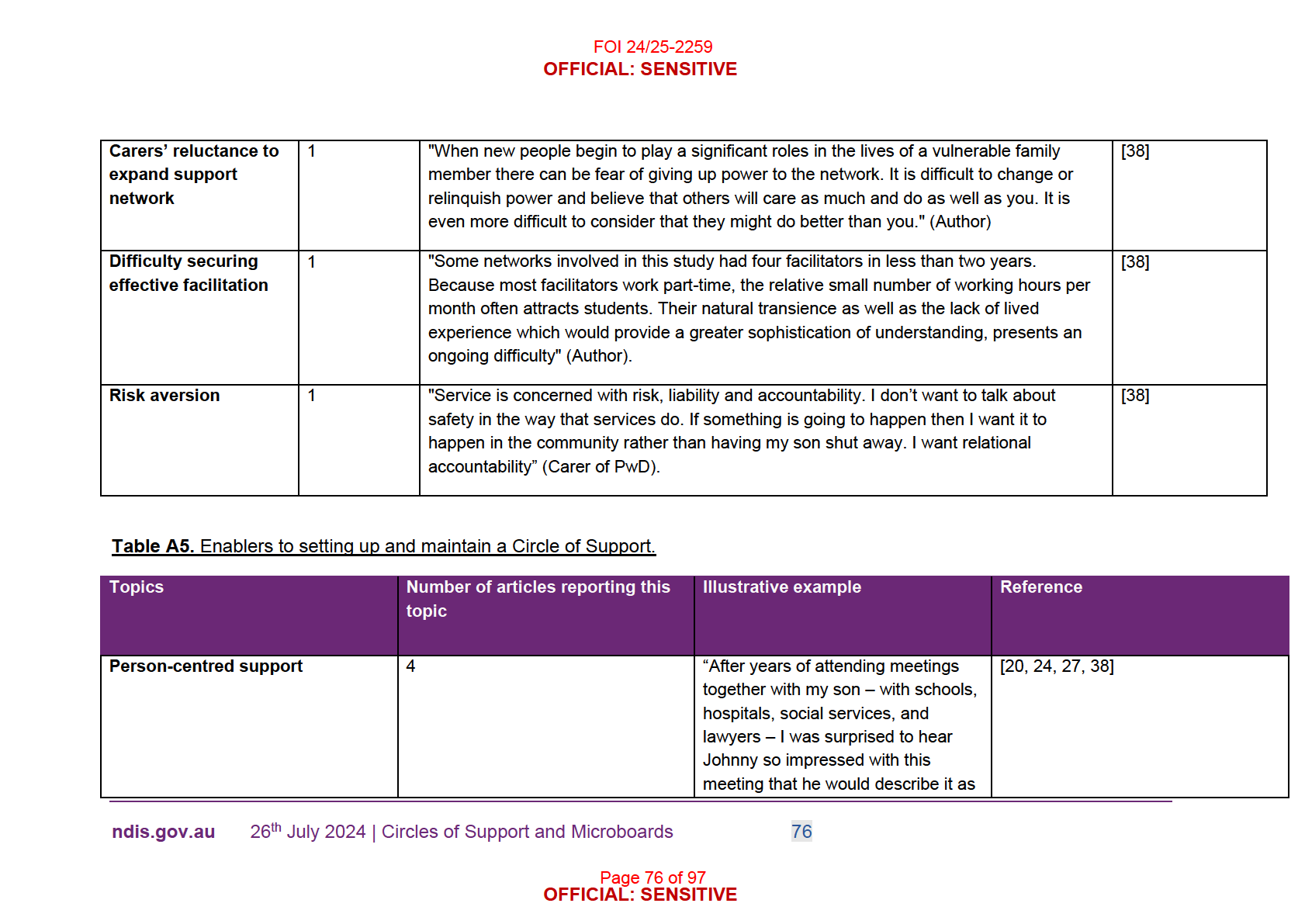
FOI 24/25-2259
OFFICIAL: SENSITIVE
‘great.’ When asked why this one
was different, he said, ‘This is the
first meeting where people listened
to me’” (Parent of PwD).
Effective facilitation
4
“Helping develop a positive
[8, 21, 24, 28]
perception of the person’s ability to
communicate and participate in
decision making, manage conflict
between supporters and provide a
leadership role in “pul ing it all
together” (Supporter in Circle of
Support).
Stong social network
4
"We did a social inventory of our life
[20, 21, 28, 38]
and that of our son’s. We had a
whole whack of names. It was
overwhelming. If we had invited
everyone, we’d have had to rent a
hal ." (Parent of PwD)
Relationship among members
3
“You have a circle meeting, you find
[20, 24, 38]
out that every single person in that
circle only knows the tiniest little
miniscule thing about that person, so
you spend the next four or five
months just pretty much socialising.”
(Bigby and Araten-Bergman 2018)
ndis.gov.au
26th July 2024 | Circles of Support and Microboards
77
Page 77 of 97
OFFICIAL: SENSITIVE
FOI 24/25-2259
OFFICIAL: SENSITIVE
Collaboration
2
“You can’t make life-altering
[24, 27]
decisions if you’re separated, if you
have day service and home. You
can’t make life-altering decisions if
you are only looking at one
perspective. So that’s why the
collaborative approach, because
holistically to make up one person
we have to take into account what
happens during the day as wel as
what happens at home.” (Supporter
in Circle of Support)
Flexibility among staff
1
“Staff emphasised their flexibility
[23]
in arranging their time according
to the requests of people with
intellectual disabilities, families
and circle members” (Author’s
interpretation of facilitators)
“staff conveyed an extremely high
commitment to the program and
willingness to work beyond the
boundaries of their budgeted time
and role to promote circle
ndis.gov.au
26th July 2024 | Circles of Support and Microboards
78
Page 78 of 97
OFFICIAL: SENSITIVE
FOI 24/25-2259
OFFICIAL: SENSITIVE
activities” (Author’s interpretation
of facilitators)
Flexibility among circle members
1
“Many activities associated with
[23]
Circles of Support rely on the
availability of family or circle
members and happen after office
hours.” (author’s interpretation of
family members)
Communication skills
1
“It’s those people skil s, whoever sits [20]
in a Circle of Support needs to have
very good listening skil s, you know
what’s said, what isn’t said, real y
strong observation skil s, very good
communication skil s and ability to
be able to negotiate …. but it’s that
social and community framework
real y, ability to be nimble and a bit
flexible when needed. So sometimes
you think, you know you’re heading
in one direction and you’re going to
have to shift a little bit somewhere
else and also that you don’t have
ownership over it and you’re not
there to fix anyone just to help.”
ndis.gov.au
26th July 2024 | Circles of Support and Microboards
79
Page 79 of 97
OFFICIAL: SENSITIVE
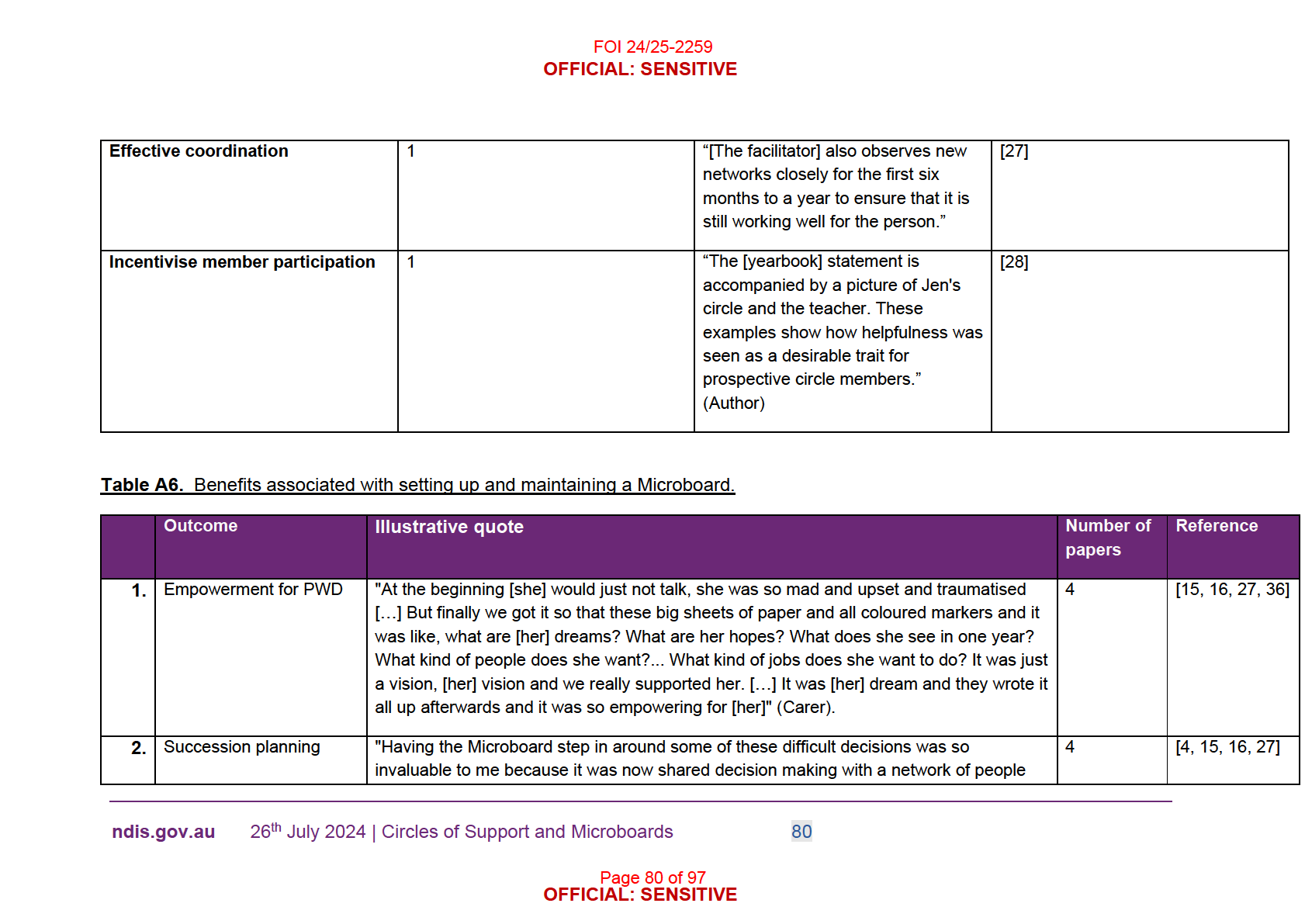
FOI 24/25-2259
OFFICIAL: SENSITIVE
bringing a variety of perspectives. I felt real y well supported and I kind of feel like [my
husband] and I could die because we’ve got these very committed people overseeing
[our daughter’s] life and services and supports. You know, it’s so comforting to us to
share this with people who have made such commitments to [her] life and that’s huge for
me" (Carer).
3. Supported decision
She explained that supported decision-making represents a paradigm shift for many
3
[22, 27, 29]
making
families, who are not accustomed to truly respecting their relative's wishes” (Author’s
quote based on provider).
4. Additional support for
"He knows his community, he knows his rec centre, he knows all of his neighbours,
3
[15, 27, 34]
PWD
everybody at the shopping centre. […] There’s somebody else that knows where he’s
gone, he has all of those people’s numbers and things on his phone that if he needed
some help and he couldn’t get a hold of his home share or a friend or whatever, he
knows who he could talk to" (Carer).
5. Choice and control for
"with the microboard I feel I am the key decision maker. Respect and choice are the most 3
[17, 27, 29]
PWD
important to me. I am more respected now, and I have more respect for myself. I like it a
lot better than a group home. I can do what I want, whenever I want, as part of the
community” (PwD).
6. Opportunities for
“Participants identified changes in several areas since the development of the
3
[27, 34, 36]
socialisation and
microboard, including improvements in social and professional relationships and
friendships
community inclusion, as well as wel being, safety, stability, and self-determination of the
person being supported” (Author).
ndis.gov.au
26th July 2024 | Circles of Support and Microboards
81
Page 81 of 97
OFFICIAL: SENSITIVE
FOI 24/25-2259
OFFICIAL: SENSITIVE
7. Additional support for
"An evaluation of the MB4C model by Deakin University (reported elsewhere), found that 3
[15, 16, 22]
carers
families using the model were better equipped than previously to advocate for systemic
inclusion of their child or young person" (Author’s quote).
8. Safeguarding
“…to get real y good supported decision-making, they wil need and have more people in 2
[4, 27]
their life, more people around them, whether that’s formally in a circle or a microboard, or
whether it’s just an informal network. But by having those people, the more eyes there
are on a person who’s got vulnerabilities, the safer they are, the less open to abuse and
neglect”. (Family of PwD)
9. Ability of PwD to choose
“Other informants pointed out that many people are not able to 'choose' network
1
[27]
network members
members, but that it is possible to discern a person's comfort level in the presence of
potential member” (Author’s interpretation of provider’s quote).
10. Advocacy/Additional
"I think what the function of the Microboard is to surround an individual, to support them,
1
[15]
support for PWD
to connect them, to make sure that they have a voice, that not only their needs are being
met but that what they want to accomplish in life. We support them in accomplishing
those things, whatever goals they have again we support them in accomplishing them to
the best of their ability" (Carer).
11. Alternative to MB
" instances of unincorporated personal support networks facilitating individualised
1
[27]
funding and supports. For example, Manitoba Family Services has a program whereby it
offers direct individualised funding to persons with disabilities on the condition that they
have a personal support network, which need not be incorporated" (Author’s quote).
12. MB can help PwD
To continue to insist, as the current NDIS planning process does, that Bethany’s plan has 1
[22]
navigate NDIS plans
to articulate her goals in relation to employment, education and independence, is to fail to
accept her for who she is: someone who is unable to articulate such goals. If we were to
ndis.gov.au
26th July 2024 | Circles of Support and Microboards
82
Page 82 of 97
OFFICIAL: SENSITIVE
FOI 24/25-2259
OFFICIAL: SENSITIVE
accept her for who she is we would be able to say: “To belong you do not have to
achieve anything other than to live among us”. (Father of PwD).
13. CoSAM can help with
“COSAM can support a person to think about their needs and outline their goals,
1
[8]
NDIS funding
essential to applying for and getting an NDIS plan” (Author’s quote).
14. Eligible members of MB
“...particular skil sets like bookkeeping and accounting are helpful but not crucial. She
1
[27]
again emphasised that the most important thing is having people who real y know the
person and wil be a friend” (Informant).
15. Family members need
“And often their families are fatigued, they’re fatigued through a life of caring, and you
1
[22]
support
know, they’re just not going to be able to do that lobbying in the same way” (Author’s
quote)
16. Person centered
They said not everyone is comfortable in a network or 'circle' environment, that those
1
[27]
approach
who are may require different kinds of networks and network practices, and that a
person's needs can change over time. (Author's quote from interviews with family)
17. Guardianship may not be “Since March 2020, Victorian legislation requires guardians to make decisions based on
1
[22]
the best option.
the wil , preference and rights of people with disabilities, rather than best interests, but
this is not the case in all Australian states. Regardless, whatever the regime, the
imposition of guardianship does mean the removal of decision-making rights” (Author’s
quote).
18. Improve quality of
“that their microboard helped them to evaluate and improve the quality of supports
1
[8]
supports
provided” (Author’s quote).
ndis.gov.au
26th July 2024 | Circles of Support and Microboards
83
Page 83 of 97
OFFICIAL: SENSITIVE
FOI 24/25-2259
OFFICIAL: SENSITIVE
19. Intersectionality - Cultural “A formal supported decision-making regime may provide a more culturally appropriate
1
[4]
form of decision-making assistance for Aboriginal people and Torres Strait Islanders
than substitute decision-making currently does” (NSWLRC recommendation in report).
20. MB accountability
“A Microboard that is receiving funds and acting as employer is responsible for complying 1
[27]
with the Ministry contract and all laws and common law obligations relating to the
employer role, such as employment standards, human rights, workplace safety, and tax
laws” (Author’s quote).
21. MB may focus soley on
“While some people opt to create Microboards in keeping with the pure service-delivery
1
[27]
social objectives
model, others have more social objectives. For instance, David and Faye Wetherow
describe Microboards as a means of "engaging members of the larger community in
purposeful personal support networks” (Creators of MB).
22. MB were a solution to
The Wetherows explain that individualised funding and the two cooperatives "paved the
1
[27]
segregated funds
way for the creation of the first Microboards" in part because of their shortcomings
23. NDIS does not fund
“…thousands of people with a disability who are living in disability accommodation, who
1
[22]
independent advocacy
are unable to self-advocate and do not have family support. The NDIS has a fundamental
weakness, in that it does not fund independent advocacy for people who need it. Without
advocacy, our most vulnerable Australians are unlikely to be any better off under the
NDIS” (Author’s quote).
24. No formal scheme for
“The absence of a formal scheme for supported decision making meant participants
1
[22]
supported decision
relied on their own informal network, or on existing service providers, for assistance with
making during early
decision making around planning and during the initial stages of plan implementation”
stages of planning
(Author’s quote).
ndis.gov.au
26th July 2024 | Circles of Support and Microboards
84
Page 84 of 97
OFFICIAL: SENSITIVE
FOI 24/25-2259
OFFICIAL: SENSITIVE
25. Organisations provide
She said Vela facilitators teach this kind of lens – that is, of always asking how to
1
[27]
training
maximise the person's capacity – to new directors” (Author’s interpretation of informant).
26. Organisations provide
“An informant noted that a Microboard might support health care decisions, but that often 1
[27]
oversight regarding the
these kinds of deeply personal decisions are instead made with close family members.
limits of the decisions a
She explained that Vela recommends representation agreements for health care
MB can make
purposes” (Author’s quote based on provider’s interview).
27. Person-centered
“Microboards were proposed as a solution to these problems, which would "bring the
1
[27]
supports
structures for providing supports more into line with person-centered and family-centered
principles" (Creater of MB).
28. Provision of resources
"The resources have been amasing … they’re resources that I don’t think I would have
1
[17]
found on my own. But I don’t get enough time to real y stop and think, like, what sorts of
things wil be helpful, and then go down the right rabbit hole to find where they might be”.
(Carer).
29. PwD is responsible for
“a legal y responsible supported adult (i.e., who has not had his or her legal responsibility 1
[27]
the decisions
altered by, for instance, a guardianship order) wil remain responsible for his or her
decisions whether or not a network is providing support” (Author).
30. Reunites families
“It's reunited brothers and sisters. It's bought families together again that have been
1
[29]
real y quite isolated…It's allowed them an opportunity to come together to beging to
reconnect with each other, but to talk about it. And to come to terms with some of the
things they may have felt around growing up around a brother and sister, or had a
disability, and to be able to resolve some of those issues” (Father of PwD and board
member).
ndis.gov.au
26th July 2024 | Circles of Support and Microboards
85
Page 85 of 97
OFFICIAL: SENSITIVE
FOI 24/25-2259
OFFICIAL: SENSITIVE
31. Rewarding experience for “Well there's days like that when you know you've gotta do something and for a period of 1
[29]
MB members
time you feel like it's a burden. But, you know you come to the meeting …..and it brings it
home. What it is that you're doing, and the difference that's being made” (Member of
Microboard).
32. MB can enter into
Microboards and their ilk have authority to enter into the kinds of arrangements that are
1
[27]
different arrangements
available to any corporate entity. For example, they can purchase or lease property,
with third parties
open corporate bank accounts, enter into contracts (e.g., with service providers), and
purchase insurance” (Author’s quote based on informant).
33. Safeguarding concerns in “There are provisions in the NDIS legislation to appoint and enable nominees to exercise 1
[22]
absence of CoSAM
proxy decision-making on behalf of a participant. However, the legislation lacks detail
about the appointment of nominees and the specific means for monitoring the exercise of
their power” (Author’s quote).
34. Legal status to
In British Columbia this is less significant given that a person can enter into an
1
[27]
individuals in Microboard agreement under the Representation Agreement Act, giving named individuals (who
could also be network members) legal status.
35. Social support for PwD
“An independent facilitator in Ontario said that that some networks are intended to
1
[27]
address social ends, and do not make supported decision-making a central focus”
(Author’s quote based on facilitator).
36. Some MBs function
“Vela has broadened it mandate and, since 2009, has supported Microboards that do not 1
[27]
without funding
receive funding or act as employer. In these cases the Microboard is intended to provide
advocacy and supports tha might include helping the person: "plan his/her life;
brainstorm ideas; advocate for what they need; monitor services and ensure they are
safe; connect to his/her wider community; and do fun things together" (Creators of MB)
ndis.gov.au
26th July 2024 | Circles of Support and Microboards
86
Page 86 of 97
OFFICIAL: SENSITIVE
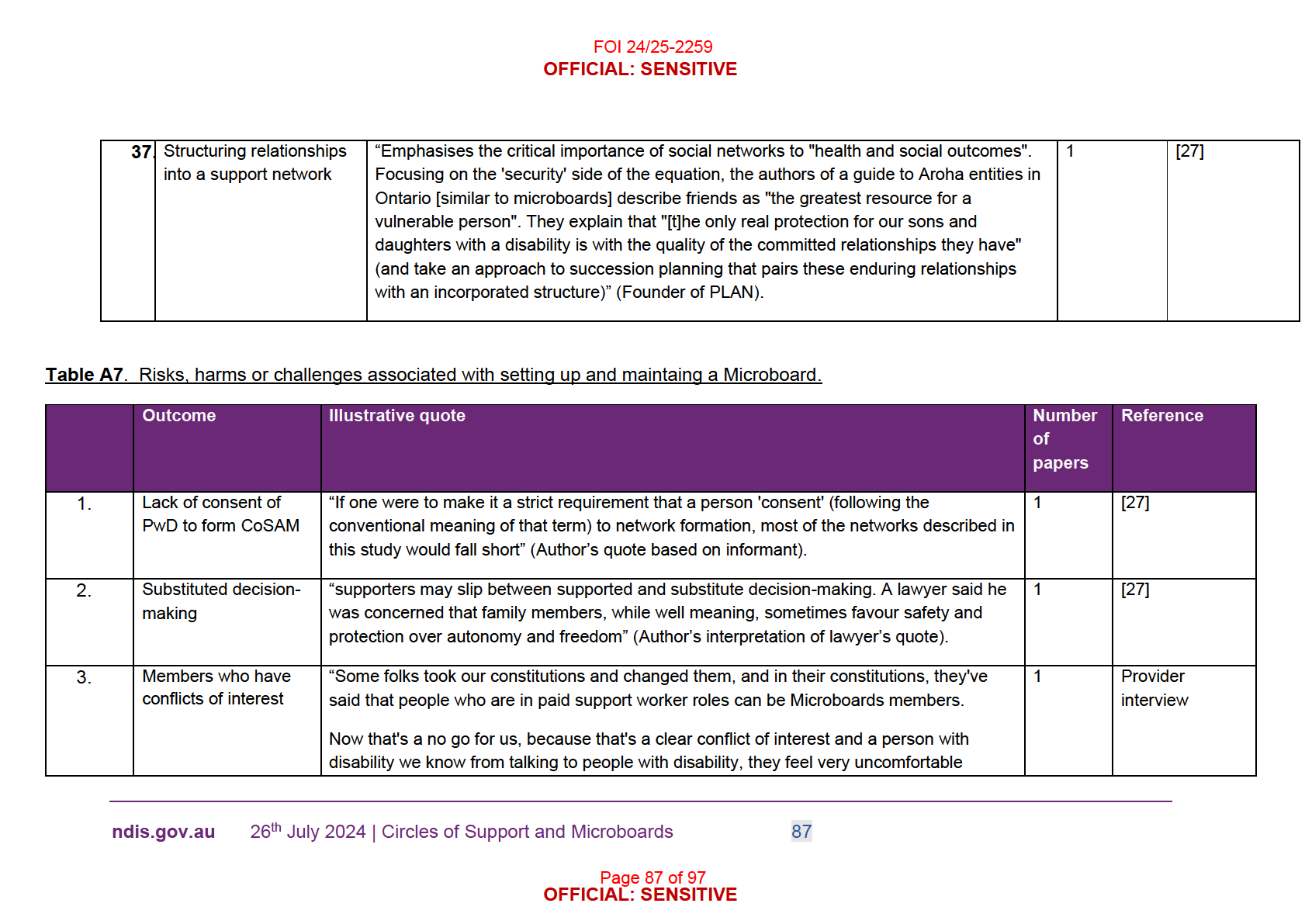
FOI 24/25-2259
OFFICIAL: SENSITIVE
talking about their support workers in front of them, or if there's a team member present
that's that's real y risky for people to do that” (Provider interview).
4.
Assumption that
“Informants recognised that some people wil not be able to 'choose (or terminate) a
1
[27]
everyone would
network in the traditional sense, but took the position that people of all levels of abilities
benefit from CoSAM
should benefit from personal support network arrangements” (Author’s interpretation of
informants quote).
5.
Difficulty of knowing
“A difficult question is the apportionment of legal responsibility for decisions made through
1
[27]
how much a PwD is
supported decision-making. Responses are to some degree linked to the model of
legally responsible for supported decision-making adopted, and the role that supporters are expected to play.
a decision when they
One approach is to say that the decision is that of the person, and that therefore that
have significant
person bears the full responsibility for the decision: critics argue that this approach can
vulnerabilities
lead to troubling moral outcomes where some persons with significant levels of
vulnerability may be liable to suffer substantial legal consequences despite not having
understood the risks associated with the decision. Another approach is to emphasise the
interdependent nature of decisions made through a supported decision-making approach”
(Law Commission in Ontario).
6.
Negative influence of
“One person, a parent, said that the supported person must choose members, and
1
[27]
family members
cautioned that family members must be very careful not to impose their preferences about
choosing members
network membership. She emphasised that the focus person may have views that diverge
from those of family members, and they may specifically want to ensure the presence of
non-family members” (Author’s interpretation of parent’s interview)
7.
Potential opportunities “One of the primary worries, even for those advocating supported decision-making, is the
1
[27]
for financial or other
potential for coercion or other inappropriate influence by a representative or supporter.
abuse even with
Exploitation and abuse certainly occur in guardianship context (although it is unclear how
ndis.gov.au
26th July 2024 | Circles of Support and Microboards
88
Page 88 of 97
OFFICIAL: SENSITIVE
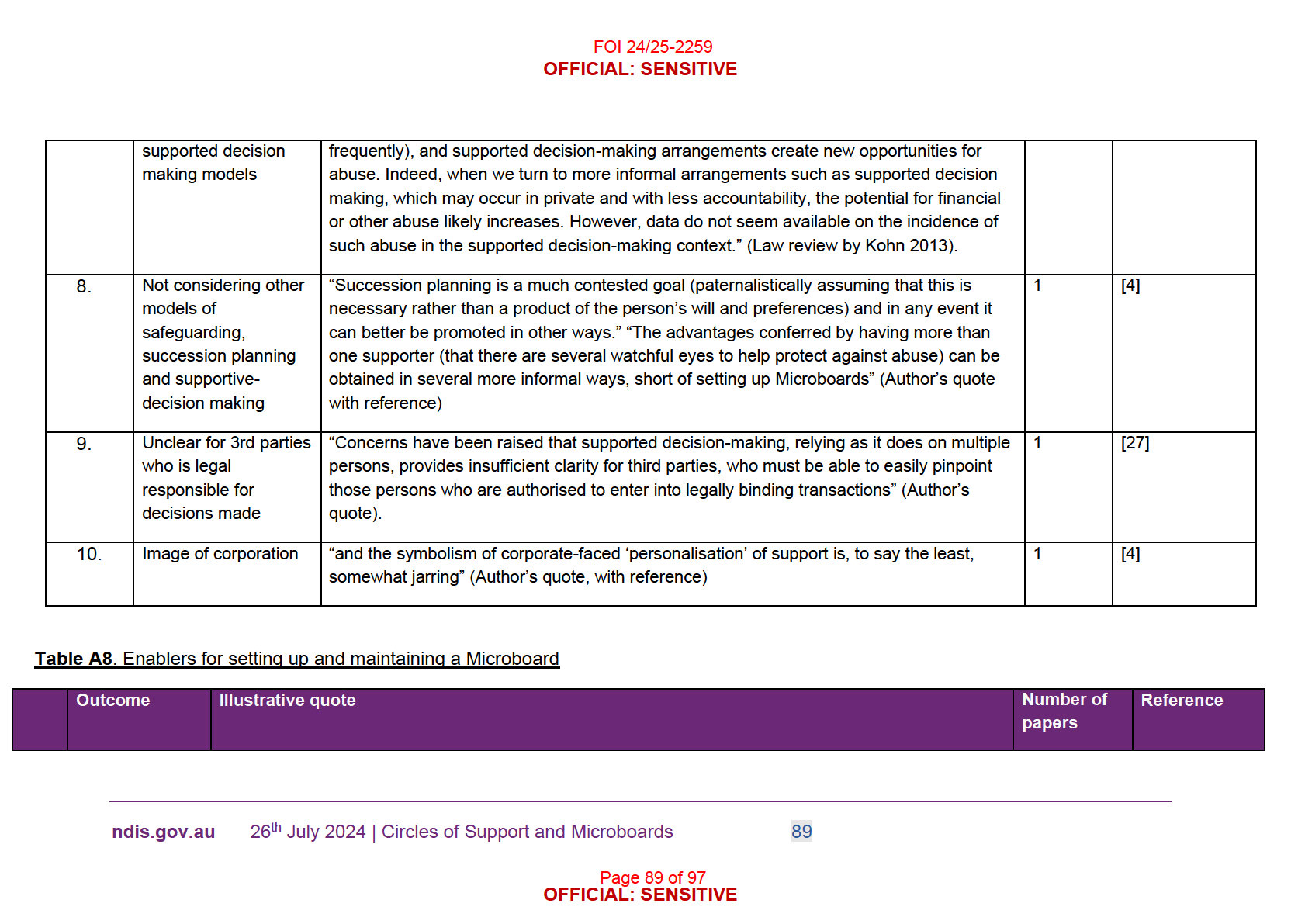
FOI 24/25-2259
OFFICIAL: SENSITIVE
1. Facilitator
"Almost all of the boards that I am aware of have reached that point….within 6 months to a year where
2
[27] [29]
support needed
things are getting real tense, people are starting to feel uncomforatable around each other, and a couple
of people want to punch each other out. And they sort of need some help, and invariably that's where I
wil hear from them again" (Facilitator)
2. PwD choose to
"She explained that before setting up a new network, she takes the focus person to another person's
1
[27]
set up
support network to help them understand what a network entails."
Microboard
3. Provider’s
"We could not do this without Vela [Canada]. I think that’s critical to mention. I had no idea how to form
1
[36]
support setting
a non-profit society or put a budget together for funding. I had a vision, a dream of what a good life
up Microboard
would look like for [the person being supported], and I could not have done this without [facilitating
organisation]’s staff walking beside us every step of the way in the early stages." (Mother)
4. Someone close
"I would have taken the initiative but it would have been a lot later (microboards). I would never believe
1
[29]
to PwD to help
it now that Lisa got it going. ….She was pushing for the microboard and getting married…" (PwD,
set up
referring to future wife who arranged MB)
Microboard
5. Microboard
The Wetherows (who innovated the first Microboards in Manitoba) have suggested that the appropriate
1
[27]
plays a similar
relationship between a Microboard and government is one in which "[t]he Microboard has the same
role as a
standing as a provider agency – it is a provider agency, for one person"
provider
6. Working with
Among Ontario networks that do receive and manage funding, they are apparently doing so as a result
1
[27]
agencies to
of creative arrangements with transfer payment agencies supportive of their objectives.
receive funding
for Microboard
ndis.gov.au
26th July 2024 | Circles of Support and Microboards
90
Page 90 of 97
OFFICIAL: SENSITIVE
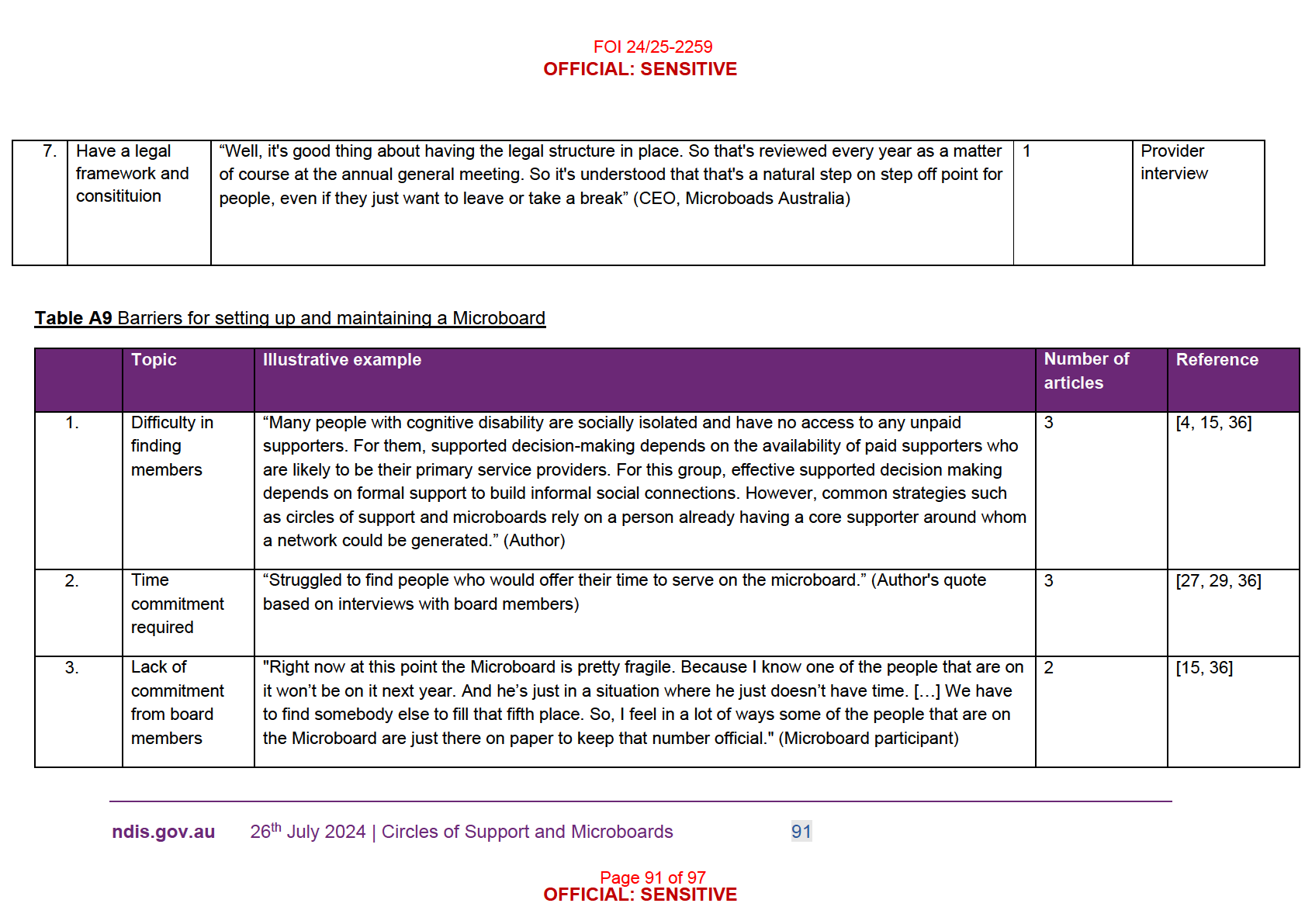
FOI 24/25-2259
OFFICIAL: SENSITIVE
4.
Administrative
“Families wil often need to hire a lawyer, and wil be faced with substantial work relating to meetings, 1
[27]
chal enges
bookkeeping, and government filings, among other issues. For already over-burdened families, this
might act as a deterrent.” (Author)
5.
Need for NDIS “Compounding the absence of a formal supported decision-making scheme, current NDIS policy
1
[4]
funding
does not allow funding of supported decision-making in a participant’s package, other than one off
funding to establish a microboard (see discussion at Sections 5.3 and 8.3.1).” (Author)
6.
Requiring a
“could be where micro board needed – legal entity – but needs to be wound up if less than 5 or 6
1
[4]
minimum of 5
people– needs a commitment”. (Family–disability)
to 6 members
7.
Funding
The informant interviews indicate that there is confusion and a lack of information about whether
1
[27]
eligibility
incorporated networks are eligible to receive funds in Ontario. Several informants said there is no
reason to incorporate a support network in Ontario because the government wil not allow it to
receive funding.
8.
Insufficient
"The number one issue is always staffing and everything flows out of that. If we had enough money
1
[15]
funding
that would be competitive with what other support people are making, then I would be able to hire
people that are more steady and there wouldn’t be the turnover and there would be more availability.
[…] The turnover rate is pretty high, even when I do a lot of things to try and attract and make it as
good as possible, it is a huge issue. That one thing alone, it pervades everything." (Microboard
participant)
9.
Management
"Several informants emphasised the difficulties that families can face when trying to set up
1
[27]
of funding and Microboards (e.g., in identifying members) and that managing funding and services is time
services
consuming and complex. For example, one informant said she preferred to give this role to a transfer
ndis.gov.au
26th July 2024 | Circles of Support and Microboards
92
Page 92 of 97
OFFICIAL: SENSITIVE
FOI 24/25-2259
OFFICIAL: SENSITIVE
payment agency (while stil having effective choice in the services provided due to an arrangement
with the agency. In general, informants wanted a range of options that could be adapted to
individuals' particular needs, not a prescriptive mode" (Author's quote based on interviews)
10.
Chal enges of
“The number one issue is always staffing and everything flows out of that. If we had enough money
1
[36]
hiring
that would be competitive with what other support people are making, then I would be able to hire
employees
people that are more steady and there wouldn’t be the turnover and there would be more availability.
[ … ] That one thing alone, it pervades everything.” (Board Member and Mother)
11.
The need to
"And I think their right, and that's why we've looked at hiring facilitators, because we started with the
1
[29]
hire a
mentoring and that wasn't working” (Facilitator)
facilitator
12.
Limited
"in both British Columbia and Ontario, incorporated and unincorporated networks alike have no real
1
[27]
authority
authority in the eyes of these third parties. Neither banks, nor health care providers, nor lawyers,
have any basis for accepting the authority of a personal support network member to represent the
decisions of another. For example, a parent in Ontario said that neither she nor others in her son's
personal support network have been able to help him open a personal bank account, as the bank
requires a guardianship order or a power of attorney."
13.
A Microboard
The advantages conferred by having more than one supporter (that there are several watchful eyes
1
[4]
is not the only
to help protect against abuse) can be obtained in several more informal ways, short of setting up
way to provide microboards.
safeguarding
14.
Questionable
The supposed greater accountability is heavily contested, and the symbolism of corporate-faced
1
[4]
that a
‘personalisation’ of support is, to say the least, somewhat jarring. Succession planning is a much
Microboard
provides
ndis.gov.au
26th July 2024 | Circles of Support and Microboards
93
Page 93 of 97
OFFICIAL: SENSITIVE
FOI 24/25-2259
OFFICIAL: SENSITIVE
greater
contested goal (paternalistically assuming that this is necessary rather than a product of the person’s
accountability
wil and preferences) and in any event it can better be promoted in other ways.
15.
A Microboard
"Microboards have been found to hold little appeal for people with mental il ness, for whom private
1
[4]
is not suitable
planning options of advance healthcare directives or supporter appointments better attune to
for everyone
aspirations of maximising control; or for people with ABI who are more likely to already have circles
of like-age informal partners/supporters; or for people with a dementia struggling to find a single
supporter, much less a pool of people.”
ndis.gov.au
26th July 2024 | Circles of Support and Microboards
94
Page 94 of 97
OFFICIAL: SENSITIVE
FOI 24/25-2259
11. References
1.
Department of Health – Victoria.
Person centred practice. 2015; Available from:
https://www.health.vic.gov.au/patient-care/person-centred-practice.
2.
Association, A.B.
Supported Decision-Making. Available from:
https://www.americanbar.org/groups/law aging/resources/guardianship law practice/support
ed-decision-making/.
3.
Alston, B.,
Towards supported decision-making: Article 12 of the convention on the rights of
persons with disabilities and guardianship law reform. Law in Context, 2017.
35(2): p. 21-43.
4.
Bigby, C., et al.,
Diversity, dignity, equity and best practice: a framework for supported
decision-making., A. Royal Commission into Violence, Neglect and Exploitation of People with
Disability, Editor. 2023: Australia. p. 434.
5.
NDIS,
NDIS Supported Decision Making Policy. 2023. p. 34.
6.
Australia, C.o.,
Working together to deliver the NDIS. Independent Review into the National
Disability Insurance Scheme. 2023, Australian Federal Government, Department of the Prime
Minister and Cabinet: Australia.
7.
van Asselt‐Goverts, A., P. Embregts, and A. Hendriks,
Social networks of people with mild
intel ectual disabilities: characteristics, satisfaction, wishes and quality of life. Journal of
Intel ectual Disability Research, 2015.
59(5): p. 450-461.
8.
Despott, N., et al.,
Circles of Support and Microboards: Person-centred, efficient models for
capacity building, supported decision making, and enfranchisement., in
A Submission to the
NDIS Review Committee, August 2023. 2023, Circles of Support and Microboard.org.au:
Australia. p. 1-8.
9.
Shea, J.
A definition of microboards.
. 2001; Available from:
http://www.dimagine.com/page20.htm7.
10.
Browning, M., C. Bigby, and J. Douglas,
Supported decision making: Understanding how its
conceptual link to legal capacity is influencing the development of practice. Research and
Practice in Intel ectual and Developmental Disabilities, 2014.
1(1): p. 34-45.
11.
Commission, A.L.R.
Supported and substituted decision-making. 2014; Available from:
https://www.alrc.gov.au/publication/equality-capacity-and-disability-in-commonwealth-laws-
dp-81/2-conceptual-landscape-the-context-for-reform/supported-and-substituted-decision-
making/.
12.
Jay, L.,
Circles of Support and Microboards Review: Building Community Networks with
Belonging Matters, Sotica, Editor. 2018, Belonging Matters: Melbourne, Australia. p. 31.
13.
Laurens, J., et al.,
Good practice in supported decision-making for people with disability. 2021.
14.
Office of the Public Advocate (Vic),
Walk with me, talk with me: A practice guide for OPA staff.
2018.
15.
Stainton, T., et al.,
Microboards™, social capital and quality of life. 2020, University of British
Columbia, Canadian Institute for Inclusion and Citizenship.
16.
Taylor, S., et al.,
The role of microboards in enhancing quality of life for children with
intel ectual disability and their families. Journal of Policy and Practice in Intel ectual
Disabilities, 2023.
17.
Taylor, S., et al.,
Microboards for children project. 2022.
18.
COSAM.org,
Research and evaluation summary Academic Research and Professional
Evaluation of Circles of Support & Microboards – COSAM. 2023. p. 19.
19.
Wistow, G., et al.,
Circles of support and personalization: Exploring the economic case. Journal of Intel ectual Disabilities, 2016.
20(2): p. 194-207.
20.
Bigby, C. and T. Araten-Bergman,
Models for forming and supporting circles of support for
people with intel ectual disabilities. . 2018, Living with Disability Research Centre, La Trobe
University.
21.
Lockman Turner, E., et al.,
Circles of support and self-direction: An interview highlighting a
journey of friendship and managing services. Inclusive Practices, 2022.
1(2): p. 75-78.
Page 95 of 97
FOI 24/25-2259
OFFICIAL, OFFICIAL: SENSITIVE, or UNOFFICIAL
22.
Bigby, C.,
Dedifferentiation and people with intel ectual disabilities in the Australian National
Disability Insurance Scheme: Bringing research, politics and policy together. Journal of
Intel ectual and Developmental Disability, 2020.
45(4): p. 309-319.
23.
Araten-Bergman, T. and C. Bigby,
Forming and supporting circles of support for people with
intel ectual disabilities—A comparative case analysis. Journal of Intel ectual and
Developmental Disability, 2022.
47(2): p. 177-189.
24.
Watson, J.,
The right to supported decision-making for people rarely heard. 2016, Deakin
University.
25.
Health, O.D.M.
Circles Of Connection. 2023; Available from:
https://www.onedoor.org.au/news-updates/research/circles-of-connection-project-findings.
26.
Fong, V., E. Gardiner, and G. Iarocci,
Satisfaction with informal supports predicts resilience in
families of children with autism spectrum disorder. Autism, 2021.
25(2): p. 452-463.
27.
Nunnelley, S.,
Personal support networks in practice and theory: asesssing the implication for
supported decision-making law. 2015: Commissioned by the Law Commission of Ontario.
28.
Gold, D.,
Attempts to create friendship in the lives of students with disabilities: The case of
'circles of friends'. 1996, ProQuest Information & Learning. p. 0638-0638.
29.
Malette, P.,
Lifestyle perspectives of person's with disability in a person-centered support
program, in
Department of Educational Psychology and Special Education. 1996, University
of British Columbia: British Columbia. p. 294.
30.
Kohn, N.A., J.A. Blumenthal, and A.T. Campbel ,
Supported decision-making: A viable
alternative to guardianship. Penn St. L. Rev., 2012.
117: p. 1111.
31.
Diller, R. and L. Salzman,
Stripped of Funds, Stripped of Rights: A Critique of Guardianship
as a Remedy for Elder Financial Harm. U. Pa. JL & Soc. Change, 2021.
24: p. 149.
32.
Heller, T. and J. Caldwel ,
Supporting aging caregivers and adults with developmental
disabilities in future planning. Mental retardation, 2006.
44(3): p. 189-202.
33.
Cocks, E.,
Review of the quality achievements by five Microboard organisations in Australia. ,
N.R.C.f.C.O.S.A.M.C.a.I. Melbourne, Editor. 2018. p. 26.
34.
Bigby, C.,
Programs and Practices to Support Community Participation of People with
Intel ectual Disabilities, in
Handbook of Social Inclusion: Research and Practices in Health
and Social Sciences, P. Liamputtong, Editor. 2022, Springer International Publishing: Cham.
p. 695-727.
35.
Jay, N.,
The Circles Network CREDO Project. Support for Learning, 2003.
18(1): p. 24-28.
36.
Morris, R., et al.,
The impact of microboards on social and community inclusion of adults with
intel ectual and developmental disabilities: “To not just exist, but to truly live”. Research and
Practice in Intel ectual and Developmental Disabilities, 2024: p. 1-11.
37.
Nuri, R.P., et al.,
The Limits and Contributions of Formal Support: Service Providers’
Perspectives on Balancing Formal and Natural Support for People with Disabilities and their
Families in Canada. Journal of Developmental and Physical Disabilities, 2024: p. 1-28.
38.
Rother, N.,
Reaching Out. A portrait of Social Network Facilitation in Canada. 2012, PLAN
Institute for Citizenship and Disability.
39.
Rowlands, A.,
Circles of support building social networks. British Journal of Therapy &
Rehabilitation, 2002.
9(2): p. 56-65.
40.
Ruth Ryan, R.,
‘Interactional Guesstimating’: Family carers’ experiences supporting
profoundly intellectually disabled persons in decision-making-a constructivist grounded
theory. 2019.
41.
Spagnolo, A.B., et al.,
A study of the perceived barriers to the implementation of circles of
support. Psychiatric Rehabilitation Journal, 2011.
34(3): p. 233-242.
ndis.gov.au
XX Month 20XX | Paper Title
96
OFFICIAL, OFFICIAL: SENSITIVE, or UNOFFICIAL
Page 96 of 97
FOI 24/25-2259
OFFICIAL, OFFICIAL: SENSITIVE, or UNOFFICIAL
National Disability Insurance Agency
ndis.gov.au
Telephone 1800 800 110
Webchat ndis.gov.au
Fol ow us on our social channels
Facebook, Twitter, Instagram, YouTube, LinkedIn
For people who need help with English
TIS: 131 450
For people who are deaf or hard of hearing
TTY: 1800 555 677
Voice relay: 1800 555 727
National Relay Service: relayservice.gov.au
ndis.gov.au
XX Month 20XX | Paper Title
97
OFFICIAL, OFFICIAL: SENSITIVE, or UNOFFICIAL
Page 97 of 97
































